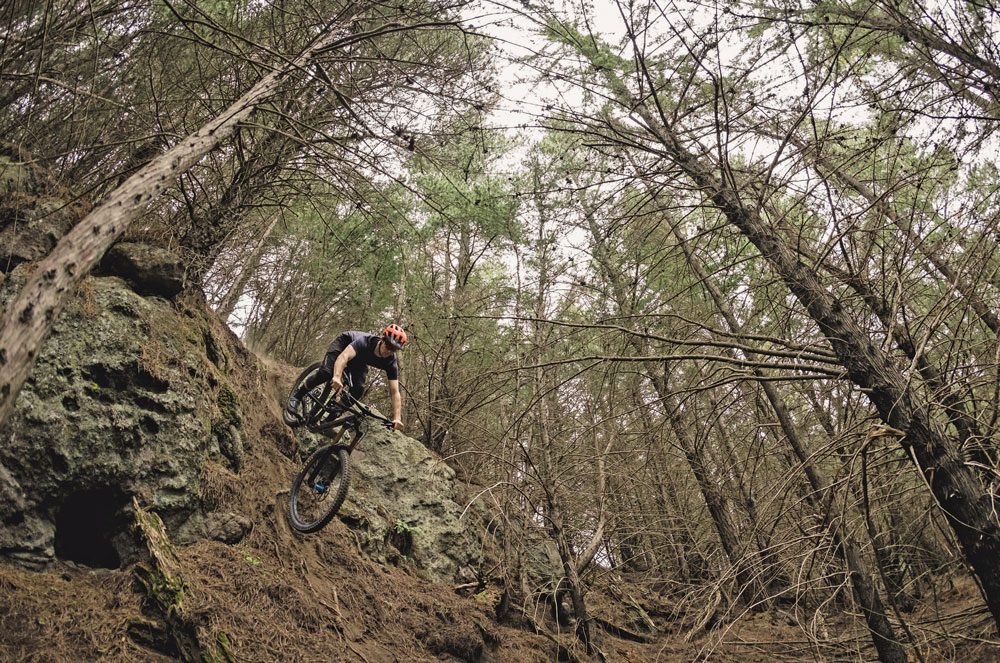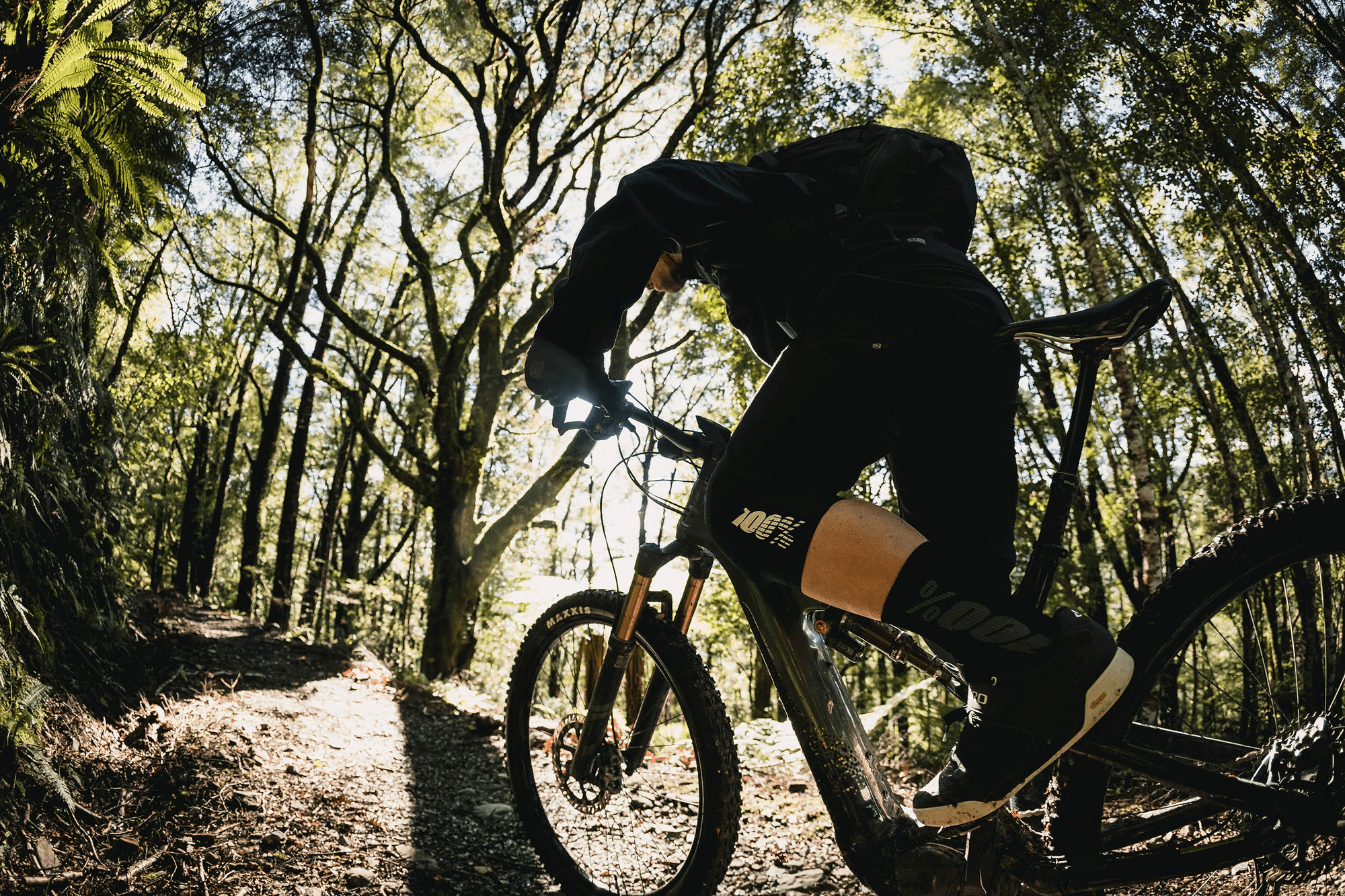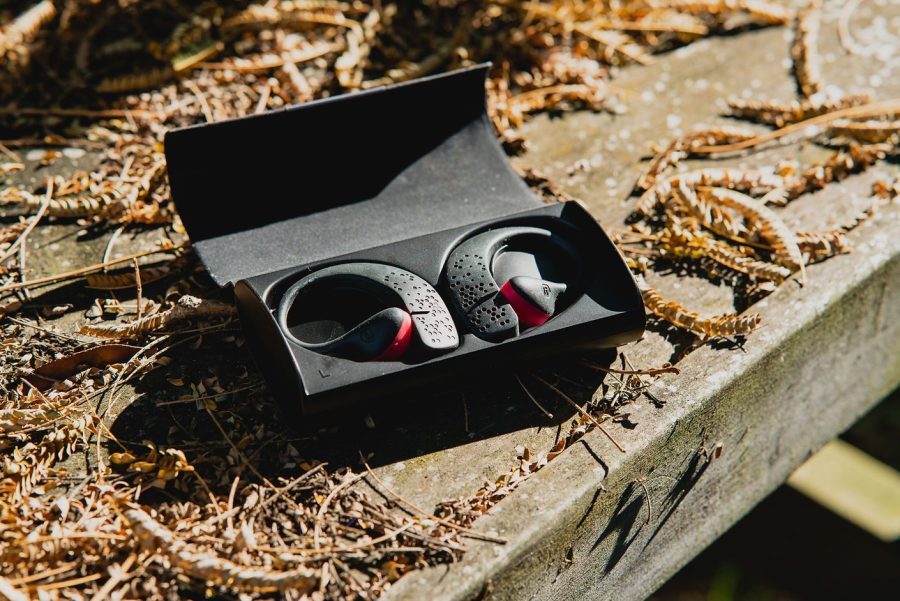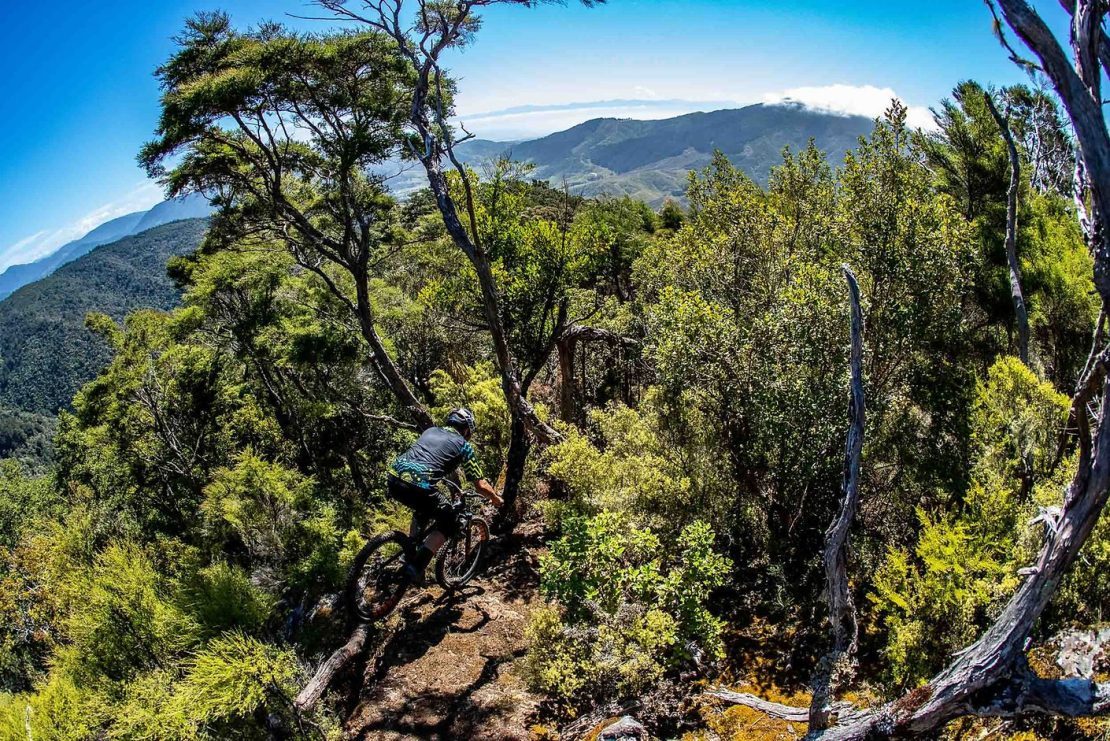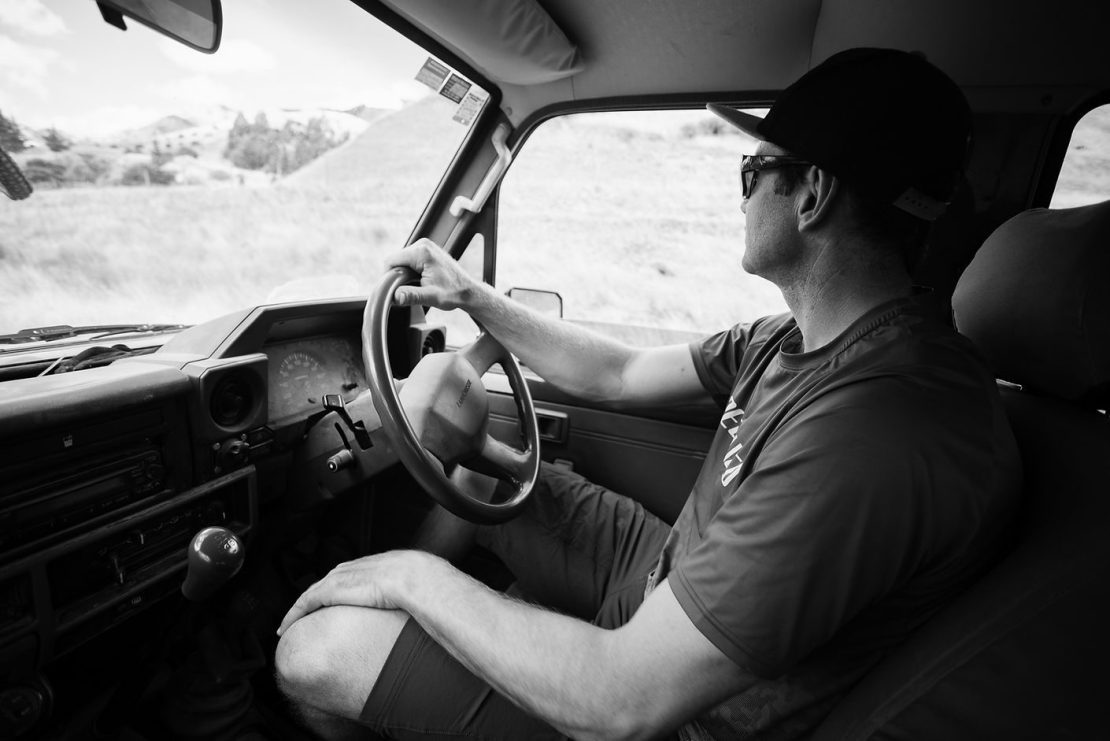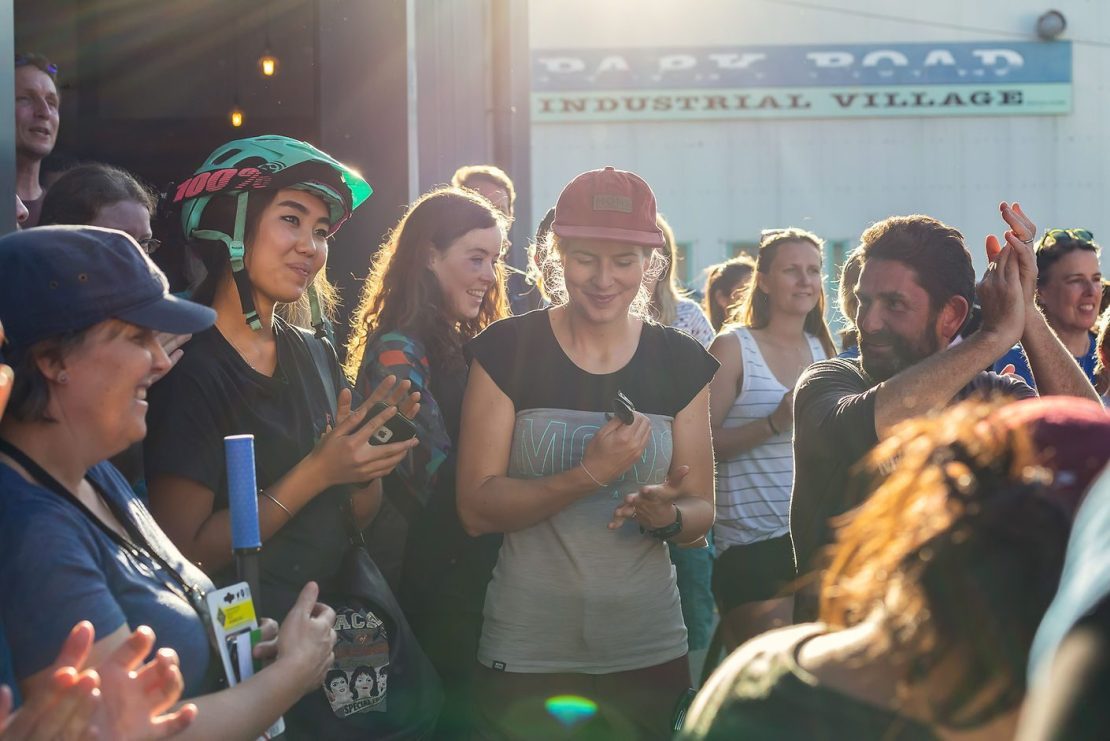Feature: No Reservations
We all dream of riding trails straight out of our front door. The reality is, though, that’s a luxury few of us have, unless we’ve set our lives up in one of a few towns where it’s possible. For most of us, there’s either a ride on the road, or a car journey, before we can get our trail fix. Nowadays, however, the accessibility of car camping and campervan setups means it’s possibly to literally wake up and ride right from your front door. And, that front door could be in a new location every day – or even multiple places in one day.
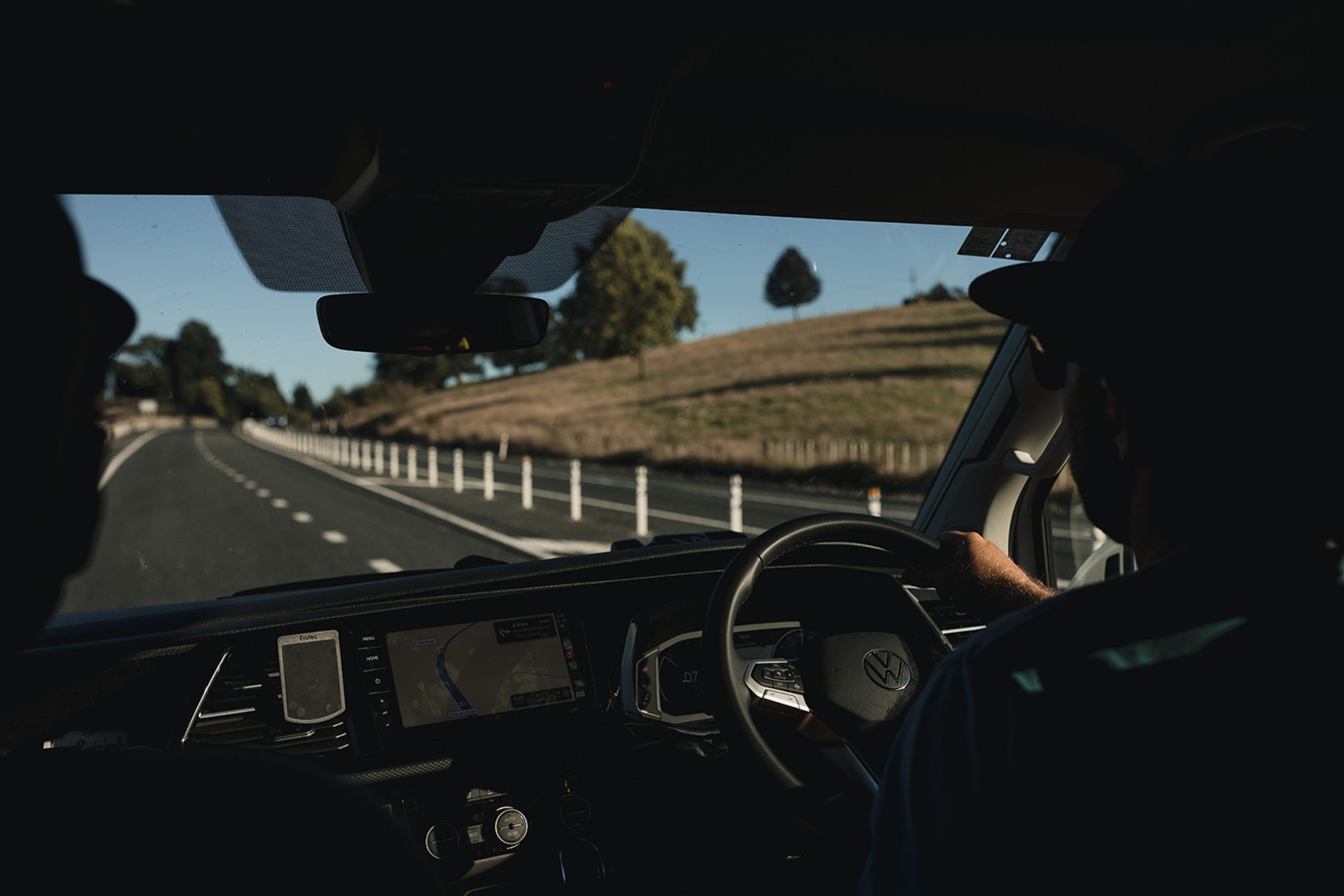
Our home away from home rolled up the driveway; a shiny new VW California. The middle offering in the all-new California range, this campervan gives serious modern-day Kombi vibes. With an electro hydraulic pop-up roof and roof bed, plus a self-contained kitchen, there was ample room for us to sleep, eat and chill in between rides.
Bags in the back, bikes on the rack, a couple of espresso shots from the home machine and we were ready to roll. “Where are we off to then?” was the question. We’d made no real plan and with the van being our kitchen, sleeping quarters, chill zone and changing room we needed no reservations of any sort. We had a vague direction to head, and a time we needed to be home, but between then and now, the itinerary was pretty loose – actually, it was non-existent. As we headed towards our ‘loose’ destination of the Coromandel Peninsula, we knew our plan would take shape and unfold as it needed to.
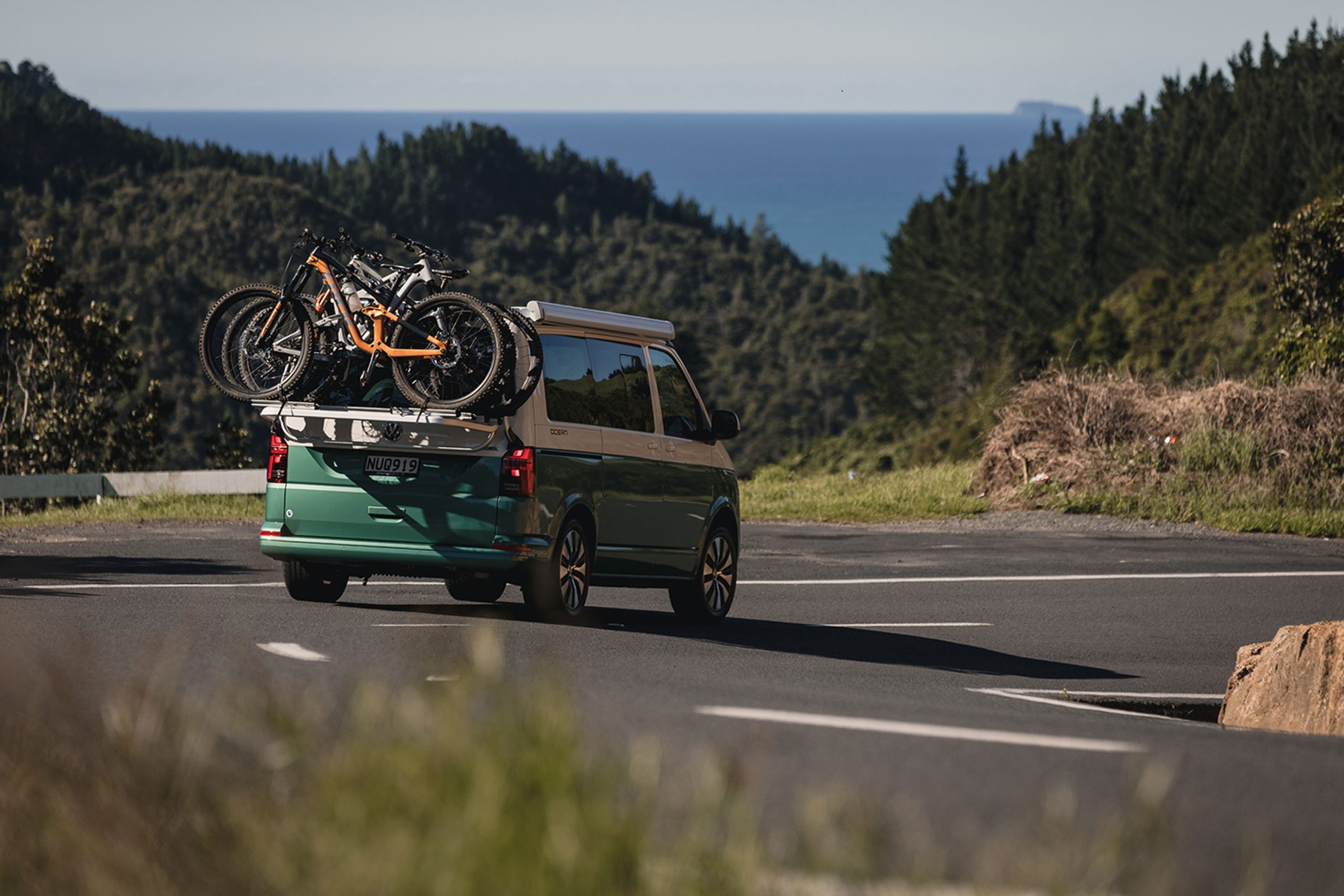
After some discussion, we decided to head to the town of iconic thermal mineral spas and a big ass mountain: Te Aroha would be our first stop and we were there for a good time, not a long time. Having ridden the ‘Gum ta Native’ trail eight or so years ago, I was keen to go back and see if it had seen any updates. NZ’s endless summer was in full effect and within minutes of beginning our climb two things were obvious: one – we should have been at a beach somewhere, as it was too hot; and two – with an almost-clear blue sky, the sun was piercing through the bush canopy meaning capturing any good photos was going to near impossible, i.e. a MTB photographer’s worst nightmare. We continued our climb up, with intentions to get to the high point of the trail and descend back down the way we’d come. The trail seemed to be smoother than I remembered – maybe it had been cleared of rocks, maybe it had been mellowed due to the amount of traffic over the years, or maybe it was just because I was now aboard a 160mm travel 29er, not a 120mm travel 26” wheeled steed?
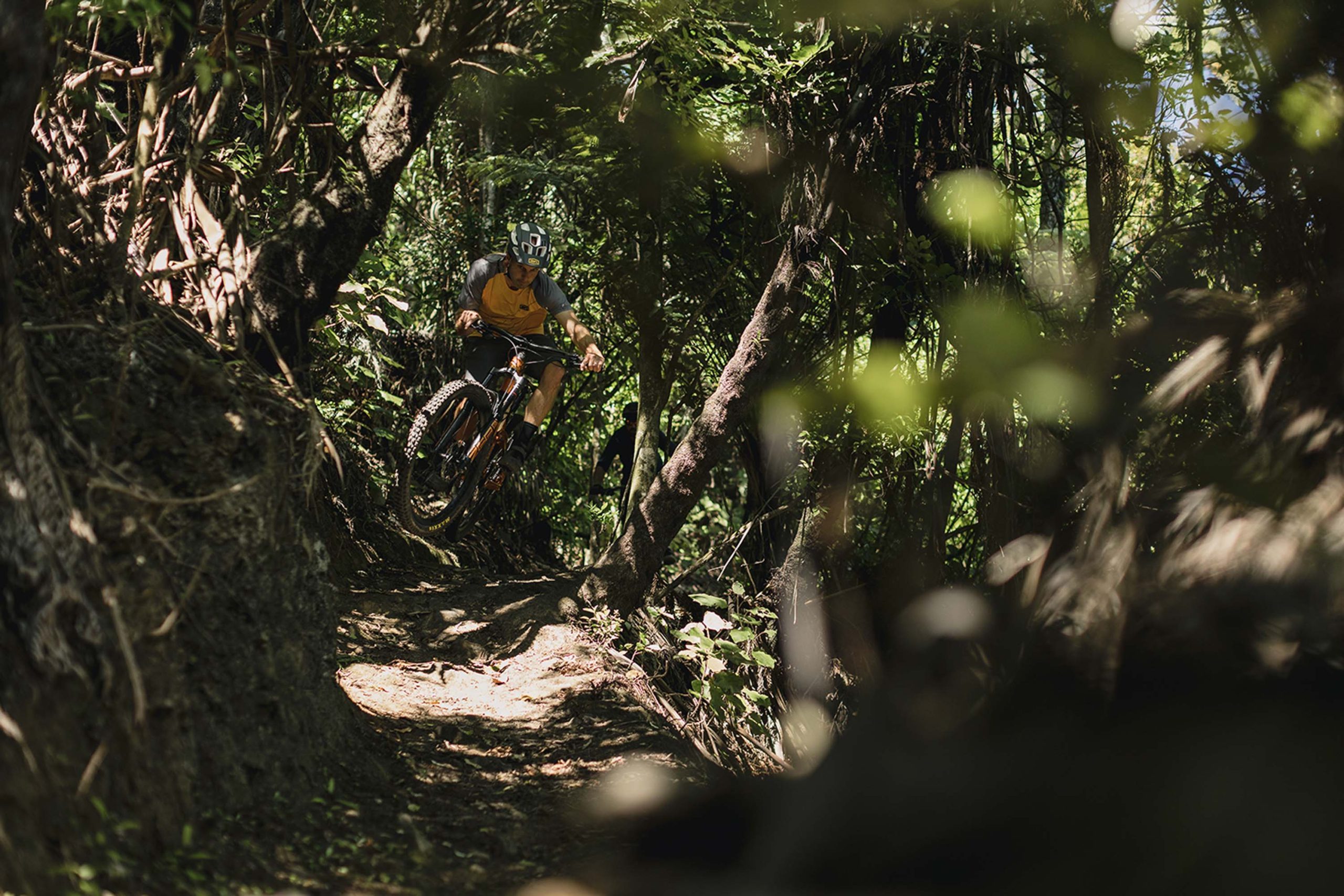
Two thirds of the way up the hill we decided it was a bust; the juice simply wasn’t worth the squeeze. Rigs turned 180, lockouts off and down we went. Descending was a blast: some fun, flowing turns, a couple of little bridge features, a few foot-out-flat-out moments, a couple of scarily tight trees, and suddenly we were back at the van, albeit a lot sweatier than when we left.
“What’s next?” “Ice-cream, surely?!”
“Yeah boi!”
A minute later were back in the centre of town choosing which Tip-Top flavour would hit the spot, then back in the van for some shade and chill time before we headed off. Maybe there are some hidden nuggets of trail hidden somewhere in the Domain Reserve (we know there is further up the hill outside of the domain, but our lips are sealed), and given more time to explore – or a local guide – we may have found some, but we would need more time to find that out. The trails have gone the way of the miners in the 1880’s, in that they have been somewhat forgotten about as time has marched on. I’m picking that, as Te Aroha is a small town, with an even smaller riding community, there’s a lack of interested parties to further develop what could be a MTB destination on par with some impressive small-town parks around the country. For now, though, it’s worth a quick stop if you’re passing through, if for nothing else other than an ice cream and a dip in the thermal baths.
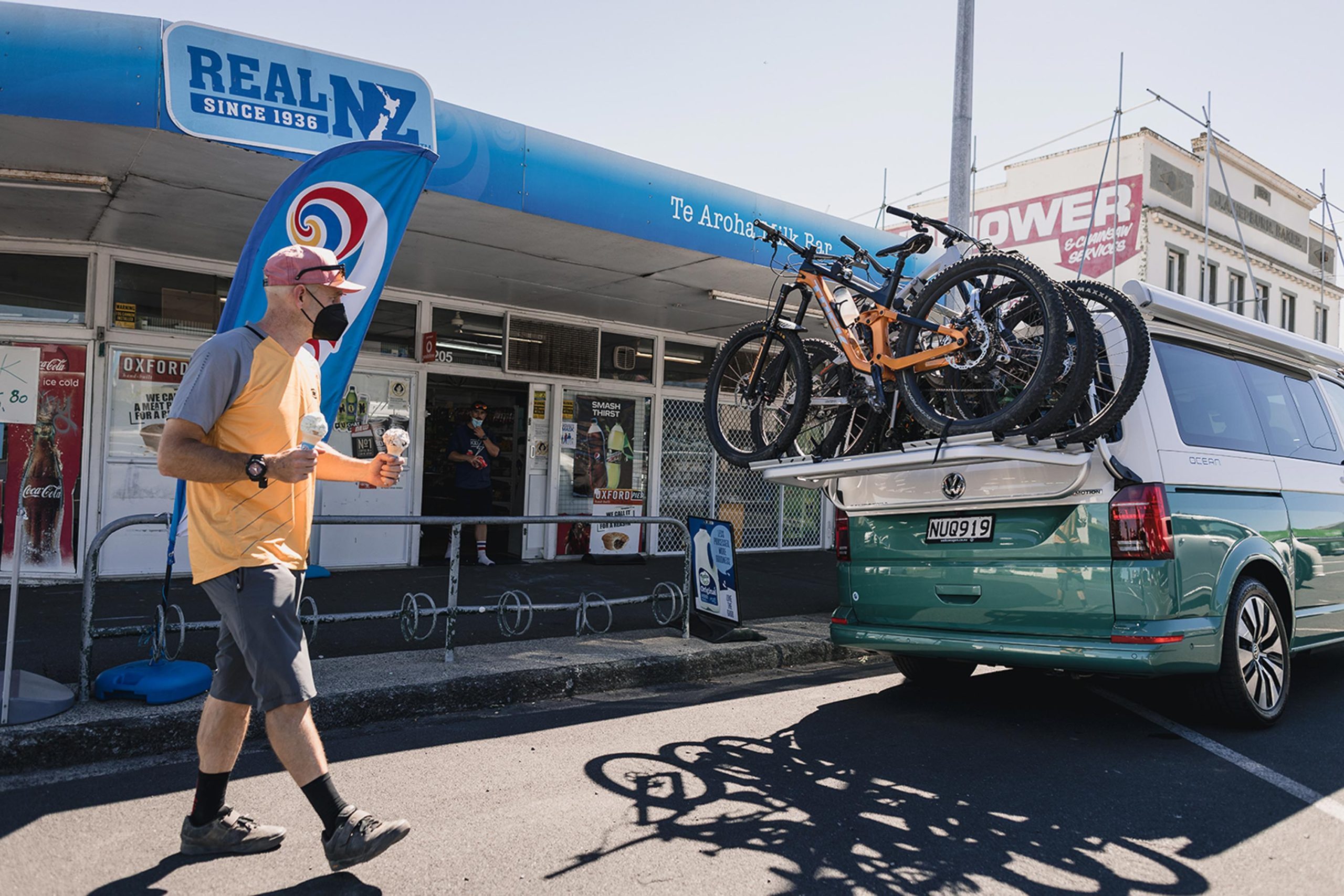
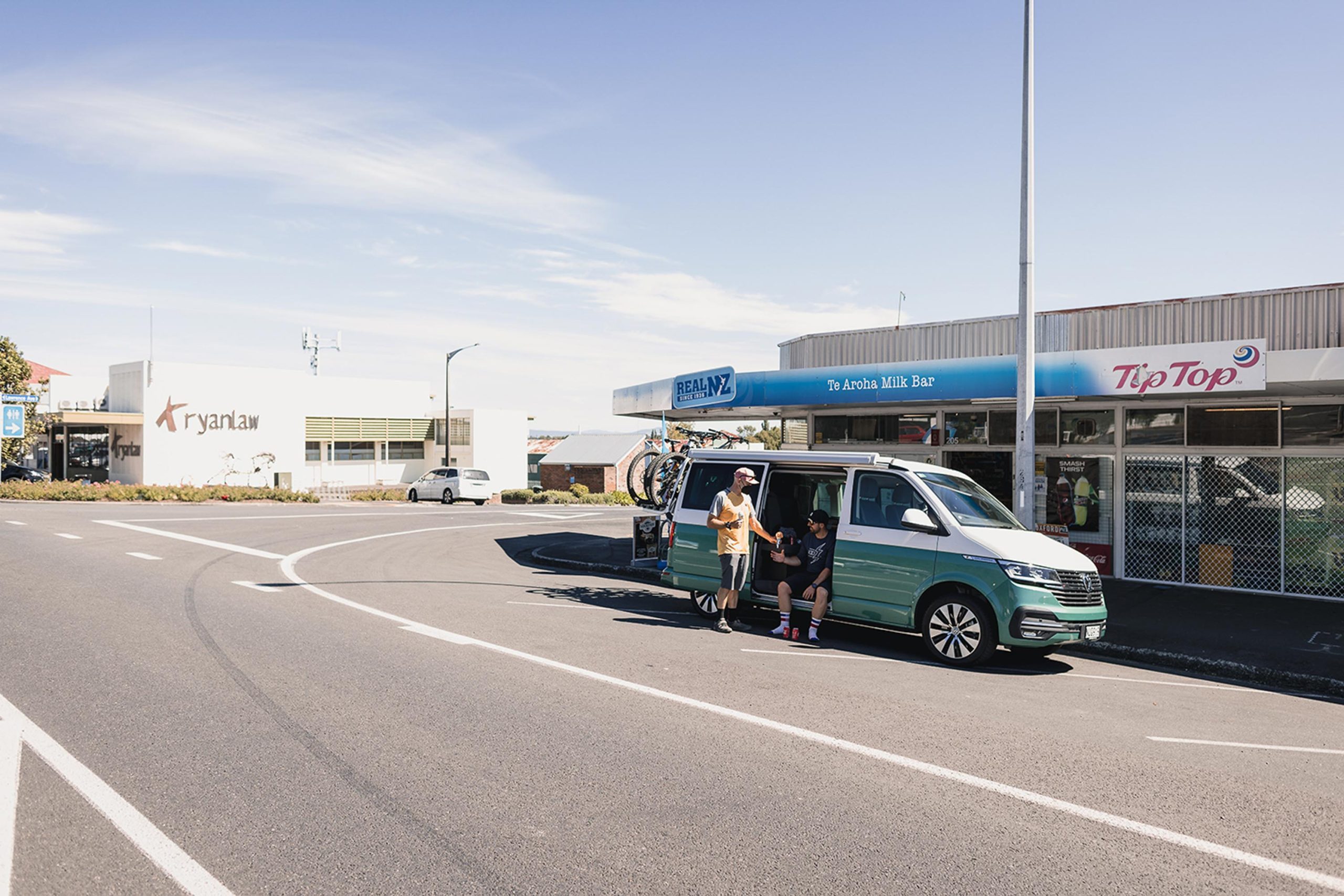
Back on the road, we’d decided Whangamata could be the go – again, a spot I’d ridden a number of years ago. With rumours that some trails had been refreshed recently – but also of logging activity in the area – we weren’t quite sure what we were in for. Regardless, the stoke was high. With the trails off limits until 5pm, due to logging, we took a quick drive to check out where our coffee the following day could be found and hitthe supermarket for supplies. Much like our entire trip, we had no plan for food. Fortunately New World had a handful of recipe cards conveniently located by the door. Recipe cards in-hand, the three of us went separate ways, loading up and reconvening at the checkout with our dinner ingredients sorted.... although we still didn’t know quite where we’d be cooking it.
Arriving at ‘Fred’s Carpark’ we unhitched the bikes, checked the map board, ensured we didn’t get tangled up with the logging, and off we went. With limited time before sundown, we figured the best plan was to scope some spots, shoot what we could, hopefully bag a golden sunset shot or two, then return the following morning for more.
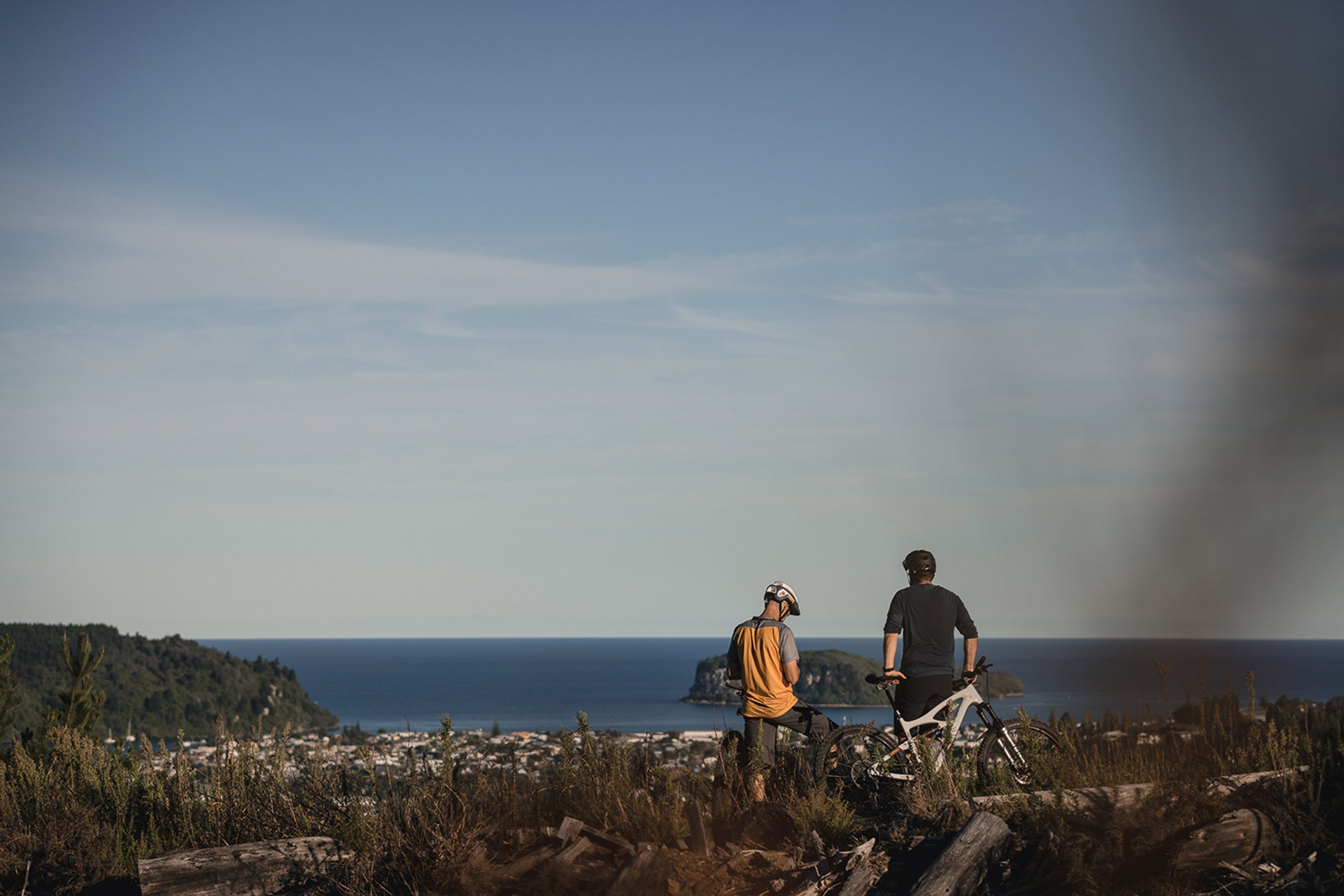
Trail names at the Whangamata Ridges MTB Park hark back to the surfing roots of the town, with many having surf related or marine-centric names: Pipeline; Over the Falls; and Aqualung, to name a few. Working our way up the hill, the light was looking a little better than Te Aroha, but photo-man-Cam was still not stoked. I was, though; I’d ridden here before but back then the trees were about as tall as I was, now they’re many times my height (and I haven’t grown at all!). With the tree cover comes better dirt; what was oncerain-rutted and dry-as-a-bone is now nicely packed, at times blue-groove, and on the day we rode, perfect!
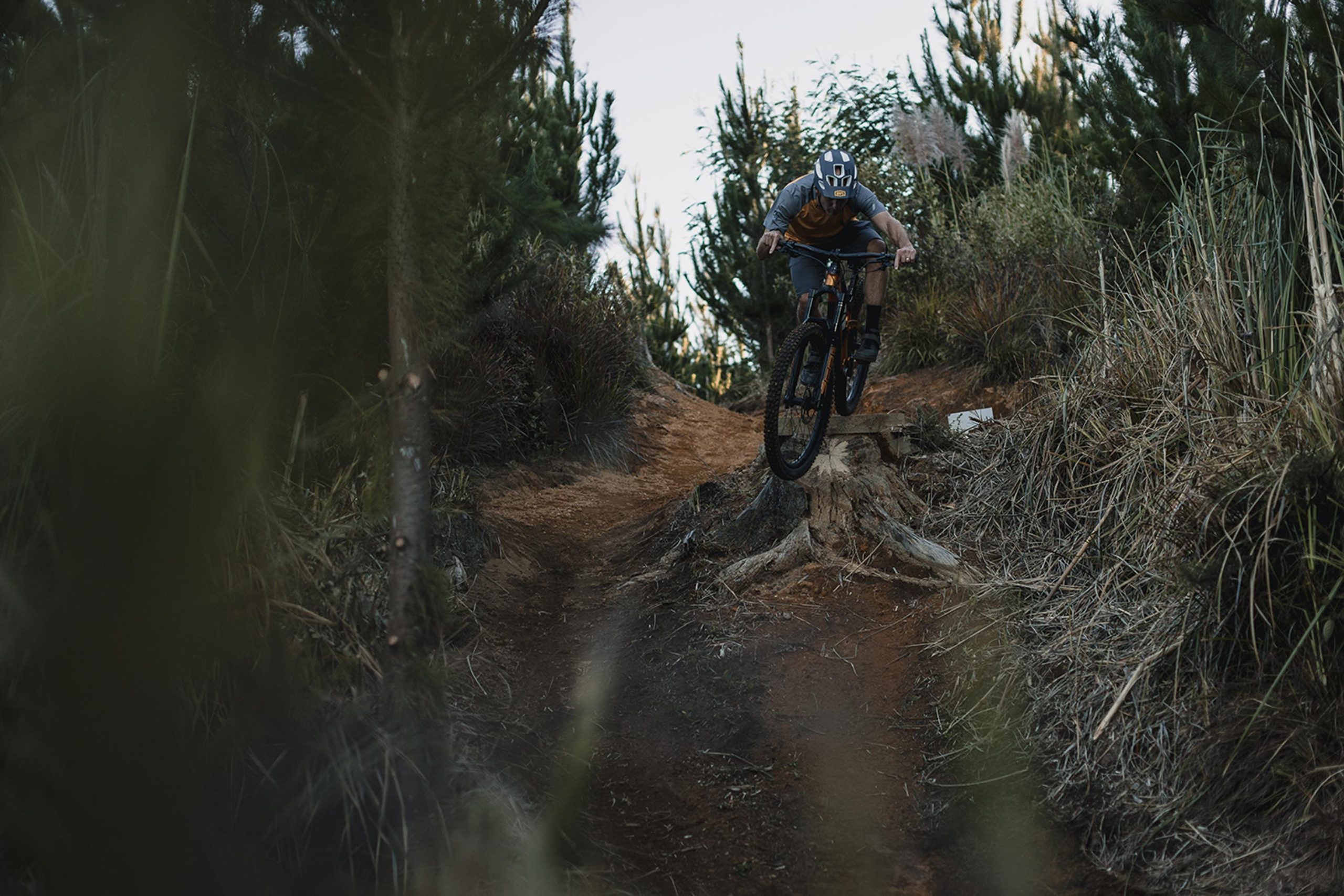
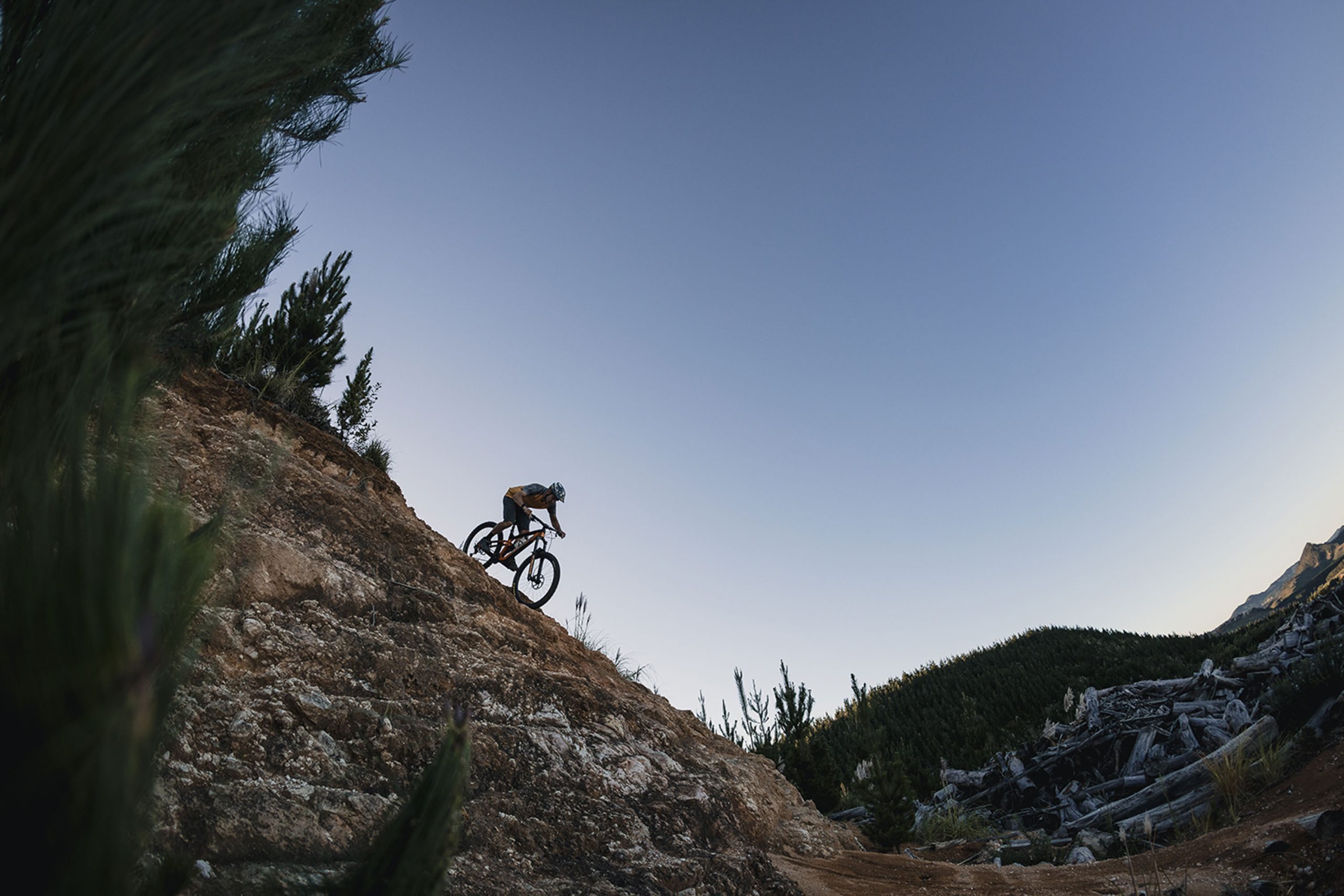
The climb up was a cinch; a wide and well-graded trail wound its way to the upper slopes of Causeway Road, which dissects the core trails of the park. Unfortunately, the trails deeper in the park were off limits, so we concentrated our efforts on cutting quick laps up and down each side of Causeway Road. First pop was Tube Cruiser, a Grade 5 flow trail with some sweet jumps and berms, all pretty crisp! The curse of the dappled light was following us around again, so we shot back up Aqualung, this time to check out the view from near the highpoint of Causeway Road. As we climbed, the unsightly pile of logging/the view rolled out over the green of grown pine, across the town and out to sea; a stunning sight ignited by the late afternoon sun. Taking note of the situation, we knew we were on borrowed time and it would soon be sundown.
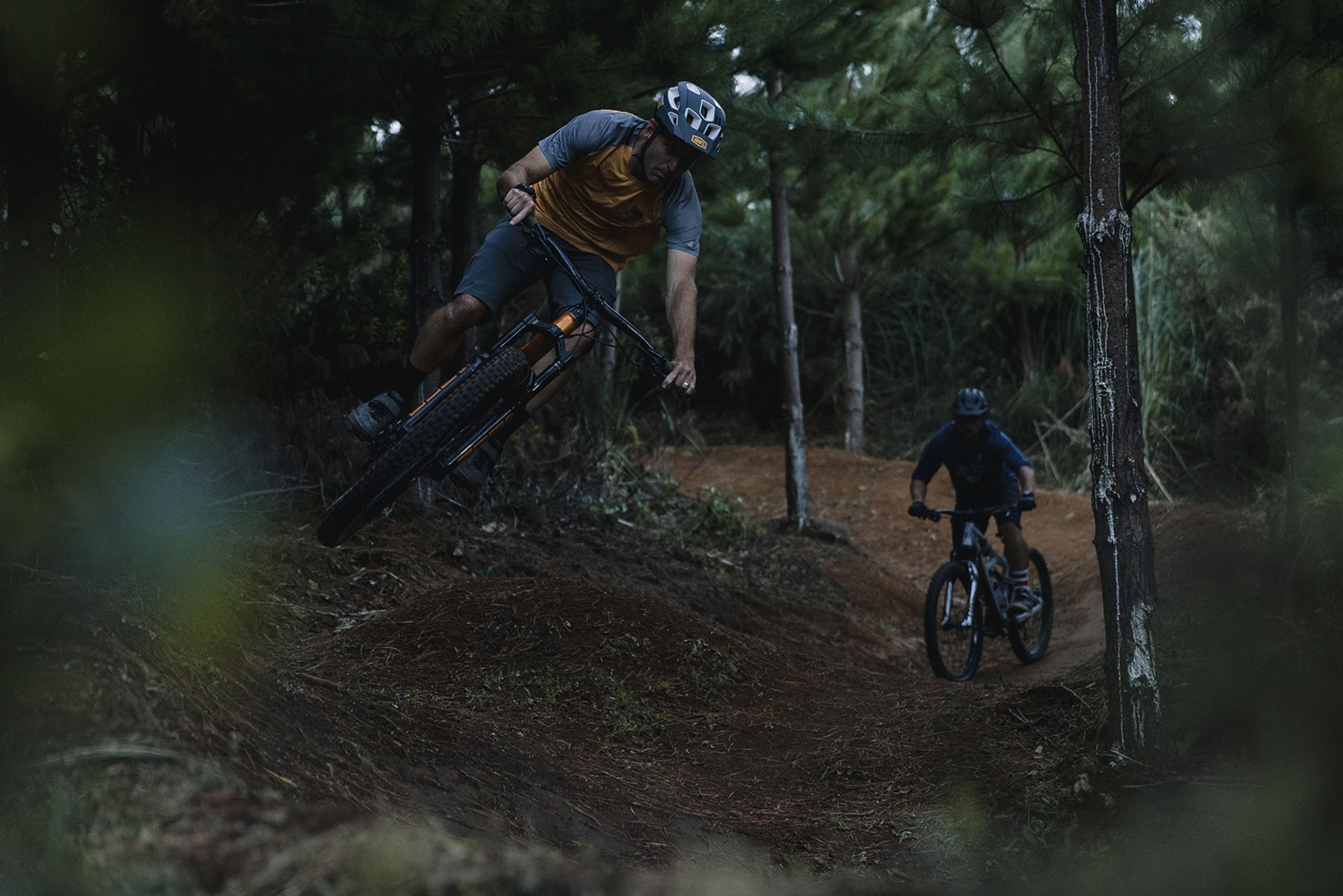
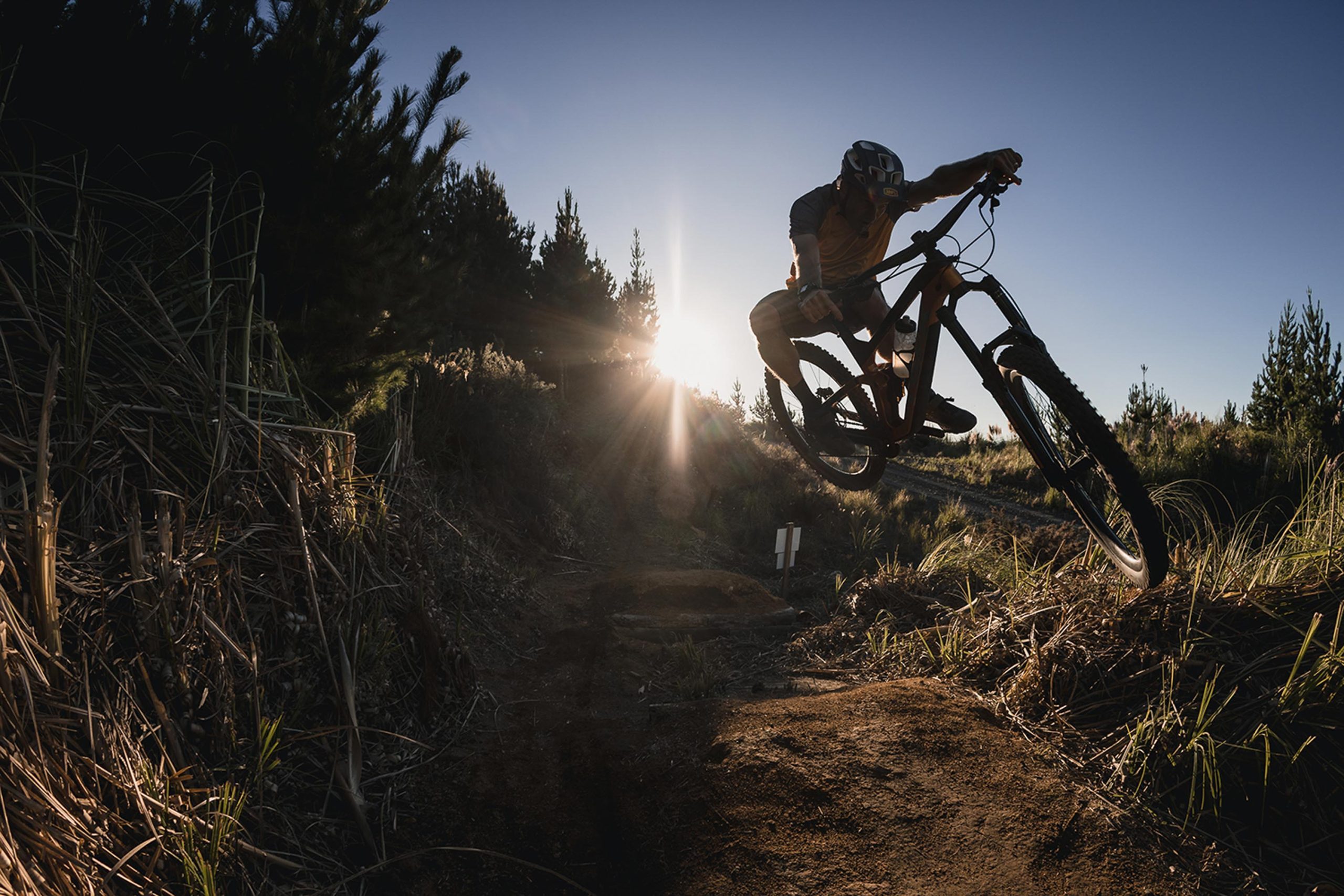
We hooked into Just Saying, a short n’ sweet number with the main feature being a nice floaty gap jump. With the sun just in the right spot, I got to work trying to make it look like I knew what I was doing on the bike, and Cam got his shutter finger working (it’s just point and shoot right?!). A few hits later and we were done. Popping onto the road, we headed up to No Bull for a gander at its infamous final feature: the rock-roll. Not highly technical, but not entirely straightforward, take the wrong line and you’re in for a rough ride. The rightline was just the right blend of steep and sketchy. “Guys, guys, guys – turn around and ride up that bit again!” You know something serious is going down when the photographer gets this excited. Liam and I did what we were told; riding and re-riding a few sections of climbing trail, unsure what all the fuss was about. Cam showed us some of the shots and we could finally see what it was all about! Like the miners who once explored these hills, we’d struck gold: photographic gold. The light was perfect, as was the scene; Liam and I did our job adequately, and that was a wrap.
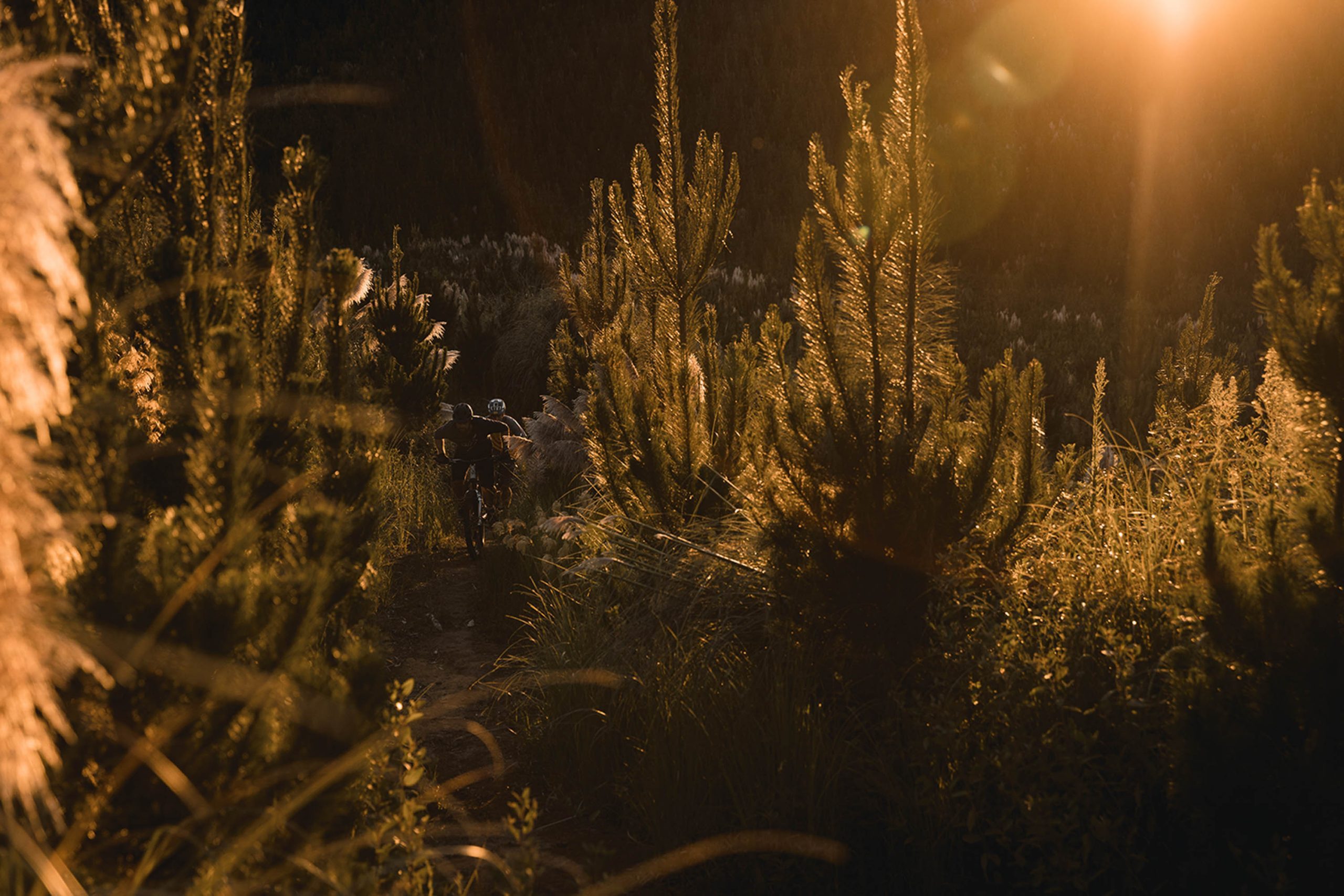
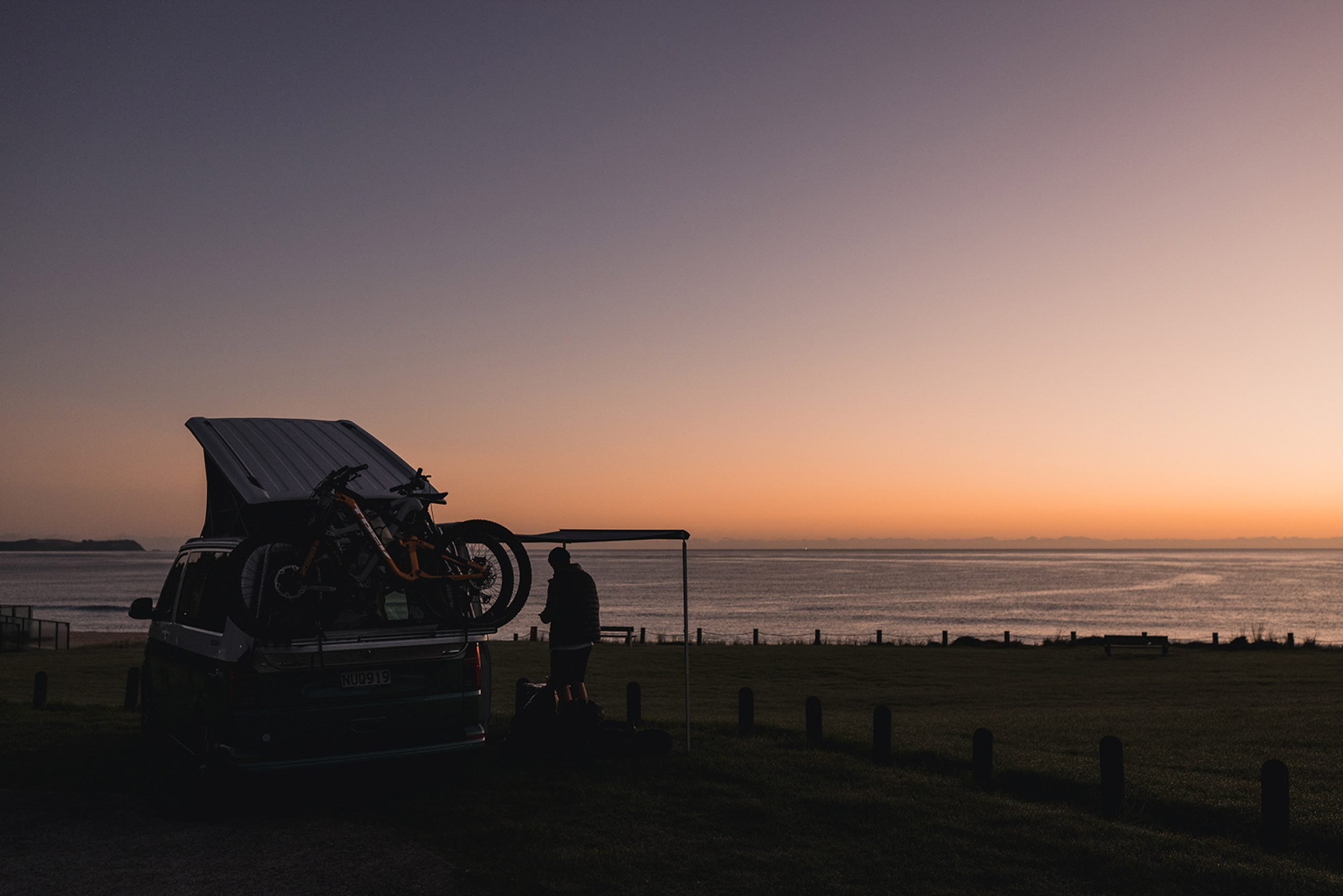
Back at the van, we cracked a coldie and reflected on our day: the ground we’d covered, the challenges and the wins. It was dark, we had nowhere to be, but we were hungry, and we did need to find a spot to park up for the night. Fortunately, there are a number of freedom camps around Whangamata and its surrounding areas. We didn’t want just any camp spot, though, we needed the perfect spot.
After operating multiple phone apps, and seemingly an hour of driving around in circles (I did mention we had no plan), we found the ideal spot. Setting up the California for the night was super simple – it took no more than five minutes to get the roof (and extra bed) up with an auto switch. We got the awning out and flicked the driver and passenger seats around inside to give us a comfortable indoor space for the evening. This functionality ensures the California is the perfect base camp in any kind of weather! Mood lighting was the icing on the cake, giving our setup a homely ambiance. The best thing about the campervan is that – unlike camping – we knew we just had to put everything back in its place the next morning when we were ready to head off; no tent pegs to pull out or ground sheets to roll up and repack – that’s a huge win! The nostalgic vibes of this camper may make heads turn, but it’s the ultra-modern specs and features that really make it shine.
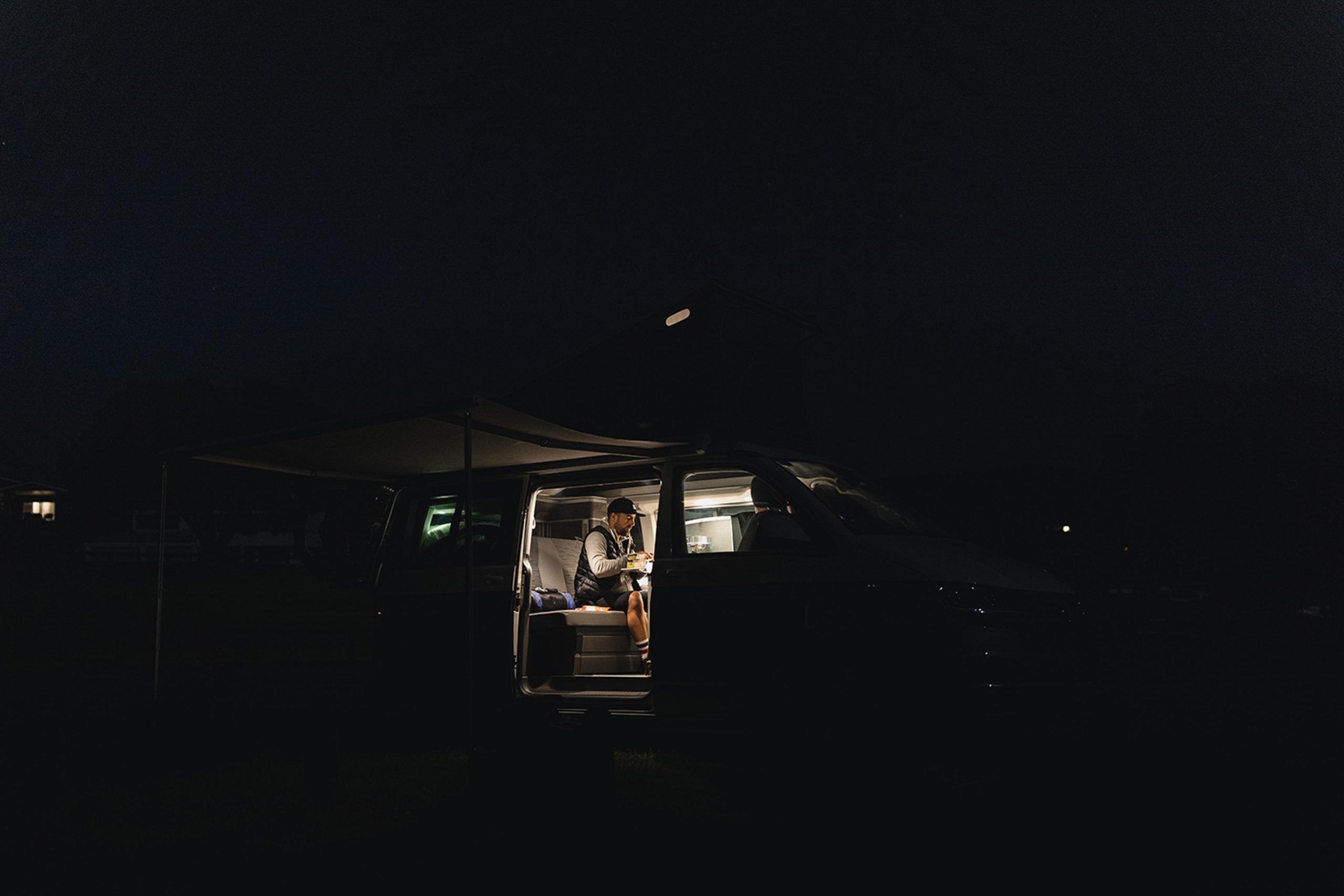
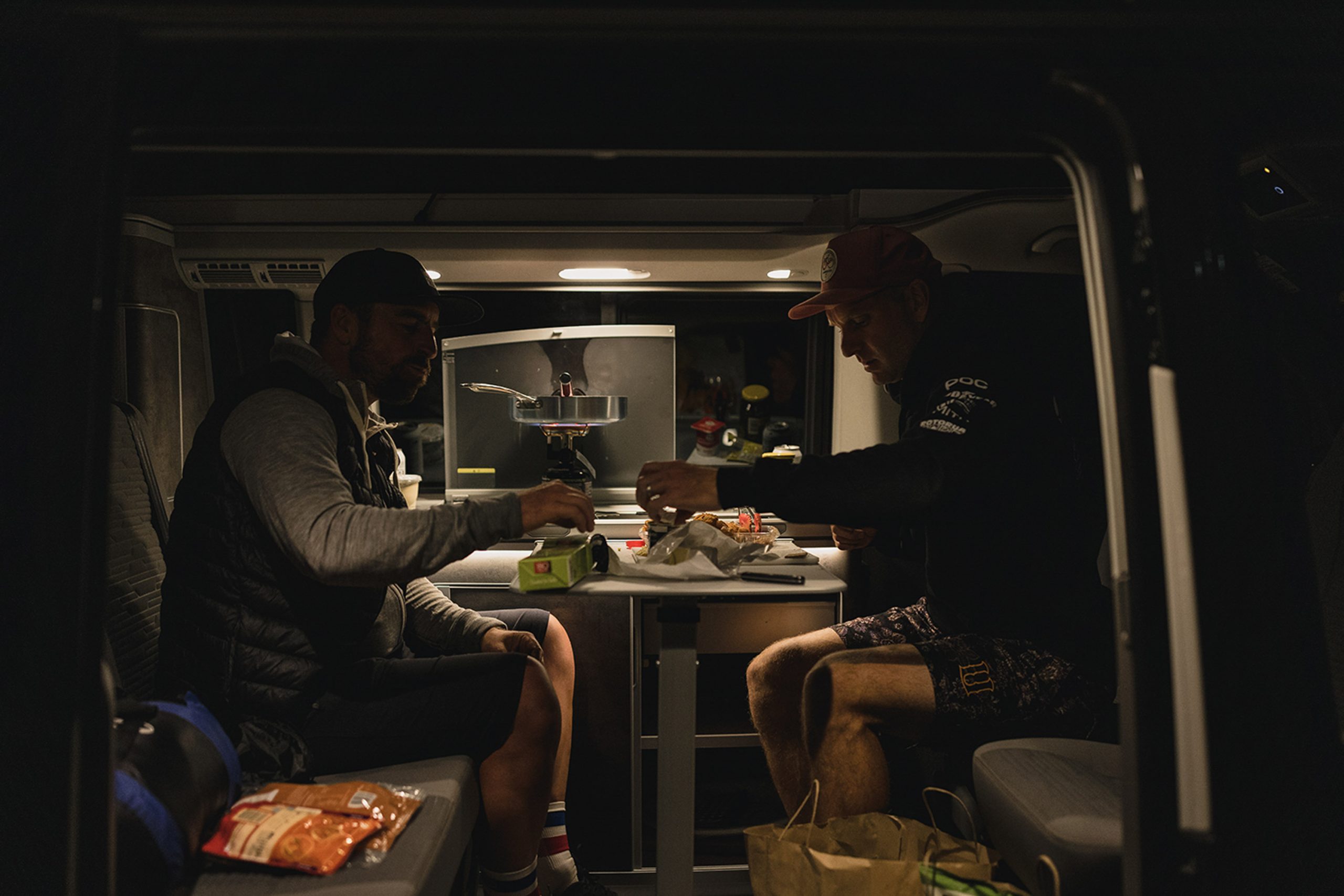
We’d be greeted with a perfect sunrise the following morning, and could dive in for a pre-breakfast swim, just a stone’s throw from where we’d sleep. Onemana Beach ticked all the boxes and we settled in. With instructions not to cook curry in the van, we figured some spicy Mexican would be fine, so got to work, recipe cards in hand. We literally solved all the world’s problems whilst eating our burritos and as the clock ticked into ‘tomorrow’ we slid the door shut and drifted off to sleep; the aroma of freshly cooked Mexican still hanging in the air.
The 6am wakeup came as rudely as you’d imagine after a scratch over five hours sleep. Blurry eyed we prepped ourselves for the sunrise; Cam started clicking, and Liam and I prepped the first round of coffee. This was what every morning should be: coffee and good yarns whilst watching the sunrise, followed by a swim (which doubled as a bath) and finishing with bagels and granola as the sun came up. The trails were shouting, so we rolled the awning in, dropped the pop-top, and set a course once again.
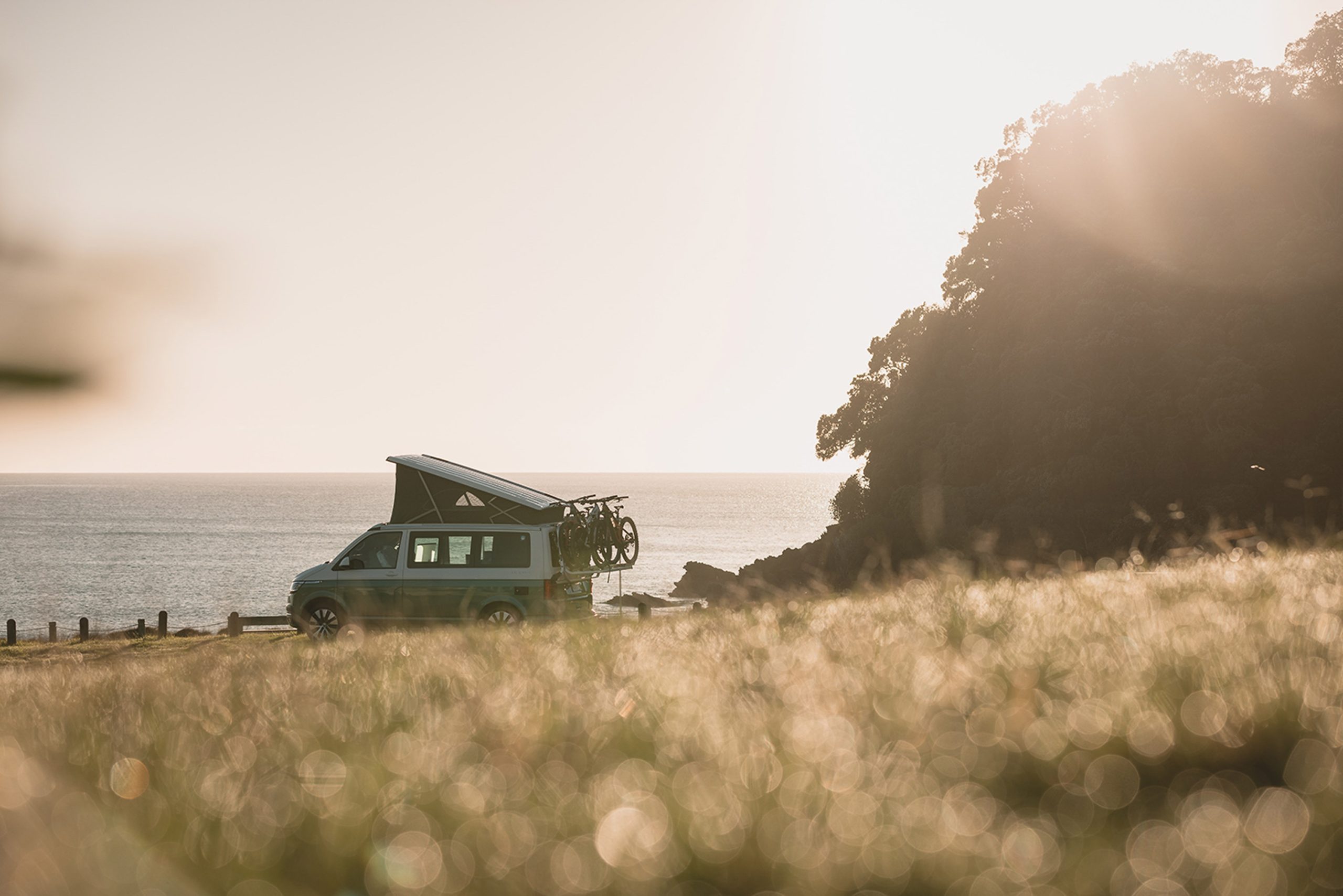
We fluffed around for 20 minutes trying to make the most of a bad situation; sessioning the bottom of Over the Falls as the curse of the dappled light once again killed our vibe. Hustling back to the van, we made a snap decision: head over the Kopu Hikuai’s and check out the trails behind Thames. But first, coffee.
Pulling into Thames, it was after lunch time, and we’d eaten all the van food. Walking past numerous secondhand stores – a couple complete with hand- scrawled posters touting numerous Covid-related conspiracy theories – we finally found a spot to eat. After a quick education from the waitstaff that our lunch of a Croque-monsieur meant ‘crispy gentleman’ (I’m still not sure that’s 100% accurate?!) we downed our iced coffees and were off to the trails.
Five minutes up the road, we rolled into the Moanataiari Mountain Bike Trails. One of the best things about the California is that it features 4MOTION AWD, meaning it can handle off-road driving to slightly more secluded spots – and secluded this was.
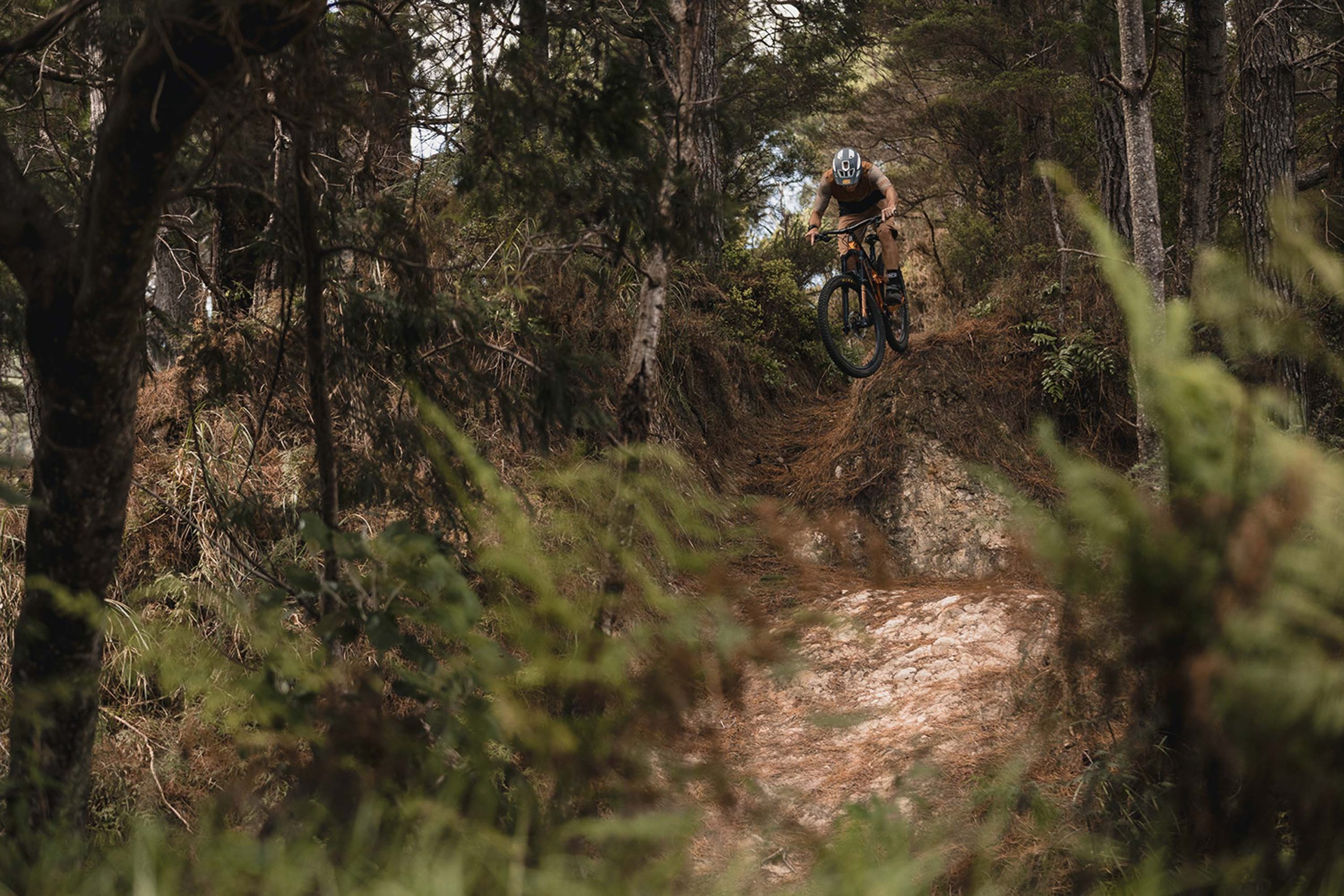
It was pretty obvious this was an old mining area with mining works visible right from the carpark, and signs warning not to stray from the tracks as mine shafts lurked in the bushes. We had no idea what to expect but armed with the Trailforks app, and a photo of the map at the trailhead, we stumbled around, finding our way. This is one of two key trail areas near Thames, the second a few kilometres out of town up the Kauaeranga Valley road. Given a little more time it would be easy to hit both areas, as well as the single 6km Karaka track, in half a day.
The Moanataiari Trails are accessed off a gravel road which, after a short climb, pops you out at a nice pump track – although why you’d venture this far up the hill with a pump track-suitable bike, I’ll never know. The ‘Hundred Acre Wood’ beginner trail winds its way around this pump track plateau, and a number of trails either drop onto, or begin their descent, from here. The park packs a lot of fun into a small number of trails. There are no big climbs or equally long descents, but there are a handful of flow trails with some super fun sections; pop this, gap that, rail that turn, charge the roots – that sort of stuff. The ‘Pit Fall’ trail has a nice drop at the end; an overhead-height gap over another section of trail. I’d not hit anything like this for a while and, after a couple of run ins, I plucked up the courage to hit it. Such is the beauty of a small-town trail centre – they’re able to build some of these more ‘risky’ features (much like the Whangamata rock-roll) which you wouldn’t find on a regular ‘legal’ trail at, say, Rotorua’s Whakarewarewa for example. I guess with less traffic there comes less opportunity for people to wreck themselves.
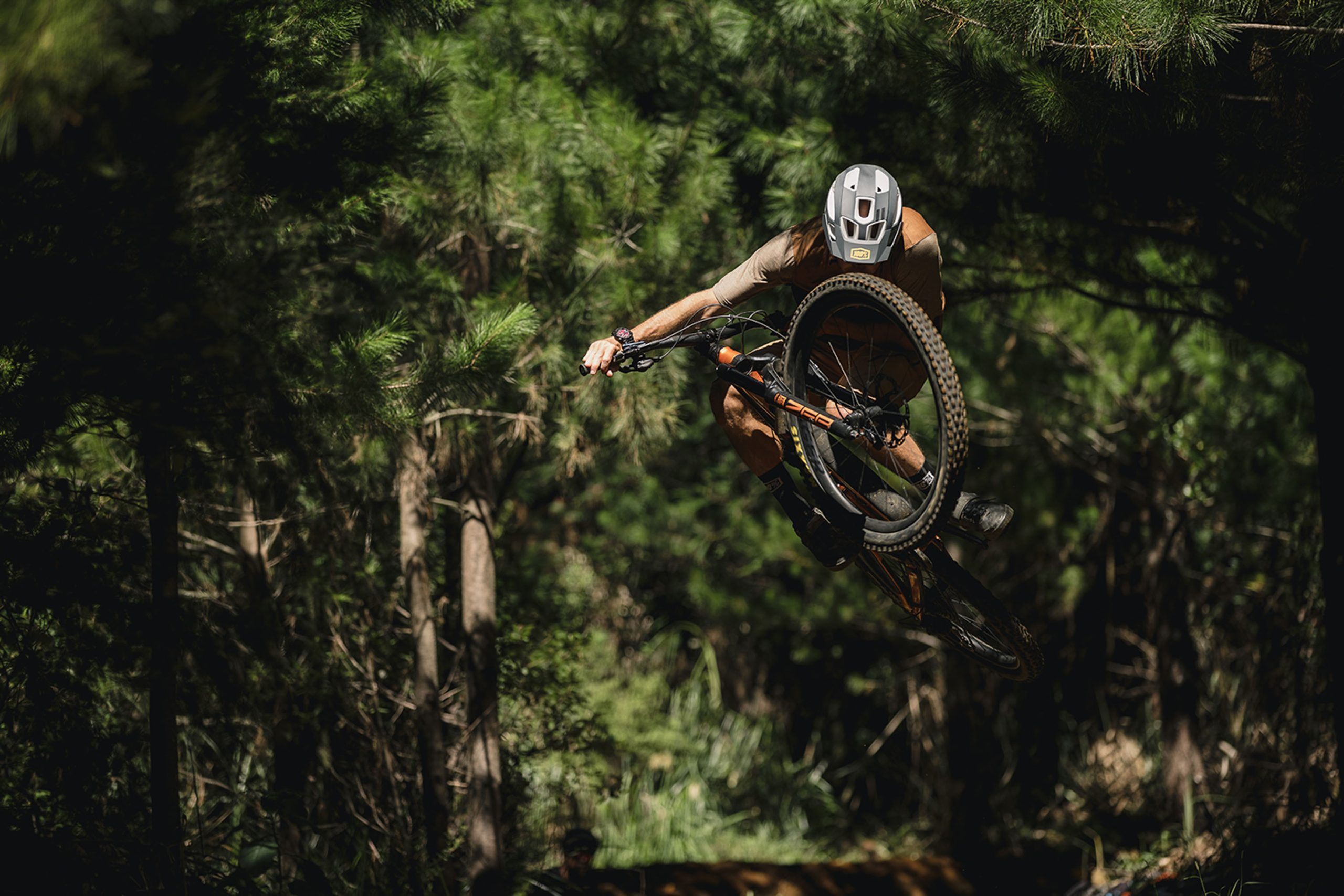
Rolling out of the trails and back to the van, we fist-bumped a successful session and loaded the van for our trip home. On the road for only 32 hours, and having no real plan or reservations to turn up for, we felt as though we’d been away for a long weekend – such is the vibe you get from being in close quarters with your travel companions the whole time. There’s no retreating to your room to doom-scroll the socials, or TV to demand your attention. The feeling of having flexibility to change plans at the drop of a hat, go wherever, stay wherever (within the local rules of course) and – if you’re lucky – waking up able to ride trails right from your front door, simply can’t be beaten.
Words: Lester Perry
Images: Cameron Mackenzie
Feature: Emma Bateup Into the Wild
Emma Bateup is always up for an adventure. In fact, if she’s not out on her bike completing a challenge she’s set for herself, she’s plotting and planning her next endeavour. Whether it’s Burbing, Everesting, or completing the Olympus Mons challenge, Emma never shies away from intrepid, unique adventures that take in the best this country has to offer.
Emma first got behind the handlebars at age three, beating her younger brother to the punch – he didn’t start riding until he was six. Despite that, Emma says her brother is one of the main reasons she is so into mountain biking now. Having parents who regularly took them into the great outdoors, meant both siblings progressed at riding from a young age. But, in her early high school years, Emma switched and started road racing. At the same time, her brother was getting into mountain biking in a big way and soon started dragging Emma out with him.
“On some of my first rides with him, aside from just family rides, he would just take me down a Grade 5 downhill track – so I think I just walked a lot of it! But it meant I was exposed to some pretty gnarly stuff, right from the start,” explains Emma.
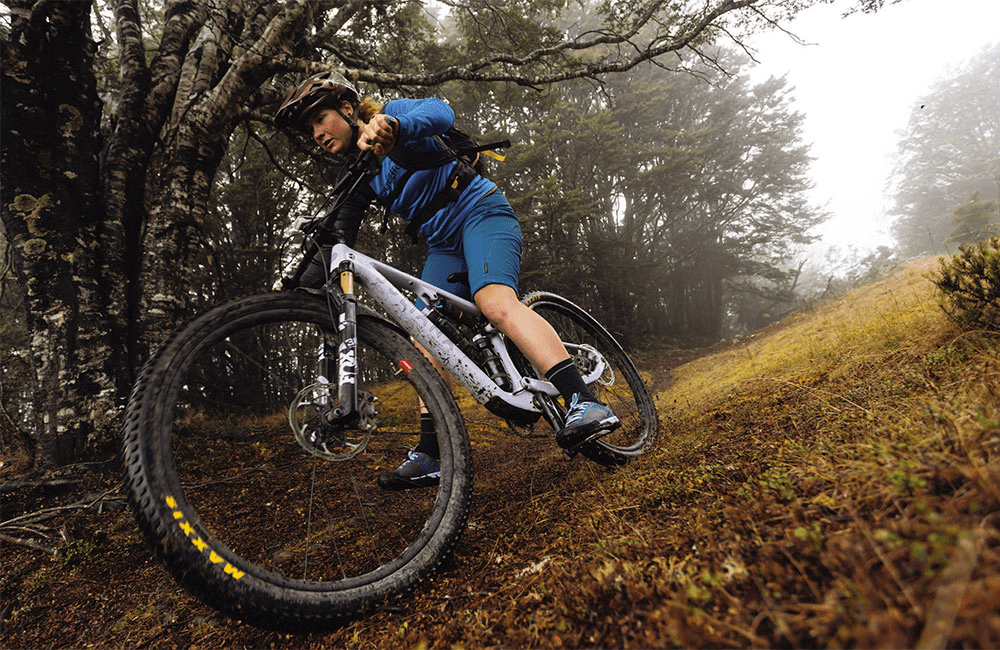
That baptism by fire happened when she was just 16 and, over the past six years, Emma has channelled her competitive energy into a variety of different racing styles, with a focus on Enduro for a time.
“Now I just do a heap of random stuff!” Emma laughs. But she’s not joking – take one look at her Instagram account and you’ll see what she means: there’s bikepacking, solo missions, racing, multisport training and even some pre-pandemic overseas bike trips to make you feel extra envious of this intrepid adventurer.
In this industry, it can sometimes feel like the only people venturing out into the wild – particularly on their own – are men, so it’s somewhat refreshing to know that Emma is doing just that.
“I think sometimes women are just a bit more planned,” she explains. “There’s still women out doing really gnarly stuff and massive adventures, but I would say they tend to pre-plan it a lot better. Although, I definitely don’t! With the Olympus Mons, I decided I was going to do it on the Sunday evening, and I started it on the Wednesday. I was always planning on doing it at some stage but deciding to do it that week, when the weather was good, was a pretty last-minute decision.” Emma agrees that perhaps us women don’t shout about our achievements quite so loudly as our male counterparts, either. “I often find it hard when people ask me what I’ve been up to. I always just say ‘yeah, I’ve been riding my bike’ – it’s kind of hard to explain that I’ve just ridden the height of a mountain on Mars....”
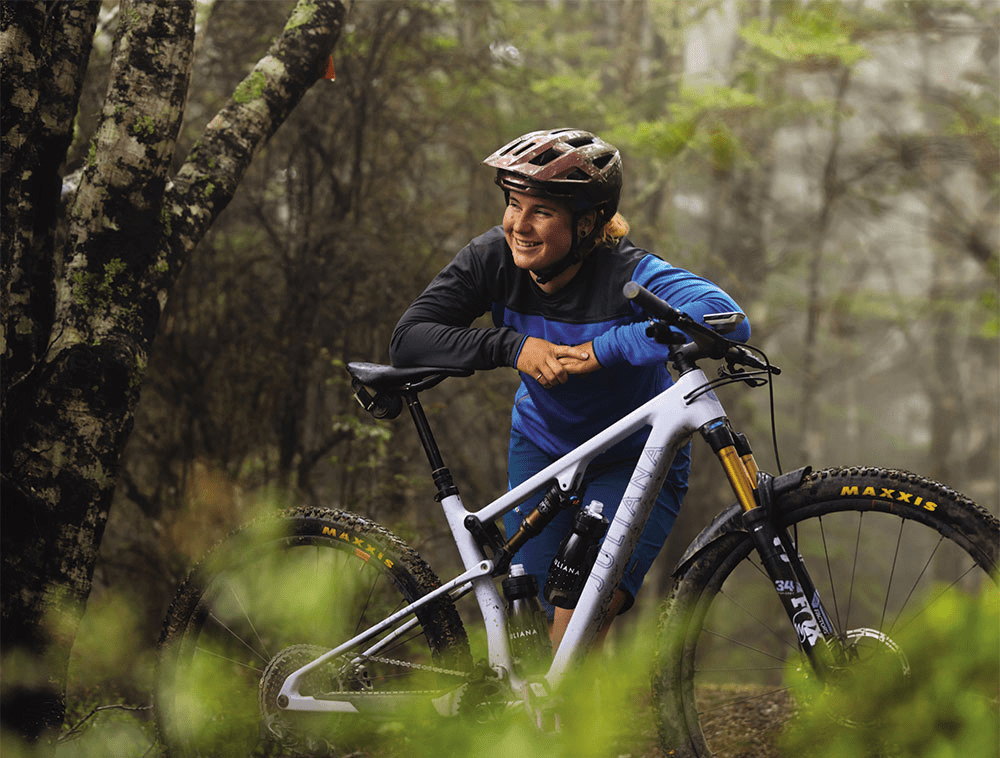
Thankfully Emma doesn’t have to explain herself too much to her parents or old friends anymore – they are starting to understand her constant quest for adventure and are no longer surprised when she tells them she is off on her next ride, even if the route is somewhat obscure. “It’s been interesting this year because I’ve got a whole new friend group, from studying, and their reactions have been great!” Emma laughs. “They’re not overly outdoorsy, so what I do is even more foreign to them. Sometimes I just stay quiet because it’s almost harder to explain it.”
Emma says that although her adventures are hard for some to comprehend, to her they feel like ‘just another weekend’. When things start to feel too ‘normal’, Emma kicks it up a gear and starts planning something bigger or longer or more challenging – she’s constantly plotting and planning where the next adventure might take her. “There are some things I have been thinking about for a year or so, but then some things I might think of the week before and go ‘ok, cool, I’ll go and do that!’ I’m quite an impulsive person, so that keeps me excited,” explains Emma. “I like pushing the limits, I don’t like going and doing the same – or similar – thing twice. If I’ve done a 300km ride then I want to do a 400km ride and so on, until it gets out of hand and then I’m going into nights....”
Lack of sleep, and riding through the night, is not something Emma shies away from despite the fact she is almost always tackling these challenging rides on her own. During the Olympus Mons challenge she completed in November, Emma only slept for 10 of the 72 hours it took her to finish the ride. The fact she even completed the challenge puts her in a pretty unique position – only one other person has completed it in its entirety. The Olympus Mons was something Emma had been thinking about since March this year, waiting for the perfect weather and finding the ideal loop to ride. Completing the challenge completely off tar seal also makes Emma a unique participant in the Olympus Mons, as the only other person to do it completed it mostly off tar seal but with a few sections of tar seal as well. She even incorporated a little bit of singletrack into each day – you know, just in case the challenge wasn’t already tough enough!
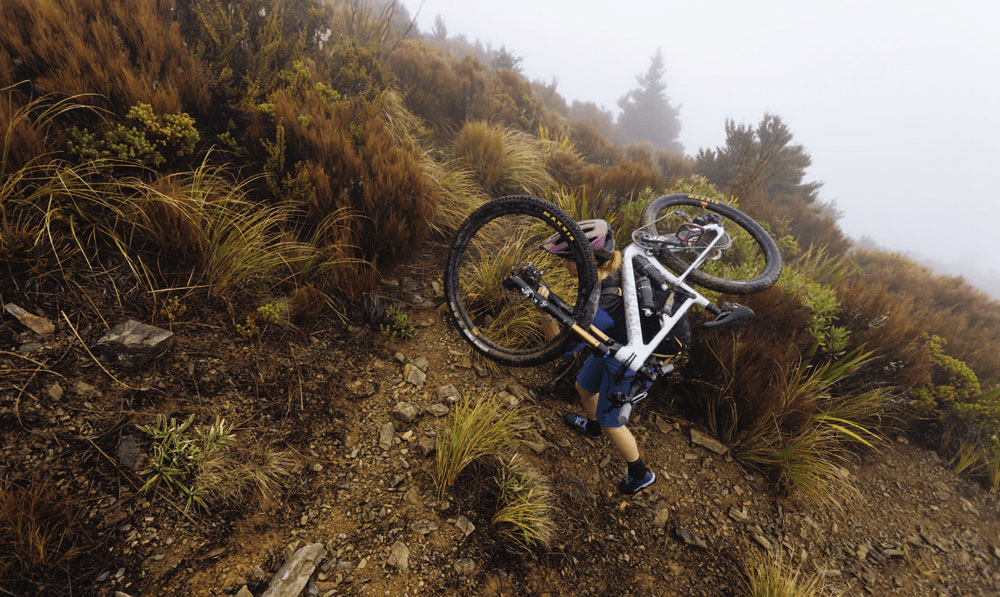
Although Emma undertakes these challenges on her own, her friends are always only a phone call away and offer their support by charging lights, delivering food and even giving her bike a tune up after hours of riding. “Some of my friends even came and rode a few laps with me [on the Olympus Mons and Everest challenges] .... but no one wanted to come out and ride on the last day!” laughs Emma.
This summer, Emma will take on the ultimate self-supported challenge when she rides the Tour Te Waipounamu – a ‘warm up’ for GodZone, which she’ll be competing in a month or so later. “In a way it’s something that is really familiar to me, because I do a lot of riding, but I’ve never done anything quite like Tour Te Waipounamu before, so I feel really inexperienced,” says Emma. “It’ll be interesting. It’s a lot of sleep deprivation so....”
In terms of planning for 2022, Emma is focusing on Tour Te Waipounamu and GodZone, particularly over summer, but she’ll be looking for other adventures to tackle once she’s completed both of them. “There will be other races that pop up and while I’m doing adventures I’ll think of other things – like ways of linking up a whole heap of trails – and so I’ll do that over a week,” explains Emma. “I never used to have this need to constantly do things, but now I just like seeing how far I can push myself.”
Emma says it’s been interesting to see the progression and keep building on it. “With the long-distance side of things, it’s easy to get burnt out, but it’s not like you really peak,” explains Emma. “It’s just constantly building up. I might have a slow period but then I’ll build up again. I don’t have much fast speed anymore, which is a bit sad, but I can just keep going. Physically, I’ve got a lot of capabilities, but mentally – with the sleep – that’s the hardest thing. I know my body can do it, but I’ll be beating myself up thinking I’ve got another two days to go! It’s a work in progress.”
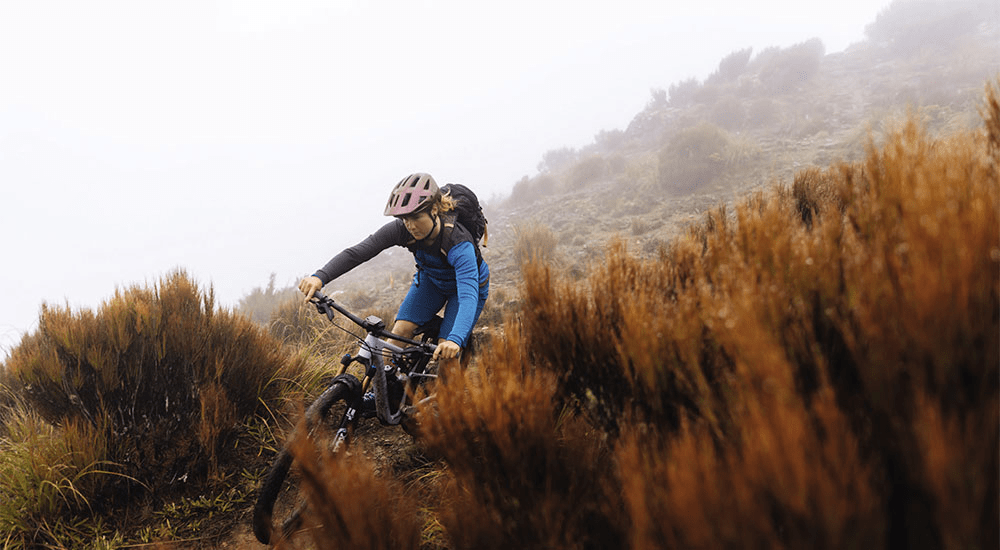
As well as her own self-imposed challenges, Emma has completed some of the better-known ones as well. Everesting, a Mount Cook challenge, Burbing and, of course, the aforementioned Olympus Mons. For the uninitiated, Everesting involves riding a hill – any hill the rider chooses – over and over again, in a single activity, until you’ve completed a distance equivalent to the height of Mt Everest. The Mount Cook and Olympus Mons challenges are the same concept, except riders complete the height of Mount Cook and Olympus Mons, which is the highest mountain on Mars. Yes, Mars – as in, the red planet.
These sorts of challenges – self-imposed or otherwise – require a certain level of resolve, and Emma will be the first to admit she has a ‘just keep going’ attitude, on or off the bike. “I don’t like quitting things,” says Emma. “With riding, this year, I’ve pulled out of one thing and that was because the weather got really bad and I was on a main road, and I probably would have been hit by a car. That was hard to do. I guess I do have a mentality of, when I’m in something, I’m fully there. I really beat myself up if I don’t finish something. I know if I don’t do it, I’ll regret it – and that keeps me going.”
Being ‘fully there’ sometimes means choosing between her beloved bike adventures and studying. Emma is a first-year nursing student and, while she loves studying, she admits she sometimes just wants to be outside, on her bike. “Riding has been my way of switching off and resetting my mind,” explains Emma. “I struggle to just not do anything – even sitting at home watching a movie, I get so bored! I definitely like to be busy but, that does make me tired. A rest for me is going to work. I work weekends in a bike shop, I just get to talk about bikes all day – which is awesome!”
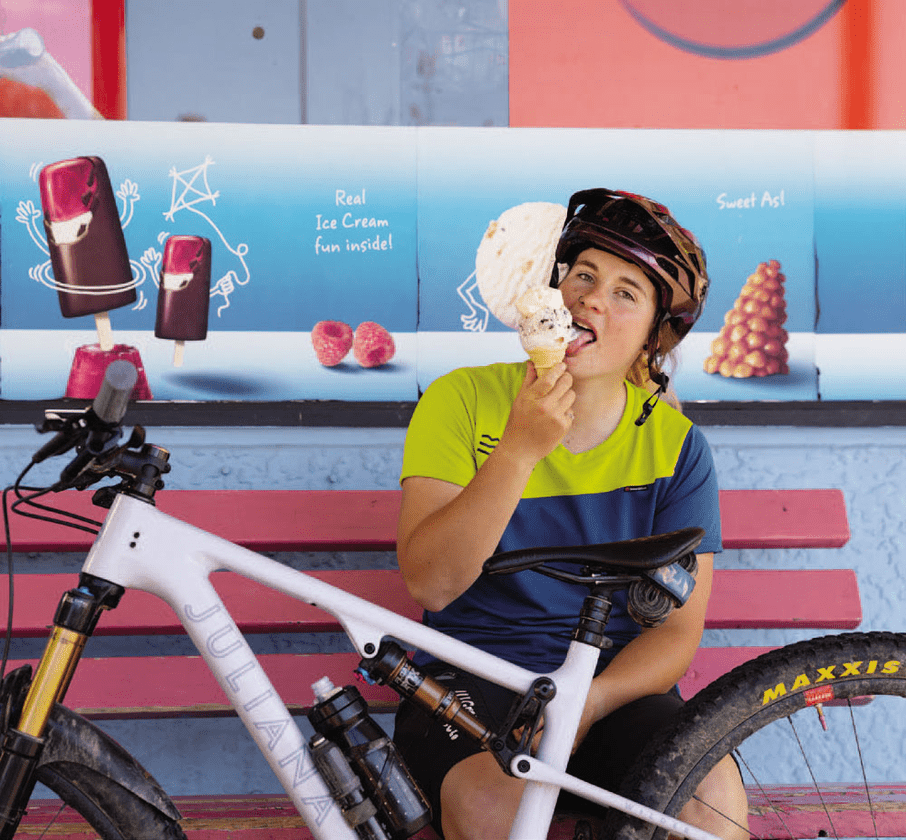
Emma is full of encouragement for others who might want to take a step into the unknown and eventually try out a solo adventure or challenge for themselves. “To start with, find other people who are in the same boat – if you’re scared then it’s likely someone else will be too, so you can conquer something together. When I first started riding, me and another girl from school would go out together and try out these Grade 5 trails – and mostly walk down them. But it didn’t seem as hard because we would both be struggling and we’d both spend all weekend crashing! If you’ve both just crashed on the same corner, you can generally just have a good laugh about it, which makes it okay.”
And what about the times everything is not okay? Bearing in mind Emma is often out exploring on her own in remote places. “It makes me sound like a bit of a wimp.... But I’ll generally cry!” laughs Emma. “If I’m having a bit of a shit time – sometimes I’ll stop, sometimes I’ll just keep going – I’ll have a good cry and let it all out, then I’ll get going again. I’ll have a quick breakdown, then I’ll go, ‘harden up!’ and carry on. I didn’t cry during the Olympus Mons, though, so I was really proud of myself for that!” It’s hard to imagine Emma crying – she sounds like someone who permanently has a smile on her face! But, knowing she’s not immune to tears makes her even more of an inspiration.
So, how can we all be a bit more like Emma? How should we go about setting challenges for ourselves, packing up last minute and heading into the wild? “Throw yourself in the deep end,” Emma suggests. “It is scary at times, but you’ll always be stoked you did it.”
Words: Kerrie Morgan
Photography: Henry Jaine
Feature: Hanmer Springs - The Gold in them there Hills
Hanmer has the beauty and charm of an Idyllic Mountain Town - perhaps a little like what Queenstown may have felt like 50 years ago.
This has been a tough year for many, arguably those living in the Auckland region – and those stranded overseas trying to get home via the MIQ lottery – most of all. In the era of COVID-19 and lockdowns, exactly where you live has a dramatic effect on every part of your life. Those in Auckland have endured 100+ days of lockdown now, while those in the south have enjoyed relative freedom. Regardless, lots of us are looking forward to a summer break where we can truly recuperate. But where should you go to do that?
After spending a few days there recently, I would argue that Hanmer Springs, 130 km north-west of Christchurch and 65 km south-west of Kaikoura, might be worthy of serious consideration. In fact, recuperation is pretty much in Hanmer’s DNA.
The hot springs for which Hanmer is famous for, have long been used for the purposes of rest and restoration.

Leaving Hanmer, the trail up is tight singletrack, cut into the slope and, being in the mountains, you are climbing on a rocky shale surface the whole way. This surface means that trails stay in great condition for most of the year.
Since the early 1900’s, facilities were built around the hot pools and, over the years, these have variously been hospitals caring for sick and wounded soldiers, facilities for caring for women, as well as caring for those with alcohol or drug disorders. The theme has been the same throughout; hot pools, fresh air and sunlight, away from the hustle and bustle of larger centres, Hanmer was a place where you could come to rest and be restored. What’s more, the population is only 1120! Hey Auckland! Sound appealing yet?
Of course, rest and relaxation isn’t just about sitting round the pool – it’s about getting out and hitting some trails. When you drive into Hanmer, the first thing you notice is the lines of trees down the main street. It’s got the beauty and charm of an idyllic mountain town – perhaps a little like what Queenstown may have felt like 50 years ago. From town, you can look up and see Conical Hill and, as you look around, you see the broader outlines of the Hanmer range and Mount Isobel (1324m). It’s this combination of a small mountain town, with trails on your doorstep that makes Hanmer Springs so appealing.
We stayed at the iconic Hanmer Hotel, built in a Spanish Mission style and completed in 1932. It’s the perfect place to base yourself during a stay in Hanmer, and is an architectural icon in its own right, as well as being surrounded by beautiful grounds – perfect should some in your party want to leave you to ride while they enjoy the grounds, the pool, or a drink in the courtyard.
Once we were settled in, it was time to hit the trails. We were fortunate to have a guided tour of local trails by none other than Hanmer Springs’ local mountain biking ambassador, Anton Cooper. Anton is pretty much a household name now but, if you’re unfamiliar, he’s a New Zealand Olympic Team rider, regular on the World Cup XC circuit, and ended up with a stellar 8th overall at the end of the 2021 season. If that wasn’t enough, we were also joined by local legend Steve Halligan. Steve may be less of a household name if you haven’t delved into the ultra-endurance bikepacking scene yet, but Steve is one of these guys who will ride for 24hrs straight, sleep for an hour or two then crank out another 300km. To give you an example; despite mechanical setbacks, in 2019, he rode to 4th in the 4,418km Tour Divide (Banff to Mexico border) in 16 days and three hours! He’s a freak. But he’s also a hell of a nice guy. Between Anton and Steve, I was already feeling like this might be a weekend I wished I was on an e-bike to help level the playing field.
Once we had all checked in, there was still time for an afternoon ride. Heading out from our hotel, we were onto some gravel within five minutes and started ascending up the Clarence Valley Road; a good warm up and the fastest way to get to Tank Track, that gave us a decent reprieve from the climbing and conveniently led us on to Yankee Zephyr, and our real trail target, Tombstone.
Together, these form a great loop that is a real workout and gives intermediate to advanced riders some solid climbing. Leaving town, you are at about 340m above sea level, and at the high point on Tombstone you will have reached 680m. The trail up is tight singletrack, cut into the slope and, being in the mountains, you are climbing on a rocky shale surface the whole way. This surface means the trails stay in great condition for most of the year.
At the top of this I had a healthy sweat on and had felt like I’d done some decent work, but I’m pretty sure neither Anton or Steve’s heart rate got above 60.



From the top of Tombstone, it’s a tight and twisty downhill – hand-built single track at its finest, and you have to be on your game to make sure your handlebars don’t clip any trees and your wheels don’t veer off the edge. Within moments of dropping in off the Tombstone summit, and despite my best attempts to stay with him, Anton was gone – completely out of sight – and this was a pattern that would be repeated, over and over and over the next few days, making it abundantly clear why he is a professional rider and I.... am not.
The trails around Hanmer have an interesting way of quickly showing you exactly where your skill level is actually at and how confident you really are. There aren’t really jumps or drops that feature, instead what separates the pros from the noobs (as my Minecraft-gaming sons would refer to me as) were the long, tight, twisty downhills, shards of rock pointing out at the most awkward angles and the plenty of switchbacks that test your ability to judge entry speed, braking and overall technique.
As much as I was observing the trails and loving the terrain, I was also in awe of Anton’s ability to simply get round these tight corners that often felt like they had a loose covering of pea-metal sized rock sitting on the surface. He could truly hold uncanny speed through these, and time after time it was a case of one corner, two corners, out of sight. After Tombstone, we linked a few extra, fun flowing trails; Big Foot, Detox, and Red Rock to get back to town. Detox was a crowd favorite – a little wider than we had been riding with plenty of speed and flow to keep the smiles pinned.
On our second day, it was time for an expedition of sorts. Anton and Steve had been talking about a trail called Addiction – saying that it was one of their favorite trails of all time, and definitely worth the effort. Effort? If it’s an effort to these guys, would I even survive?
Addiction is a double black trail that’s a challenge not just to ride, but even to get to. One of the interesting things about Hanmer Springs is the 4WD roads that surround it. Jollies Pass Rd, and the Clarence Valley Road, are joined by Top House Road to form a bit of a classic backcountry 4WD loop that can be a fun addition to a trip. You could also use these to connect the St James cycle way back and ride all the way back into Hanmer.
We didn’t have time for that on this trip, but I would definitely like to do that another day. For today, it was riding from our hotel, up Jollies Pass Road till we got to around 850m elevation – that’s about 500m vertical with no reprieve and, as much as we loved the perfect blue sky weather we had for this trip, I would definitely recommend getting started earlier than we did because it was hot, hot, hot, grinding up Jollies Pass Rd with the sun beating down on us.
Eventually, we reached the turn off to Addiction and, after a gentle traverse, the trail seemed to literally tip downward. This is the point where you are either glad you’ve got a new set of brake pads in, or will be kicking yourself for not having them, because the next few kilometres are steep technical descending with no let up. With plenty of elevation to play with, the trail builders clearly saw no reason to eek it out, instead they decided a direct approach was the best way to get down. The start of the downhill is a solid 500m where the average gradient is consistently 35-40% down before you get a let up. Where you are used to trails having a natural ebb and flow of tech, steep, and then periodically flatter sections, Addiction just keeps on giving. There are one or two sections where the trail just stretches out almost beneath you, where it is just a straight line down – no corners, just narrow steep singletrack, with plenty of that awkward angled rock to rip a hole in your sidewall or elbow should you get off-line.
Anton, typically, was nowhere in sight. I imagined him back in the hot springs wondering what was keeping us all. OK, that’s not entirely true, Anton did stay with our group and we had a blast riding together but, despite my best efforts, I still had no chance of keeping anywhere near him. By the time we reached the bottom, I could see why this trail is called Addiction; the first hit is a rush, but I think every hit after that would be even more satisfying. Conveniently, Addiction leads straight on to Detox which extends the fun even further.
Stopping and taking a few photos along the way meant that, by the time we were down, we were all ready to hit the famous Hanmer Springs Thermal Pools. These are a major tourist drawcard for the region, and for good reason – they are pretty special. These aren’t your average council hot pools; they are more aquatic theme park than just hot pools. I lost count of how many pools there are – there are cascading pools, aqua therapy pools, sulphur pools, rock pools, private pools, as well as a big play pools for kids and two pretty fun waterslides that yes, for the sake of research, we spent quite a while testing. (FYI: current COVID-19 restrictions mean you need to book ahead of time, so make sure you phone ahead to avoid disappointment.)
Back to the riding, our final day was spent getting the photographic requirements we needed for the trip, so it was hitting a few spots we thought best described the feel of what it’s like to ride here. Everyone was keen for another lap up Tombstone and now that we were all getting in the flow, getting used to the trails and riding them for a second time just escalated the fun. While we chose some of the more techy trails, it’s not just all gnarly; there are plenty of family friendly tracks that are easily accessible, only a few minutes from town, that even the littlest of legs can access without having to load up all the bikes onto the car each time you want to ride.
It’s the easy proximity to the hills that make it so appealing and, if things keep going the way they are going, I am sure Hanmer will no doubt turn into a real destination mountain bike town. On this trip, we rode the Old Ghost Road the day before coming to Hanmer and it’s this relative nearness to lots of things that makes it worth adding in to your summer road trip plans.
Having never spent time in Hanmer Springs, I was blown away by what it had to offer. Trails are the new ‘gold rush’ when it comes to small South Island communities – and when it comes to Hanmer Springs, ‘there’s gold in them there hills’.
Words: Lance Pilbrow
Photography: Cameron Mackenzie
Feature: Chch in 24 hours
We all know the rough hand Christchurch has been dealt in recent years. From natural disasters to the horror of March 15 2019 and, more recently, the big C word, we’ve really been thrown a few curve balls. These events have brought with them unexpected change. In particular, the ongoing pandemic has seen us stuck in lockdowns and unable to connect with our friends in person. What remains unchanged, however, is the way bikes bring people together through a common connection. Back in June, my good friends moved back to Christchurch after three years away in the big smoke and we picked up right where we left off – just like the old days when we were growing up. They had ridden Vic Park, but they hadn’t seen some of the other riding areas Christchurch has to offer.


It’s funny how you get stuck in your ways with riding. You frequent the same trails and the same routes. However, when it came time to planning our catch up ride, it dawned on me that Christchurch is a now an incredibly accessible city for mountain biking. We have a huge variety of trails that are all interconnected, with great options for refuelling and hydrating along the way.
Kicking off the day with breakfast and coffee at home, we chatted and made a plan for the day ahead. We’d start out at Christchurch Adventure Park (CAP), which was once just a series of trails in the old Worsley’s Forest. Back then, it was a pretty low-key affair but an important piece of the Christchurch riding scene. When the park was built and opened in 2016, it incorporated some of the original trails, which my Auckland pals were familiar with as the last time they’d ridden in this area was before the park opened.
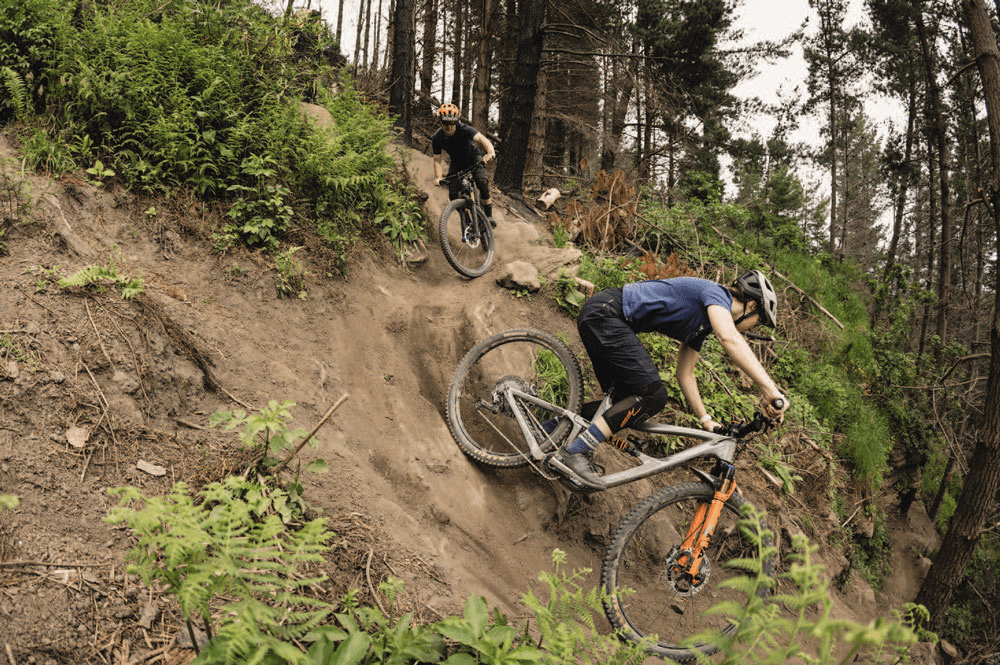
Unfortunately, In 2017, the park itself suffered a blow from Mother Nature when a large fire ripped through and destroyed the majority of the trails – a mere eight weeks after originally opening. After many hurdles getting back up and running, the park now boasts an excellent array of trails which are all accessible by chairlift, but the reality of the fires – and the challenges faced when rebuilding the trails – are evident. Trees that were badly burnt on the outside still stand, while entire areas have been completely decimated as trees have succumbed to the damage caused by the fires and fallen. It’s a stark reminder of the power of nature – something Christchurch is sadly all too familiar with.
One of the park’s latest offerings is a trail called Wasabi. Weaving through an area of tree fall littered with foxgloves, the trail tightly drops into a traverse with rocky crags towering overhead, before heading into a couple of technical rocky sections and some dusty corners full of once-burnt material. It was refreshing to be able to reintroduce friends back to CAP after a few years away and have them reminisce the old days riding in Worsley’s, after riding the likes of Wasabi.
Having a chairlift in town really opens up the options, so we made the most of it after our lap of Wasabi, by heading back up and pedalling along Christchurch’s iconic Summit Road before dropping down into Lyttelton for lunch at Co-Op. This café has a great view over the harbour and an awesome menu, catering to every taste. We tucked into lunch and enjoyed a coffee before getting back on the rigs and heading out to our next stop of the day.
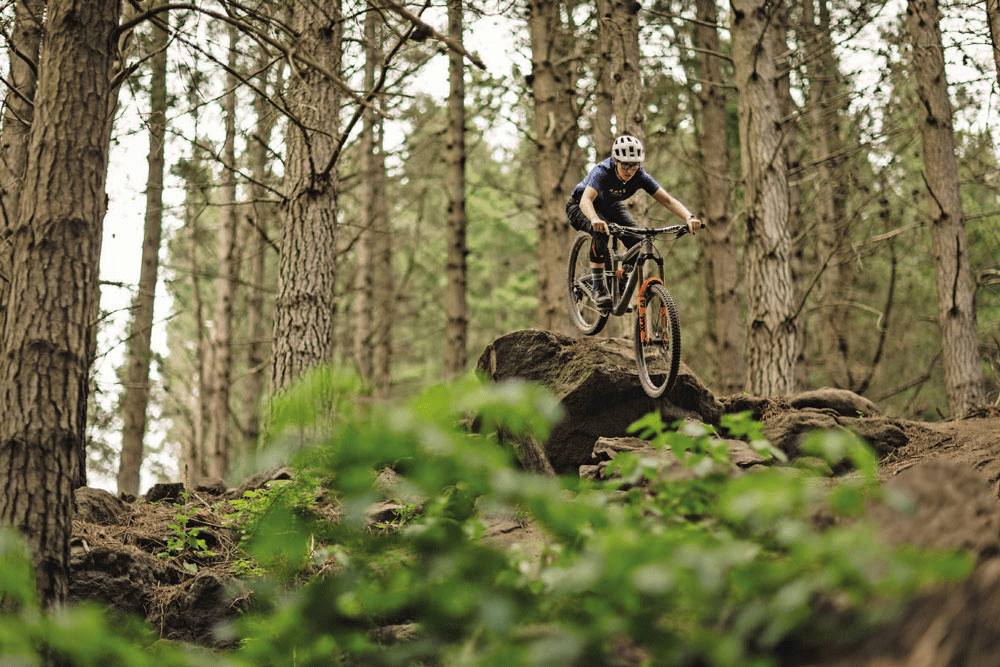




Riding in Lyttelton is a bit of a ‘phoenix rising from the ashes’ type story. The area always had trails but, following the 2017 fires, the area rose to incredible popularity as riders looked to get their forest riding fix. Recently, more trails have emerged. We pedalled up a few times and dropped down some of their black graded trails, stopping en route to session some of the techy features in the forest. The vegetation is dense and green, making for a unique experience compared to riding in the rest of the Port Hills network. The stoke factor was high – thanks in part to sharing the experience with mates who were riding it for the first time. Short climbs and fun descents mean there is plenty of time to chat about recent happenings and life movements.
After a few hours shredding in Lyttelton, we cruised back through the streets of the port town and winched back up to the Summit Road before dropping down into the city via Rapaki Track. We rolled around the banks of the Heathcote River, eventually pulling up at Moon Under Water to wet the whistle after a solid day of riding. Moon Under Water is a craft beer spot that has gone from strength to strength in the last few years, despite the adversity faced in the hospitality industry. The bar is incredibly popular with the riding fraternity, and it’s not uncommon to see the entire outside of the building lined with bikes after a school night ride. We enjoyed a cheeky burger and fries, happily washed down with a hoppy number. After some more much-needed catching up, we got pedalling – heading west to try and get the best views of the sunset. We eventually found ourselves above the Crocodile MTB Park, ripping the grassy turns as the sun set.


Once the sun had disappeared, we headed back home to debrief on an epic day of riding. We were all in agreement that we’d never thought a day of riding like this would be possible in Christchurch. While change can be hard to adjust to, the results are often worth it. Life moves fast and shit happens, but it all gets put in perspective pretty quickly when you realise three years has flown by. Life is short; look after your mates and live harder.
Words: Will Keay
Photography: Cameron Mackenzie
Feature: Shredding Queenstown
It would always astound me how, on any given day in summer, you could be standing in that hour- long lift line in the shadow of Skyline, watching an almost one-to-one ratio of international riders and pros alongside locals. People would flock from all corners of the globe to ride in Queenstown, and many would call it home for those key months as they trained for the coming season.
The world’s fastest weren’t the only ones preferring to use Queenstown as their base of operation though. Over the last few years, as the mountain bike media landscape has changed, so too has the way projects have been shot, with a major emphasis on the location. If you were to look at any random selection of film or photo projects, not just with Kiwi athletes, I guarantee the Queenstown Lakes region would feature.
Given the depth of talent residing in the south, it’s always baffled me as to why there hadn’t been a world- class event hosted on the slopes above the Wakatipu Basin. That’s not to say the likes of Mcgazzafest, or any one of the locally organised races aren’t world- class nor lack the talent pool, but rather an event recognised in all four corners of the globe.
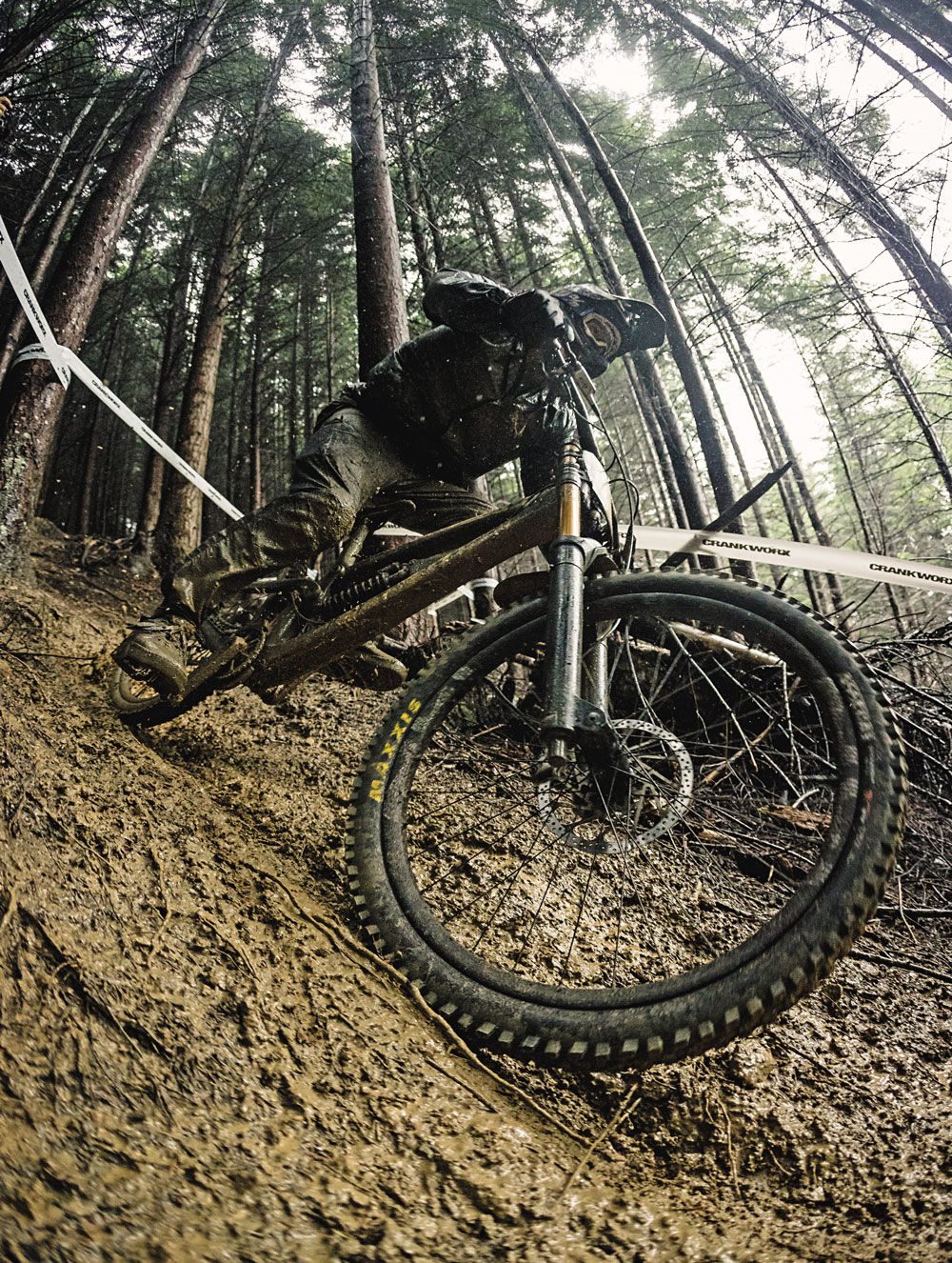
When it was announced that Crankworx would be taking the show on the road in the form of a multi-stop summer series road trip, speculation began as to what the locations would be, and for what disciplines. It was of both little surprise and great excitement when it was finally announced that the downhill event would be held in Queenstown. It was the logical location for such an iconic event, and the rightful home in the minds of many. The biggest surprise was the addition of a pump track event held alongside, on what we’d later come to find was a brand-new course built to launch with the race.
The benefit of an event like the summer series coming to town, is that the circus brings with it some of the world’s best athletes, transplants them into a tight-knit community and creates the opportunity for local pros, riders on the fringe, and aspiring next-generation rippers to rub shoulders with some of the world’s best. Add to that a purpose-built course that’s then handed back to the community for all to use, in a town where that was the last thing remaining to complete the trifecta, and you’ve got everything anyone would need to progress and grow.
We couldn’t not attend the inaugural Queenstown CWX Downhill, with the stage set for it to be great. It wasn’t just the athletes; we were curious to see how it would compare to the Rotorua-based main event.
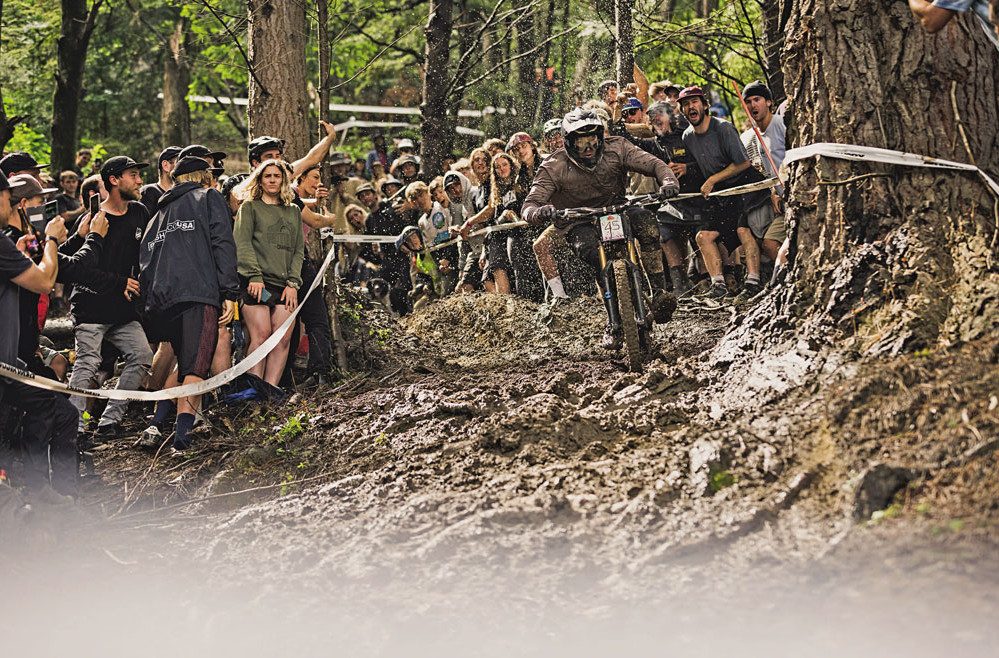
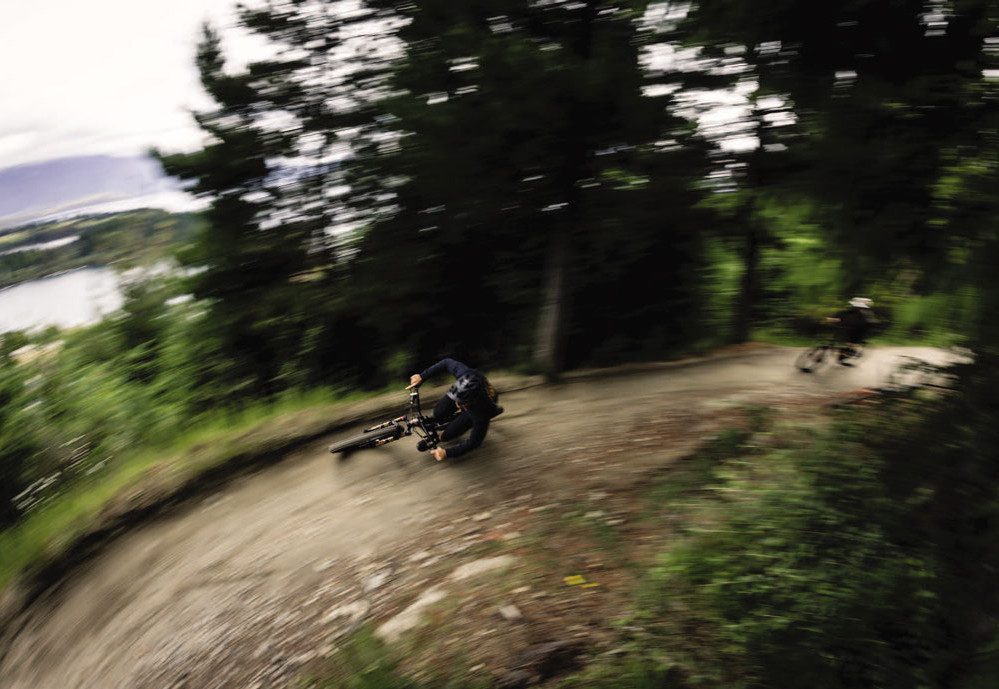
With our Covid restrictions changing shape, and easing somewhat, right on the eve of practice, I don’t think anyone quite knew what to expect. It wasn’t until race day when the storm rolled in that the true colours began to show. Overnight, between practice and race day, the heavens opened, soaking the steep and rather fresh course. What greeted us all in the morning was a mud bath, a complete slip and slide, and the makings of a mud race for the ages.
The orange-light open-season meant spectators were once again allowed trackside, and whilst Crankworx didn’t actively promote spectatorship, they came marching two-by-two, armed with refreshments to see them through the day. I don’t think anyone could have planned a wilder restart and race if they’d tried. The potent mix of a proper mud race and the event we’d all been waiting for combined with an easing of Covid restrictions and enthusiastic humans who’d been locked down for the end of winter, resulted in a heckle-fest even Crankworx staff were comparing to the heckler’s rock of old. Safe to say, it definitely made for some of the most colourful scenes I’ve ever witnessed at a race.
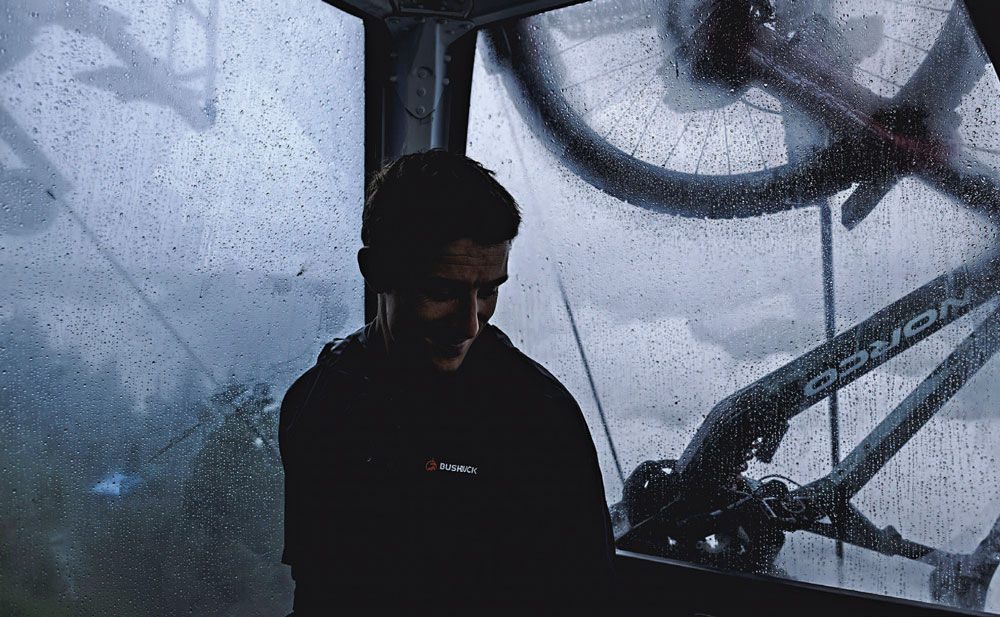
New Zealand featured heavily on the leader board, with Kiwis taking out the top five placings in the men’s division and Sam Blenkinsop nailing the top spot. Over in the women’s division, Jenna Hastings took out a solid 4th place, whilst fellow Kiwis, Melissa Newell and Kelsey Timpany, came in 8th and 11th respectively.
I don’t think anyone could have planned a wilder restart and race if they’d tried. The potent mix of a proper mud race, the event we’d all been waiting for, an easing of restrictions, Crate Day, excessive drinking and loose-moralled humans resulted in a heckle-fest even Crankworx staff were comparing to the heckler’s rock of old, and made for some of the most colourful scenes I’ve ever witnessed at a race. In other words: nothing short of complete mayhem. Off the back of the festivities and continuing the theme of ‘new and improved’, it was only fitting to hang around a couple of days, revisit some old faves, and go exploring to see what was new in the trail department.
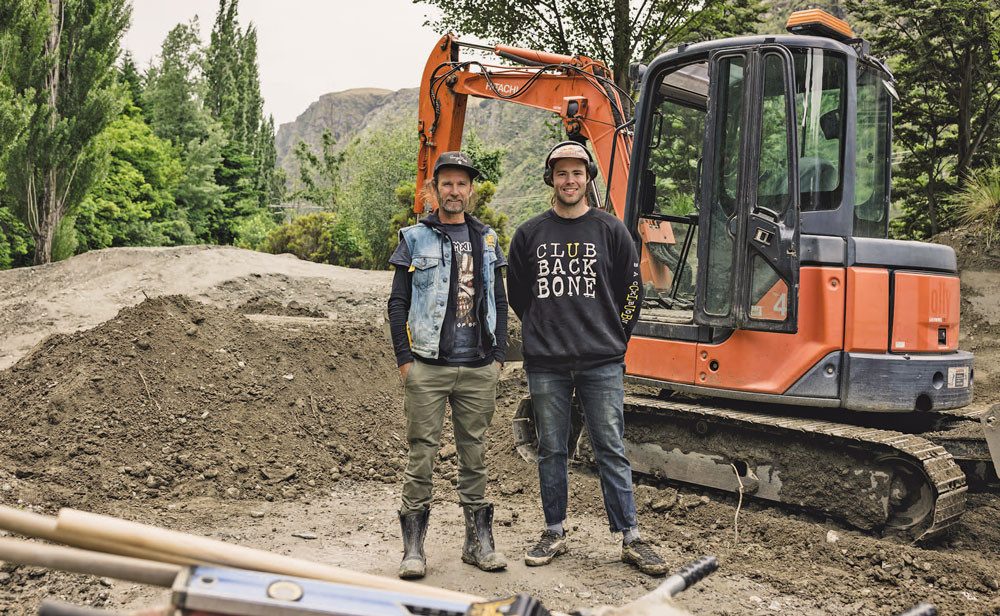
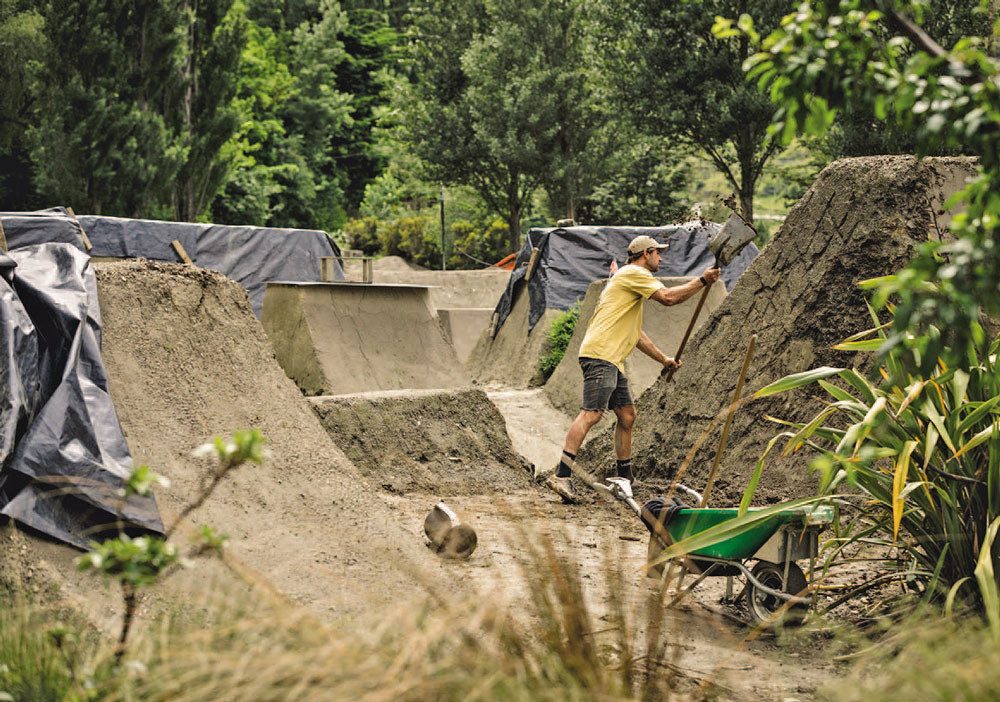
GORGE ROAD
The benefits of mixing pros and locals has been prevalent for some time but, more recently, it’s been on full display throughout the Gorge Road Jump Park saga. After several stays of execution, and despite the best efforts of the Gorge Road riding community, it seemed that arguably the most iconic community jump spot in the world, would meet its end this year. However, with considerable effort from Gorge Road locals, including mainstays Nathan Greenwood and Remy Morton, Queenstown-based entrepreneur, Rod Drury, and legions of domestic and international riders, the future of Gorge Road has been secured for the long term.
To find out a bit more about what had been going on since the trails were saved, we headed down to Gorge Road to find out about the plans for the future. When we arrived, it was clear that a fair amount of work was underway in several sections of the park. Speaking with Remy Morton and Nathan Greenwood, finally having some long-term security over the future of the trails has meant that a commitment can be made to some key infrastructure work for the jumps. Both Remy and Nathan explained that a major focus for the rebuild that’s currently underway, is to improve the durability of the trails.
These durability upgrades include some extensive drainage work, along with re-grading the slope the trails sit on, and lowering the height of the sections between jumps. The plan is to have water drain away from the jumps more easily following wet periods, hopefully reducing damage to the trails after heavy rain.
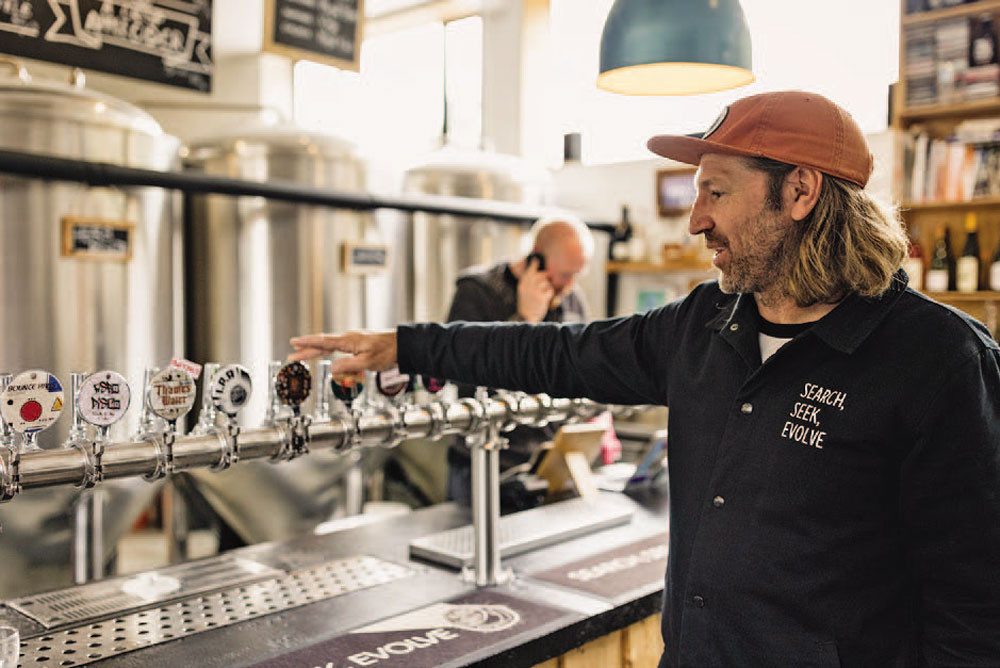
Elsewhere in the park, Remy’s fellow Flux Trail crew members, Dave McMillan and Matt Begg, were busy stacking and slapping on one of Gorge Road’s many sculpted landings. The beefed-up landings are another one of the big durability upgrades that it’s hoped will accomplish the ultimate goal of having the jumps open to more people, more of the time. In doing so it will also help to ensure the high aesthetic standard of the jumps that Nathan and others have worked so hard to achieve, is carried on as a key feature of the trails.
As well as the infrastructure upgrades, the smaller lines in the park are receiving a major overhaul, while the old wall ride has been removed with a new extension underway to push the trails further down the site. Speaking with Nathan, he pointed out that these improvements and upgrades are one stage of building out his ultimate vision for the trails, that they’ll continue to work towards in the years ahead. A big part of that vision is having a place where young riders can come and progress themselves, not only as dirt jumpers, but as all-round riders.
The Gorge Road upgrades are just one of many trail upgrades and developments that are either underway, or have been completed, in Queenstown in the past few months. Later that afternoon, we found ourselves on the Skyline Gondola sampling some of Ben Lomond Trails refreshed trails. On the topic of refreshment, we stopped by local haunt, Searchlight Brewing, on our way back down Gorge Road, to sample some of their current offerings.
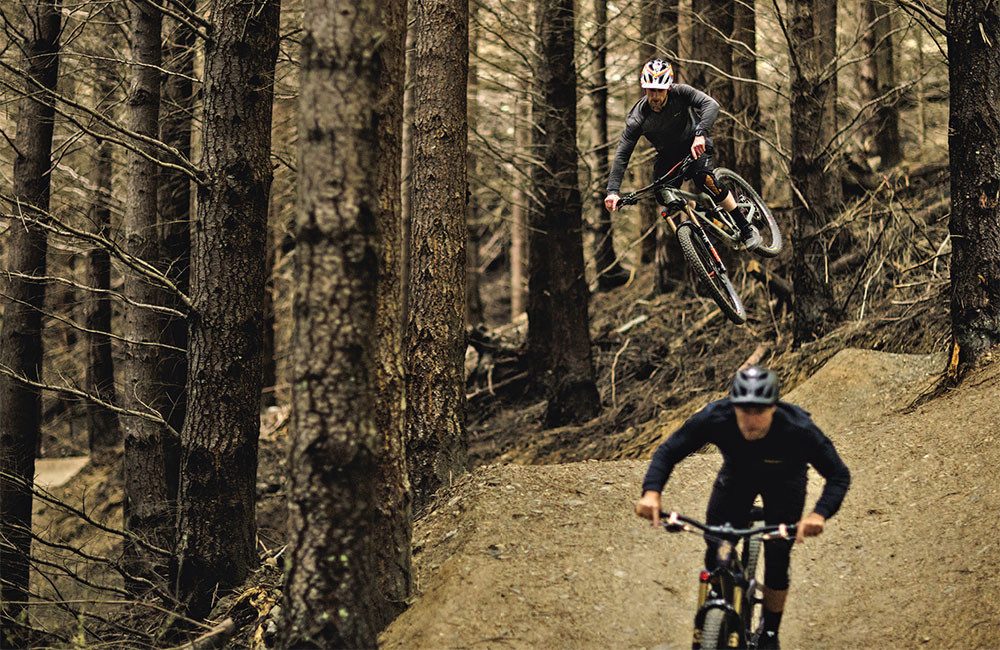
SEARCHLIGHT
In a town that’s pretty synonymous with hospitality, Searchlight doesn’t fit the standard mould of posting up on the lakefront and watching the sunset. Tucked away in Industrial Place, just up the road from the iconic Gorge Road trails, Searchlight takes a bit more local knowledge to find. With its inviting beer garden and tap-room, along with the brewery itself on full display behind the bar, it’s the kind of place you and your mates head to for a genuine experience. Speaking with Clayton, who’s recently taken over the brewery with his partner Sharon, from founder Lewis, his enthusiasm and passion for Searchlight is infectious. From comedy nights to live music and quiz nights, Clayton tells us that Searchlight wants to give the community a heap of different options to come down, hang out and enjoy some great beer.
Aside from acting as a hub for people to meet up and hang out, Clayton also wants to use the brewery to support different local scenes. A great example of this was Searchlight’s recent award-winning ‘can art’ on one of their newest Hazy Pale Ales, Ladies of Dog Town. Rather than going down the illustration style route, Searchlight collaborated with local photographer Melissa Clark and local female skaters to feature a photo of them skating down Coronet Peak’s access road. Word on the street is that another collaboration, paying homage to the Gorge Road trails, may be on the cards so look out for that at some point in the future.
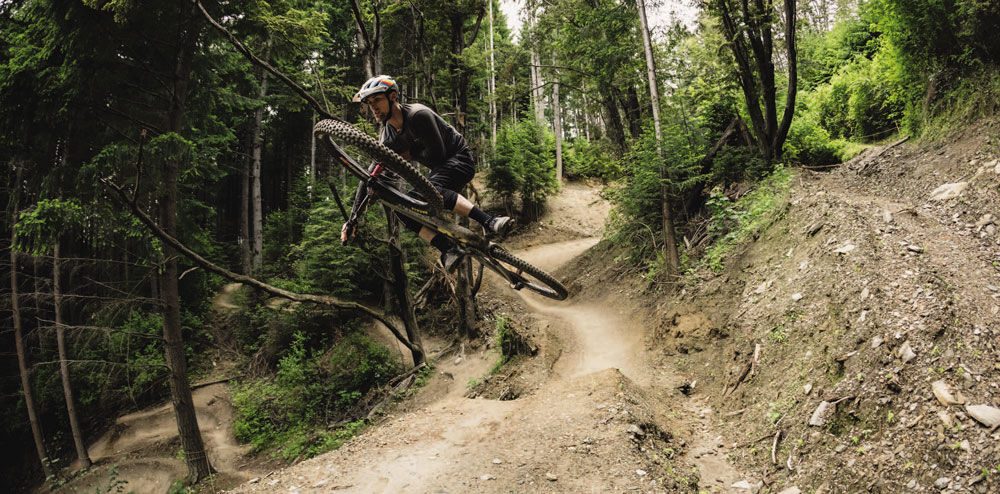
SKYLINE
After some refreshments at Searchlight (but not too much) we headed over to Skyline for an afternoon rip with Queenstown shred lord, Reece Potter. Continuing the refreshment theme, Ben Lomond Trails trails received a massive and much needed refresh prior to opening for the season. First on the list for us was the rebuilt Vertigo, littered with pull-over gap options, shark fins and deep turns. One thing I always find with Queenstown trails, especially the jump trails, is how they always seem to have the perfect shape to them. This makes them a lot more predictable and fun to hit for the first time, as you can be pretty certain about how the bike’s going to behave as you go off the lip.
After dragging ourselves away from Vertigo’s endless supply of fun shapes, we had a brief interlude down the more natural GSD. In contrast to the open, fast and flowy Vertigo, GSD offers the perfect look into the darker, rocky, rooty side of the Ben Lomond Trails. Coming from a place like Christchurch, where the trails largely turn into an ice rink after some rain, I was a bit more apprehensive about the level of grip on offer down a damp GSD, especially on a blind run. As it turned out, there was a good amount of grip on offer, and we were able to make the most of GSD’s rock laden features. Near the end of the trail, things took a bit of a turn as Cam’s camera pack took him for a lengthy roll through the last set of said rock features.
After a mandatory roll through Thunder Goat’s scenic right hander, and a quick clean-up for Cam at the top of the gondola, we made our way down to the refreshed Original trail. In the past, this trail has always been a fun but fast run down the lower part of the hill. The refreshed version feels like it takes the shapes of Vertigo, merges them with a bit of Huck Yeah and brings them into the lower part of the hill. Flowy and fun are probably the best ways to describe the new Original, and the fact Reece and I were voluntarily pushing back up for another run through the features tells you pretty much all you need to know.
After a few runs through the epic series of new turns near the bottom of KY, and the final features down Original, it was time to cruise out to Arrowtown for a post-ride beer and dinner at the Fork and Tap.
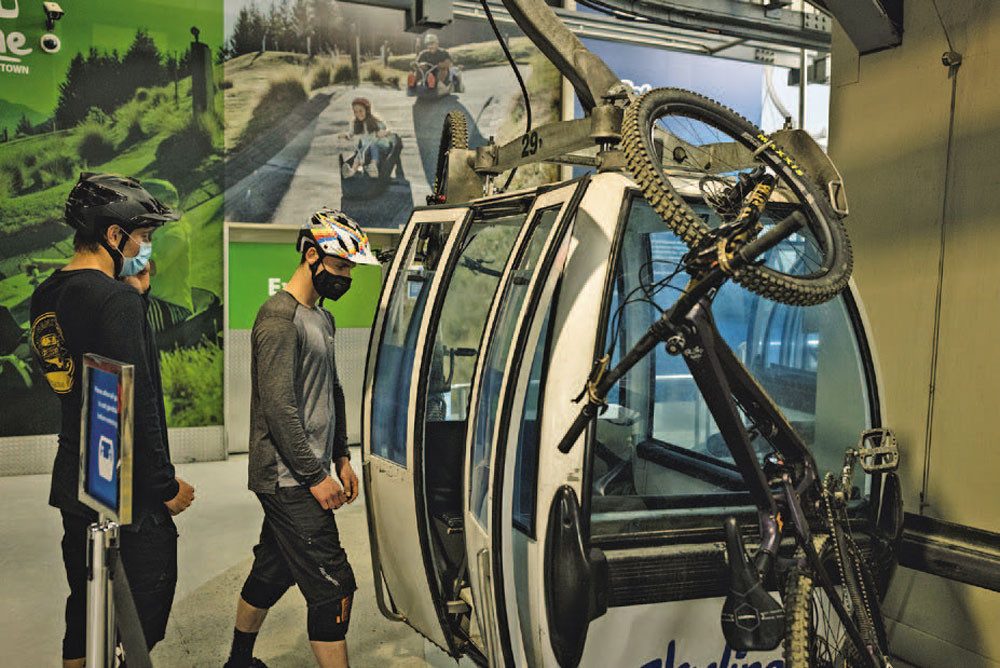
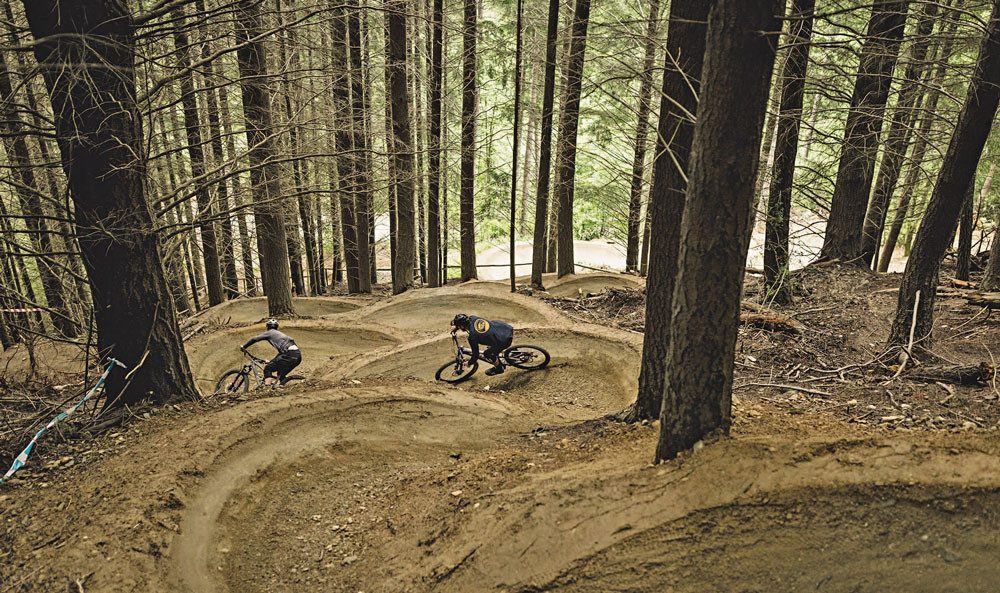
FORK AND TAP
Our original plan had been to head to the Fork and Tap via the Slip Saddle and Bush Creek tracks that end up right at Arrowtown. A wet afternoon the day before saw Skyline open at midday and this, coupled with some big jobs lined up the following day, saw us taking the scenic drive out there instead. Ideally, you’d have a run right from the top of nearby Coronet Peak all the way down to the Fork and Tap at the bottom on a warm summer evening.
Housed in one of Arrowtown’s many historic buildings, the Fork and Tap offers a great post-ride atmosphere, inside and out. After being greeted by the friendly staff, we opted for a table inside and took our picks from the great selection of beers and food as the day wound down.
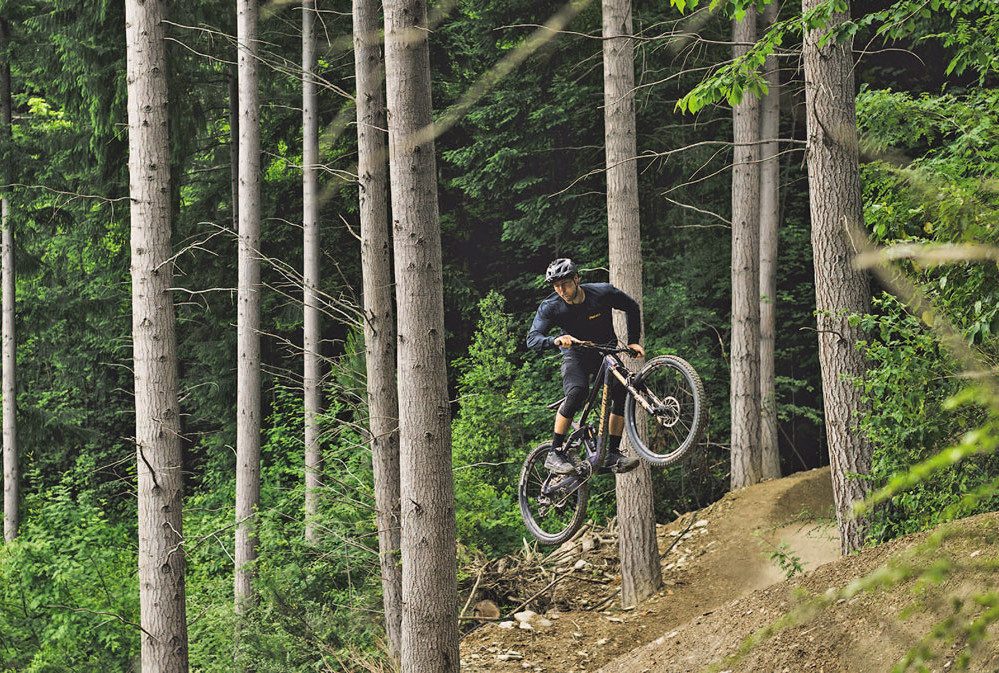
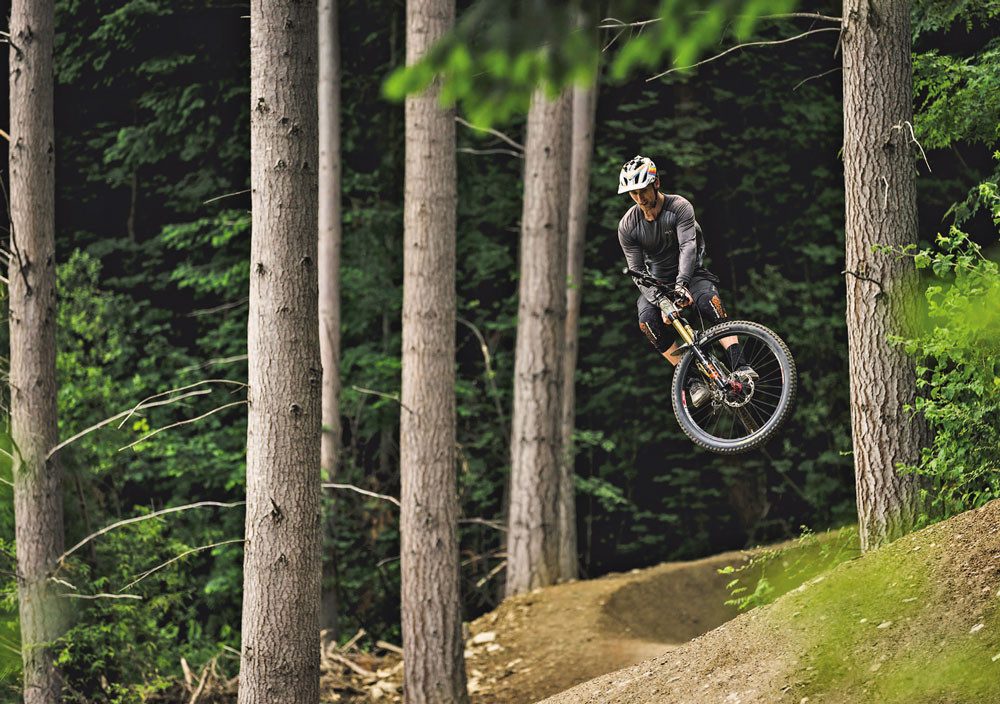
CORONET, HELI-BIKING AND FERNHILL
After easing into things the day before – in part thanks to the slightly wet start – we awoke to a sunny day and knew we were on for one. We headed out to Arrowtown to meet up with Reece before piling in the car and boosting up to one of New Zealand’s most scenic carparks, at Coronet Peak. Following through with yesterday’s original plan, we headed up to the top on the lift and made our way down the Coronet XC trail to Slip Saddle.
Slip Saddle always offers a challenging ride down and, with a little bit of moisture from the previous days’ rain, this time was no exception. After sliding our way down Slip Saddle’s steeps and gullies, we found ourselves at the top of the recently refreshed Bush Creek trail. While always offering a cruisy warm down after a Slip Saddle run, wet feet were usually a guaranteed outcome after Bush Creek. The recent work by locally based Elevate Trail Building, has added bridges, culverts or rerouting at all former crossing points, and made for a much dryer run.
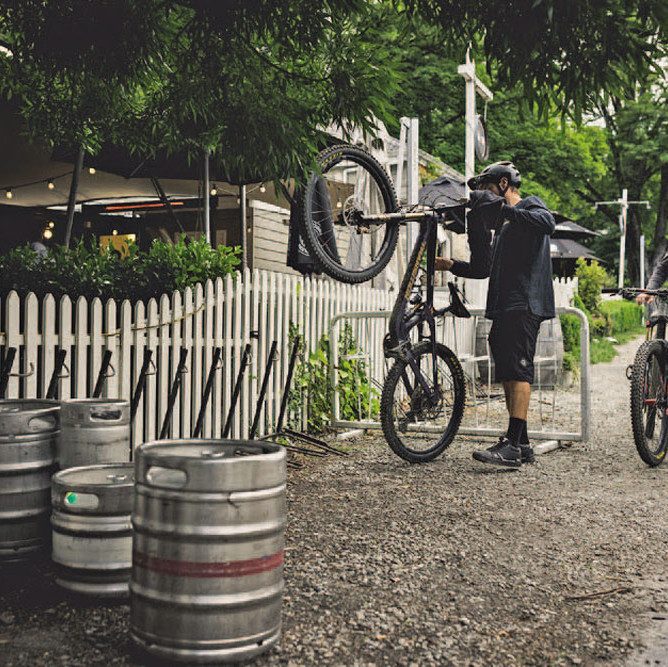
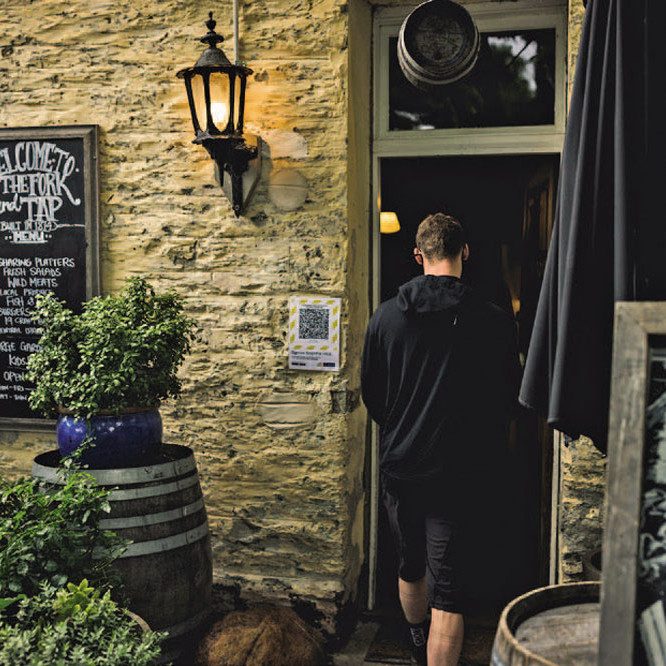
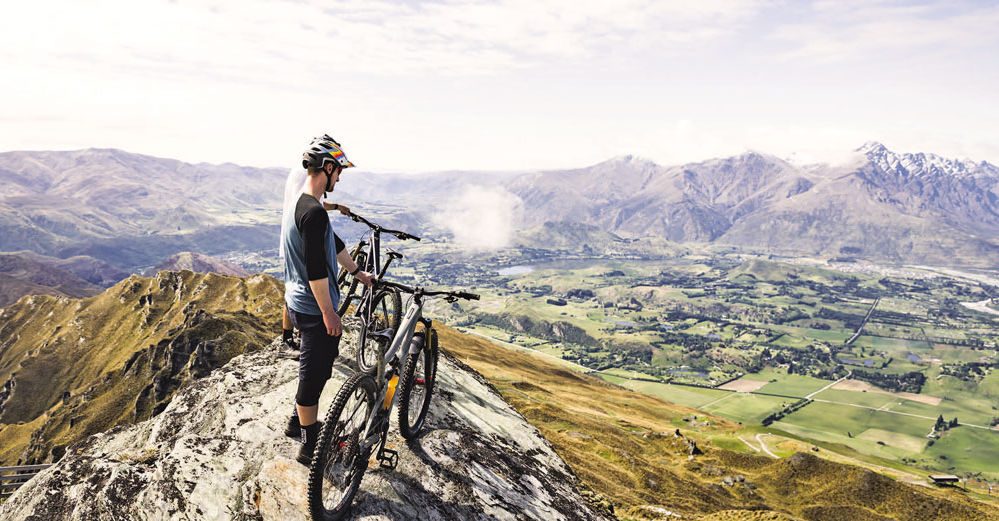
After trying out some over-under lines on a new mega- turn lower down on the trail, we cruised down the denser lower section and out to Arrowtown. The much-needed lunch spot of choice was the Arrowtown Bakery where we got into the selection of pies, ‘footballs’ and cakes on offer. Then it was back into Reece’s van and up the Coronet Road once again to get the afternoon underway.
Originally, we’d planned on riding another one of Queenstown’s newest great trails in the form of ‘Upper Rude Rock’. Wet conditions once again messed with our plans, leaving the trail too soft to open, meaning we headed straight to the existing classic, ‘Lower Rude Rock’ instead. Scenic turns, scenic straights and high speeds are all par for the course down Rude Rock, on the way down to ‘Pack, Track and Sack’. A few fun fadeaways and turns later we found ourselves in Skippers, waiting for the heli.
This was a pretty big highlight of the trip – especially as it was the first proper heli-biking trip for Reece and I, and involved an epic flight up out of Skippers to nearby Bowen Peak. Even if you’ve been in one before, the excitement of a helicopter flight never really goes away, especially in an area that scenically stunning. Run by Helibike NZ, the ride had us dropped off at the top of Bowen Peak before descending on some fresh track to Ben Lomond saddle, Missing Link and Beeched As.
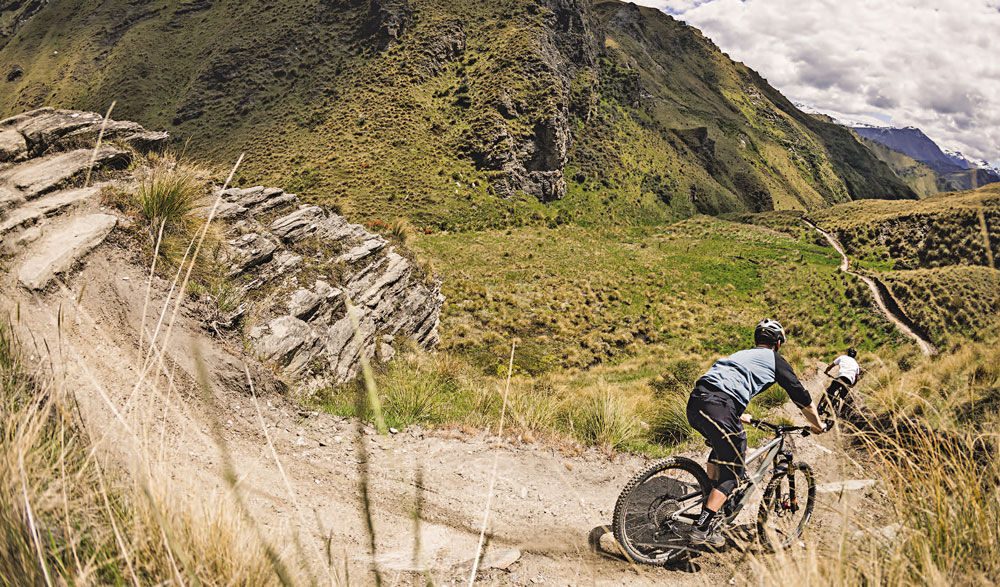
Feeling the pedal around the rest of Beeched As, after being out for quite a few hours by that point, we were hanging for the final descent back to town. Fortunately, we were treated to some epic late afternoon light out on the open part of the Fernhill descent, before plunging into the darkness of the trees. Near the bottom, we got to sample an unplanned freshening of lower Salmon Run, courtesy of heavy rain over the last two days. Although it’s something you usually wouldn’t want to happen, much of the lowest section now runs down the creek bed. This offers a few different line options and plenty of cool rock features to enjoy.
Finishing off the run with recent addition, McNearly Gnarly, and a Queenstown classic in Wynyard DH, we headed down to Atlas to cap off an epic day.
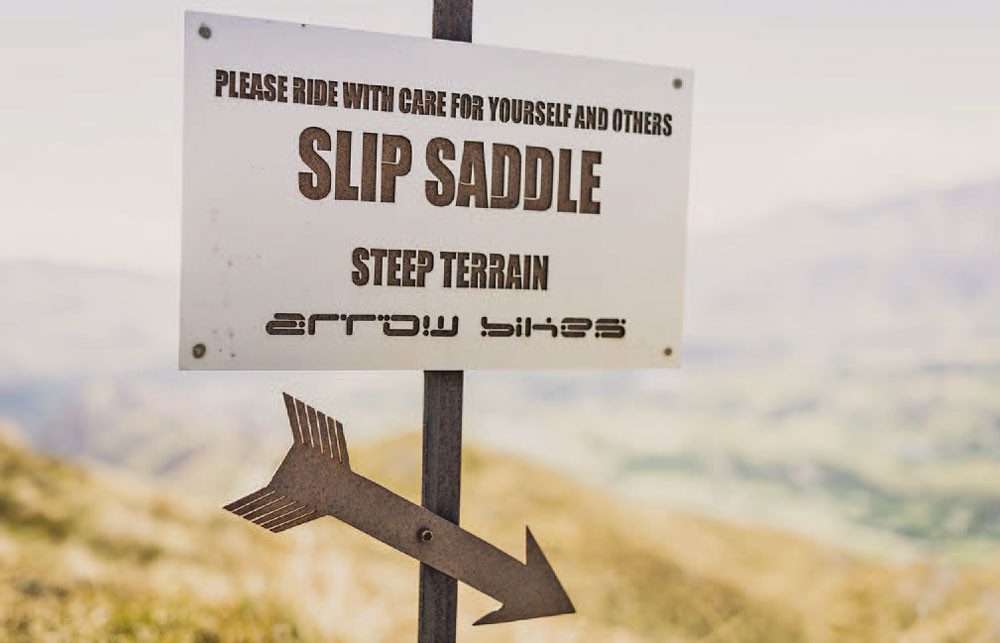
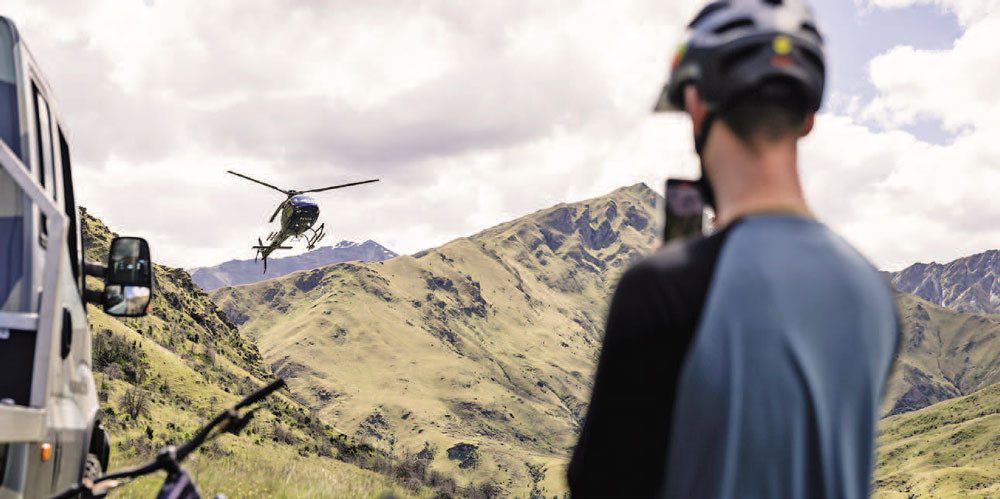
ATLAS
Finishing off a long day of riding down by the lake, with some good food, good people and one of the many great beers on offer at Atlas, is pretty hard to beat. Atlas has long been a big supporter of mountain biking and the mountain bike scene in Queenstown, through a whole raft of activities ranging from sponsorship and donations to the Queenstown Mountain Bike Club (QMTBC); sponsoring or hosting local riding events, like Season of Shred; to hosting end of season parties. A great example of this is the raising of more than $16,000 for the mountain bike club during the 2020 Season of Shred fundraiser.
Good relationships with local businesses like Atlas, and the support that they bring, has always struck me as something that QMTBC does really well. This kind of relationship and support really helps to strengthen that sense of community and the role that riding plays in it. Not to mention the activities, including trail development, that the club is able to undertake because of this support that helps to keep the scene progressing.
After going from hungry to full in a short space of time, we attempted to ride back up to the hotel to drop off the bikes before taking a sunset cruise back up to Coronet Peak to pick up the cars. There are definitely worse places to find yourself at 9:45 on a warm summer evening than up at Coronet Peak watching the basin glow in the fading light.
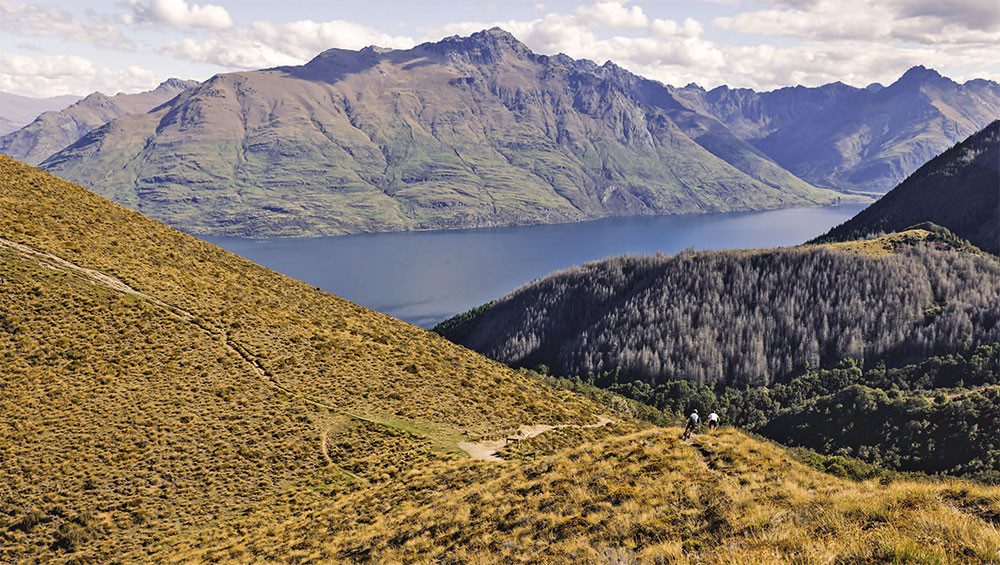
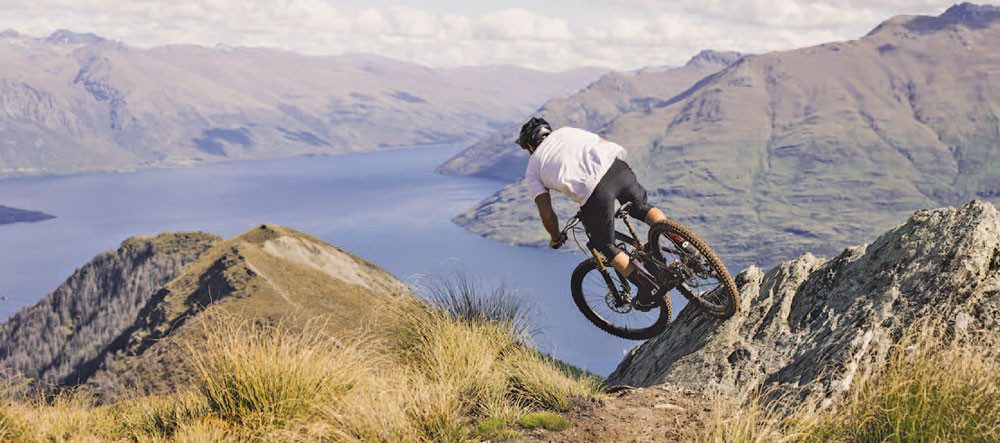
7 MILE
After the sizeable outing the previous day we were feeling pretty spent, so a cruise around at 7 Mile to check out some of the new trails was the perfect choice. Despite having been around for a while, 7 Mile hasn’t missed out on its share of the recent trail developments around Queenstown. The new Buck Land trail is the most recent addition and features a huge amount of impressive wooden features, as well as some nice natural chutes. The trail is another great example of the riding community, with support from local businesses like Altitude Brewing, getting together to build something new and different for the benefit of the local riding scene.
Once we’d checked out the range of features on offer on the new Buck Land trail, we headed down through the flowing jumps of Kachoong and Jack B Nimble. Both trails received a refresh in 2020 and offer a miniaturized bike park style alternative to a lot of 7 Mile’s more natural singletrack options. Dropping down Satan’s Corridor found us back at the lake front and ready to head back to town.
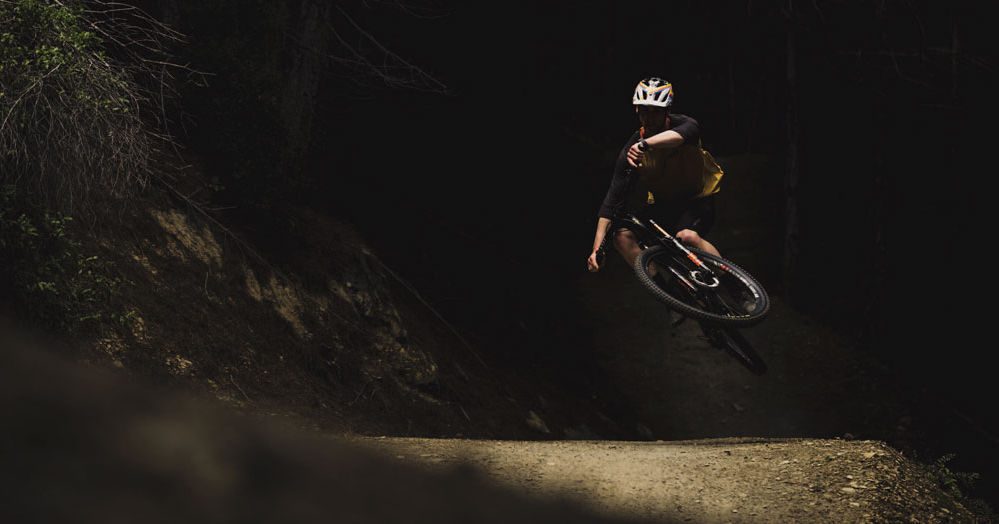
ALTITUDE, CANYON AND WRAP-UP
Our final afternoon saw us finish off the trip by checking out a few more Queenstown breweries. The first stop was at Altitude Brewing, another big supporter of the QMTBC and the mountain biking community. Having already been fans of Altitude’s beers before this trip, we were keen to visit the tap room and see what beers they had on offer.
After choosing from the varied options on the beer list, we had a chat with Altitude General Manager, Peter, who filled us in on the brewery’s identity and their community initiatives. Like Atlas, Altitude has been a big long-term supporter of the QMTBC via sponsorship and donations and even had a couple of QMTBC contribution awards on display in the tap room. Peter also explained to us that since its inception, Altitude has committed to donating a share of beer sales to a range of community organisations and groups, such as the Kea Conservancy Trust and QMTBC.
In a similar sense to Searchlight, Altitude prides itself on being a great community meeting place where people can come down and hang out in a relaxed atmosphere. With the brewery being visible from the tap room, and old kegs used for seating, there’s a nice sense of getting the product straight from the source. Peter told us that this down to earth community atmosphere, coupled with great beer, are core values for Altitude and something they always strive towards.
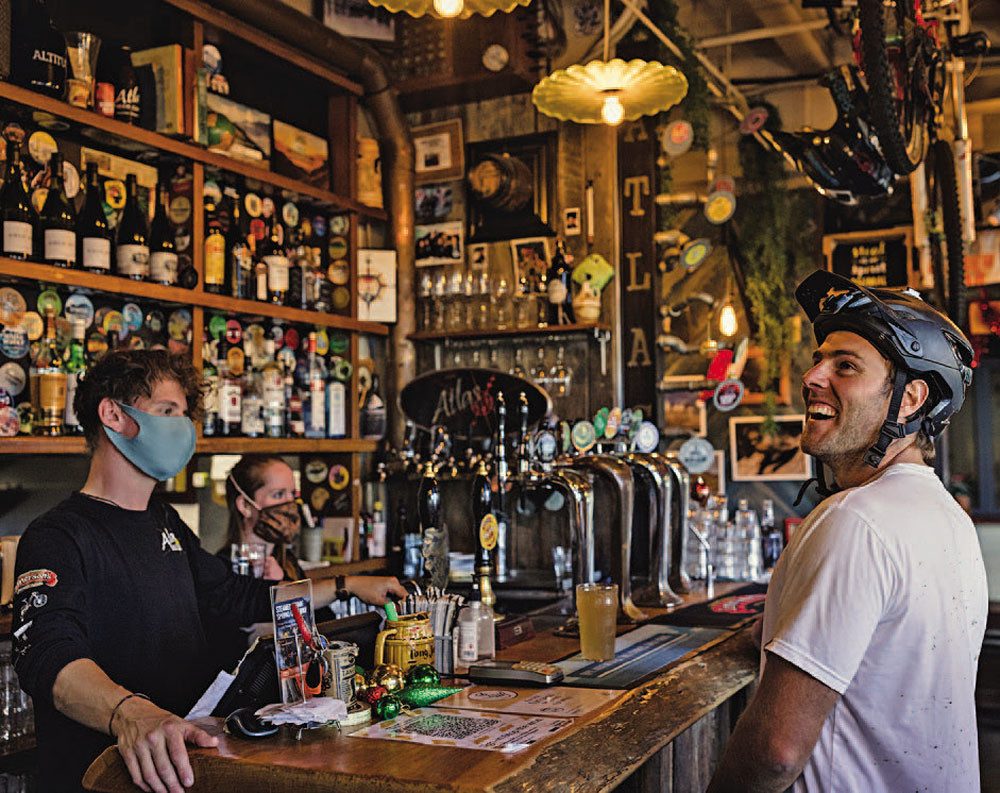
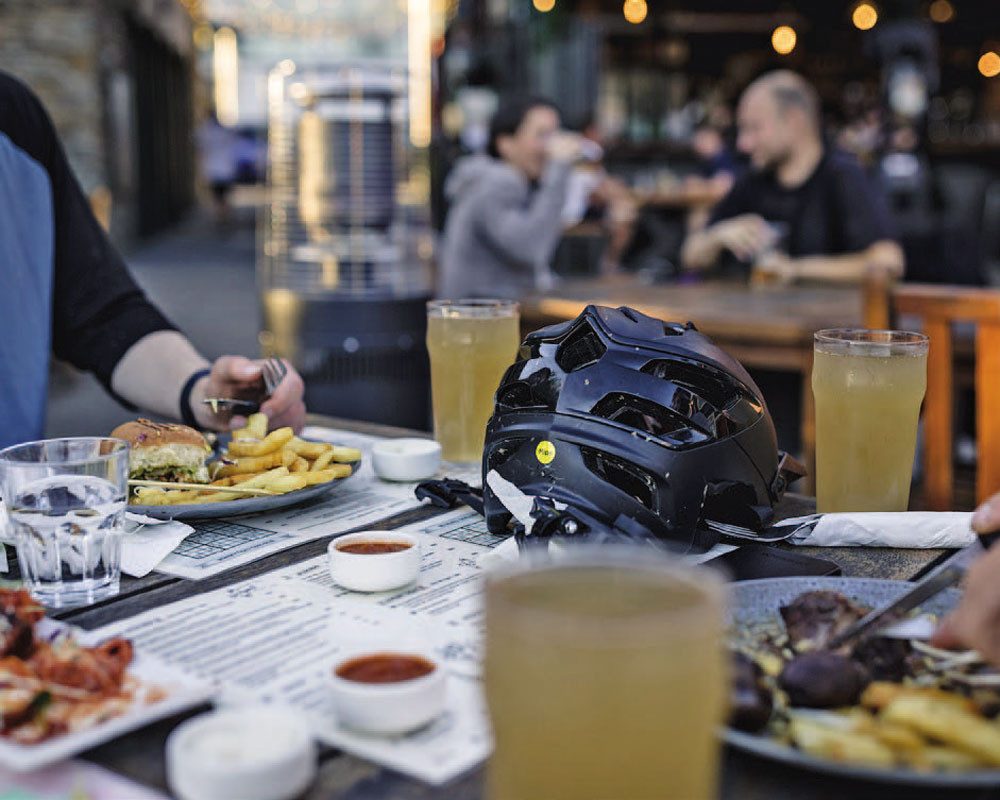
To finish things off, we cruised out to Arthur’s Point based Canyon brewing, sitting right next to the Shotover Jet. Relaxing in the sun in Canyon’s beer garden, with pizzas and a pint, was a nice way to finish off the trip. With so much great riding, backed up by a strong riding community and supportive local businesses, it’s easy to see why so many people are drawn to Queenstown as a riding destination. At the end of each trip, you always leave knowing that the next time you visit there’ll probably be another epic trail to ride or fun jumps to hit. It’s that kind of progression and development that keeps you coming back for more. •
• Thanks to: Destination Queenstown, Holiday Inn Express and partners.
Words: Nathan Petrie
Photography: Cameron Mackenzie
Story: Bosch's 'e' Evolution
Bosch’s ‘e’ Evolution
The visionary Robert Bosch always appreciated the advantages of the bicycle. From 1890 onwards, the Bosch company founder visited his customers in Stuttgart on a modern “low bicycle”, which was still little-known in Germany - penny-farthings were fashionable in continental Europe at the time. Robert Bosch relied on technology that he considered to be future-proof and forward-looking. In 1923, Bosch introduced to the market a dynamo light for bicycles - it comprised a generator and a headlamp, with over 20 million units produced into the 1960s.
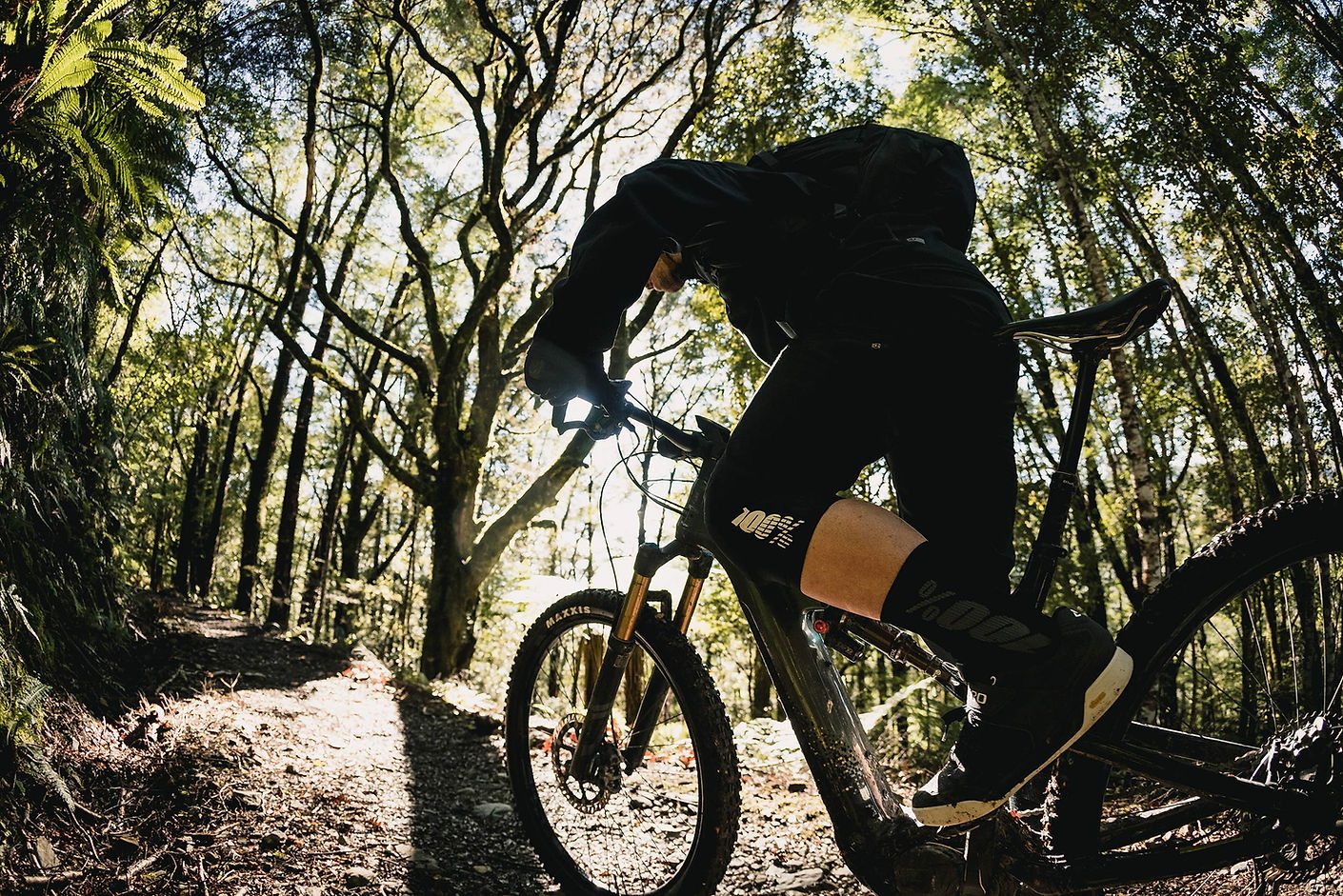
Fast forward to 2009, the bicycle once again became a focus for the Bosch Group, this time in electrified form. In the last few years we’ve played, reviewed and ridden more and more Bosch powered eMTBs. We thought it was about time we reflected on their history as we mark our historic 100th issue. A few weeks back I caught up with Dave Howard, Head of eBike APAC at Bosch, based in Taiwan. We’ve met in person before, but this time it was across digital means for obvious reasons. In fact, he was based in China but recently Bosch have moved offices to Taiwan to get closer to the brands and the assemblers.
Dave explained; “Back in 2009, it was just a handful of guys. First it was a hybrid with Mercedes Benz - it was a bit of a Frankenstein.” Bosch was, and has always been, around service first - following in the footsteps of their automotive division. “We never thought eBikes would have this much success.” In 2011/12, serious production began around the commuter space but Bosch had nothing in mind about eMTB. It strangely enough came from Taiwan, some of the cycle industry wanted to adapt it into MTB. As the industry always wants to push forward, a prototype concept was brought about. The tinkering began and the adaption of electric to MTB’s was made. However, it was still a prototype and a long way off from being available on the market.”

A few years later, in 2014, the Bosch bicycle team was around 150 people. The business expanded for the global market. Bosch has staunch stance on supporting growth of OEM’s (Original Equipment Manufacturer) especially in North America. Of course the rest of the world matters, but North America is strategically important moving forward. At that time there was only handful of brands in the eMTB game.
Dave says; “IBD’s (Independent Bicycle Dealers) are the gatekeeper to the market and some of the IBDs sold throttle-based bikes without service. At that time there was push back from IMBA. Talk was about how these bikes would destroy our sales with ‘normal’ bikes. So, we needed to develop a strategy around this. It was a challenging time, there was a real stigma around it being lazy.”
When asked about our market, Dave says: “NZ was a surprise for Bosch as they were fast adopters, actually the market demanded Bosch came into the market sooner rather than later.” Bosch had to make moves quickly to keep up with the demand. “[A speed of] 32km per hour was a key thing and the importers asked Bosch to come into market. In NZ there were no barriers except getting product into the market.” I ask whether it will slow down? “Growth projection for NZ is starting to slow a little, however they predict around 13% growth over the coming years.”
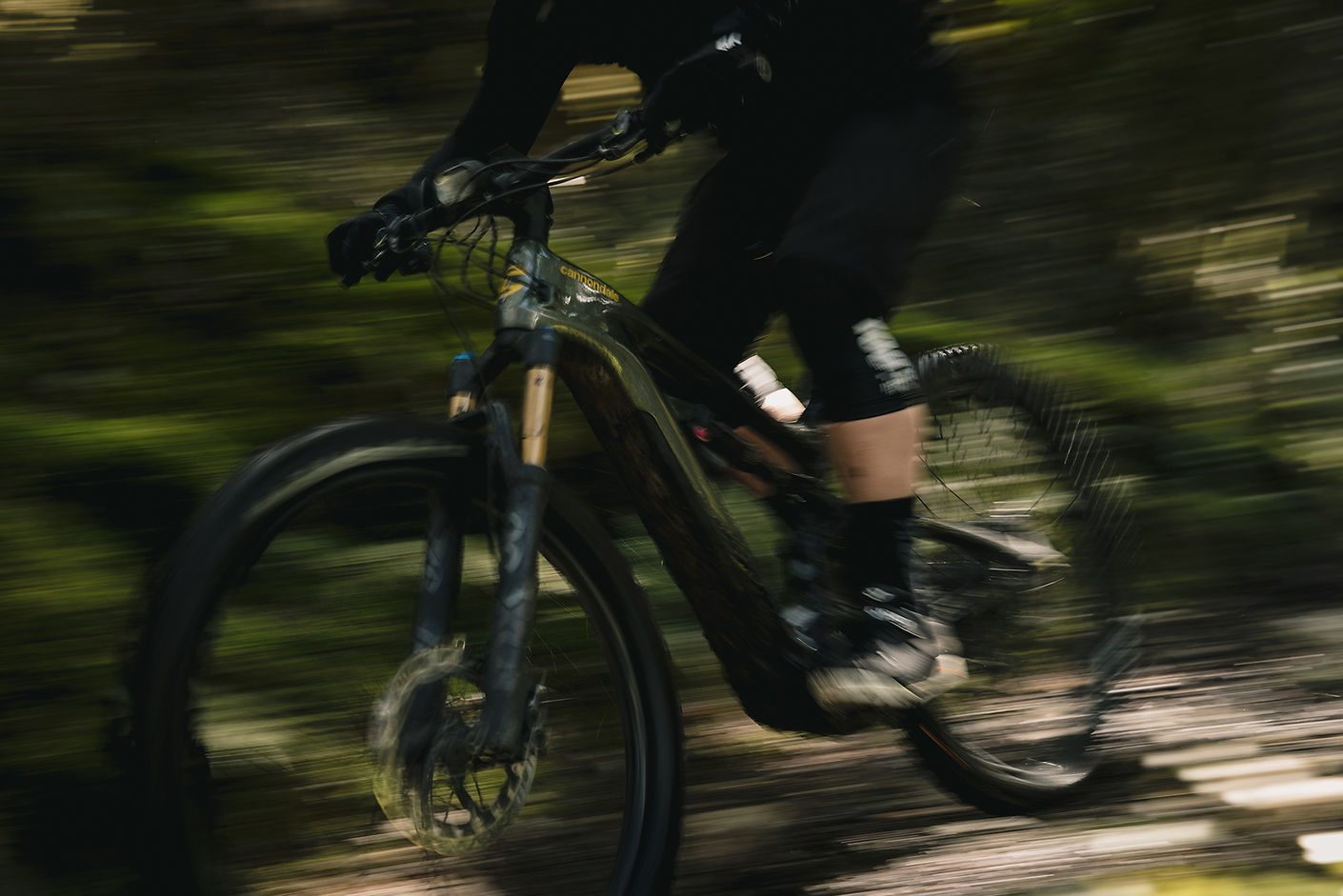
Over the years, Bosch has seen their eBike consumers change. The average user when they first launched was the Baby Boomer but, in more recent years, they’ve seen the age group drop down to the mid-thirties. It seems the trend is catching on. This is helped by their expanding portfolio of brands, rather than just being niche. Consumer perceptions are key and driven with top-end brands entering the category. In recent years, the smaller boutique/niche brands have adopted it, so in essence this makes it a more acceptable part of the mountain biking culture. Dave says, “it’s gone from niche to mainstream. There’s now an overpopulation of the category with a huge demand. It (eMTB growth) is supported by not only Bosch, but other brands that are driving the scene.”
Moving to the current decade, the eBike division at Bosch has expanded to around 500 people, and Bosch has around 70 brands using their product. Dave explains, “the aim is to have a team that’s small and agile.” Well, with a year most won’t forget, the adaptability of any business will be the key to future prosperity. I ask about what the future holds for eBikes? “Light eMTB will be the key; high-end bikes will remain but there’s a key to getting more people on bikes and involved with the sport. Design integration of battery and drive unit together. This is why we built a purpose-built drive unit so it could be a proper feel. There’ll be more innovating and refinements.” However, I want to know if they can extend the range of the batteries, as this catch up was just after our Old Ghost Road escapade (story in this issue), where we ran out of range. “There are limitations with batteries, if you increase the range then you need a bigger size and it’s a challenge with frame designs. If you want more range, then you need more space.” Back to the topic of the future. “Pre COVID 19 it (the future) was bright, and post it’s blinding, but we will need to step forward with caution. eMTB’s will continue grow, especially as the brands we all know and love have more offerings within the category. We aspire to have a more natural feel and for the bike not to feel like a powered bike. The future is a super clean handlebar set up. We will continue to promote trail building and development.”
Words: Liam Friary
Images: Cameron Mackenzie
Story: Behind the Brand with James From earSHOTS
earSHOTS allow riders and runners to take their love of sound to extreme places. These unique headphones stay secure no matter what the environment demands – from back flips at the park to the steepest descent on the trail. Made for adventure and exploring, these headphones are the ultimate accessory for those who want less distraction whilst listening to music or podcasts while they do what they love. We wanted to find out more about the story behind the brand, so we fired off some questions to earSHOTS founder, James Bell-Booth, to get the inside scoop.
NZM: Hey James, can you tell us what your original inspiration was, for earSHOTS?
James: I was training for an adventure race called the T42, in New Zealand’s beautiful Tongariro National Park. While training, I got fed up with my earphones: they fell off, got dislodged, and constantly needed re-adjusting. This resulted in frustration and distraction. After trying every earphone on the market at the time, and not finding anything that could stay in and feel comfortable while still sounding good, I came up with the idea of a new earphone design that would use magnets to attach to the ears. A design that you would fix to your ear – and forget. That was seven years ago…
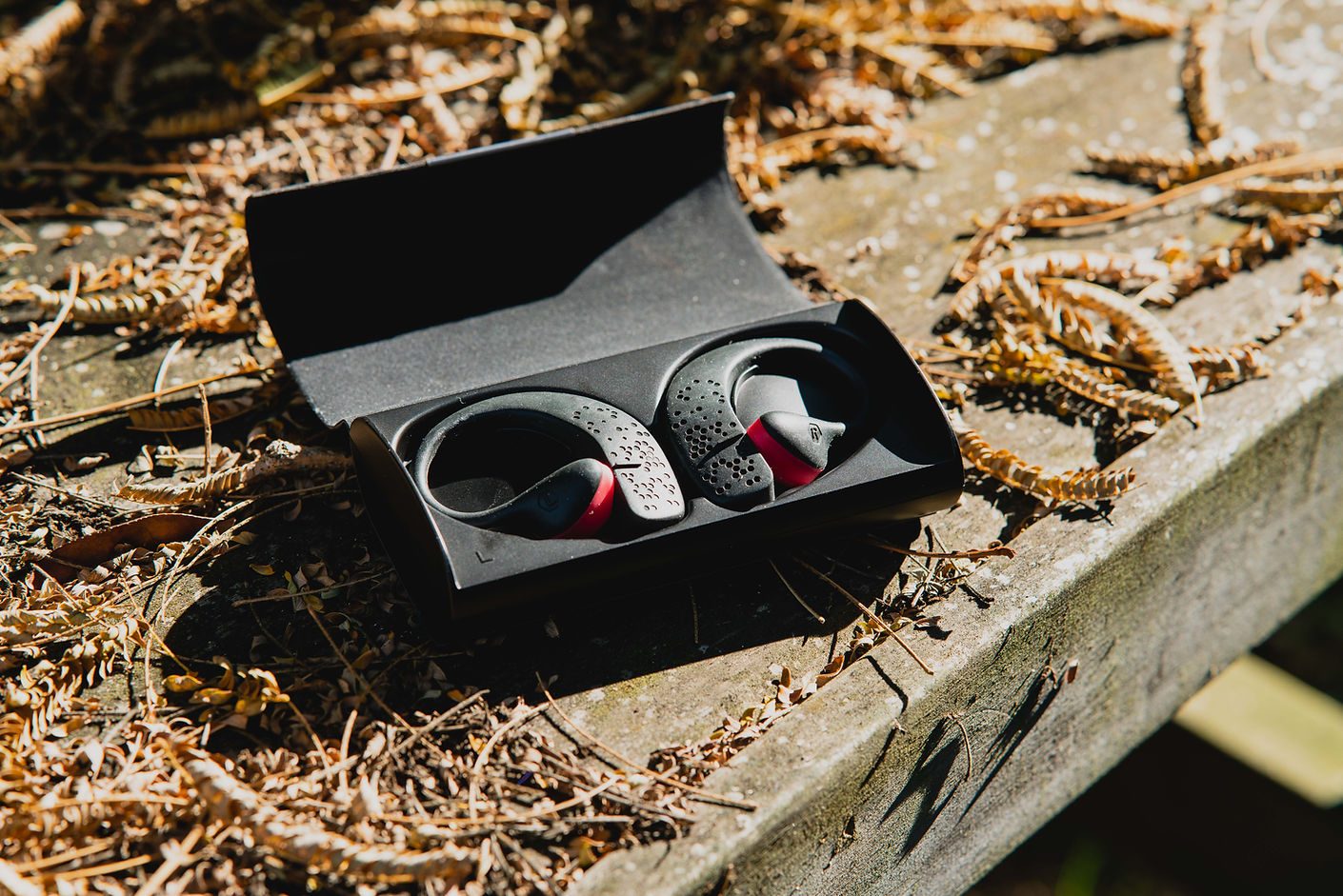
NZM: How long did you take to come up with the idea, design it and get it to market?
James: It wasn’t overnight, that's for sure! There’s been home re-mortgages, many late nights teaching myself how to hand-mould magnets, thousands of hours on the trails testing all aspects of earSHOTS – and that’s all before we went on the market in April 2020.
NZM: Who are earSHOTS designed for?
James: First and foremost, they’re for riders and runners who love music, but hate being distracted and annoyed by earphones falling out or requiring constant adjustment.
NZM: What is the best piece of advice you’ve ever received?
James: Just focus on putting one foot in front of the other – the results will look after themselves.
NZM: How long have you been riding and what sort of riding do you enjoy most?
James: I have been riding since I was about 16, with varying levels of intensity. I used to live at the foot of the Kahuterawa Valley. When Arapuke bike park wasn’t even a thing, we would ride up the road to the trails in the pine forest. On the way back down the valley we would stop at the swimming hole – the Bull Hole they called it – and cool off. It was epic. Unfortunately, they subdivided the land and now you can’t swim there. Classic bloody property-obsessed people ruining the old school Kiwi experience!
NZM: What’s the craziest or most backcountry place you’ve taken your earSHOTS to?
James: Where I have been is nothing on where I am seeing our customers take earSHOTS – including over the Southern Alps and even down to Antarctica.

NZM: Best playlist/podcast for listening to through your earSHOTS?
James: I love all types of stuff, depending what mood I am in. Our earSHOTS ‘blood, sweat & sound’ playlist on Spotify is definitely a go-to. Then for podcasts, I listen to everything from current affairs stuff, personal growth stuff and even a bit of philosophy. On my library right now you will find Downtime, the Mountain Bike Podcast, BBC - The Documentary, and the Robcast, which is a philosophy type vibe.
NZM: Finish this sentence: As soon as I’m out of lockdown, I’m going to…..
James: ....the beach. I find the ocean super therapeutic.
NZM: What’s next for the earSHOTS brand?
James: See my answer to question four! Touch wood, we have some really big hopes and dreams for earSHOTS. The big focus is making earSHOTS the best sound experience for riding and running in the world. We have been working on a few things and will look to share those with our community of customers and partners pretty soon.
NZM: Outside of running a successful company, and mountain biking, what can we find you doing most weekends?
James: It’s pretty hectic, I am not good at sitting still.... I take the kids riding; I recently purchased the ‘Kids Ride Shotgun’ seat for my three year old son, Ben, which he is stoked about. I try and get out for a surf as often as possible, which involves a two hour+ drive to anywhere decent. Then outside of that, chilling out with mates and family.... I have three kids, so they are always wanting to do something which keeps life pretty full on. I wouldn’t have it any other way, though.
Story: A Nelson Underdog
Wairoa Gorge is, to many people, some of the best riding in New Zealand – perhaps even the world! And it has a story to match; one that has been told again and again, without growing old. One story that is yet to be told, however, is that of Nelson’s newest trail network out at Cable Bay Adventure Park.
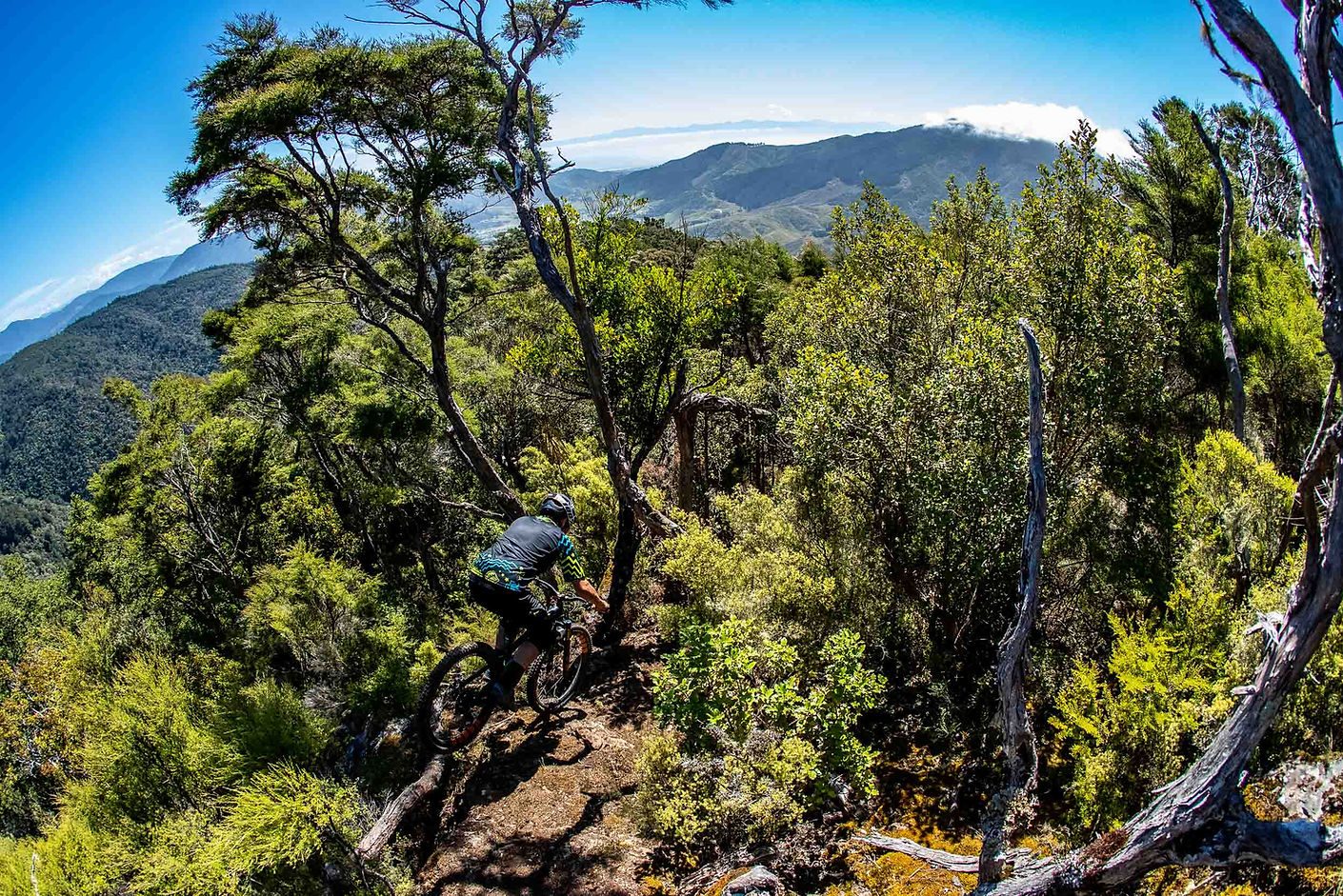
The story, as well as the park itself, is a work in progress as the park has not yet officially opened (update as of time of publishing: Cable Bay is open for mountain biking!) as a mountain bike destination. It does see well over 150 daily visitors throughout the peak season though, who go quad biking up the many forestry roads, horse-trekking through the native bush, challenge themselves on an archery dragon hunt, shoot across the valley high above the canopy on the SkyWire, and enjoy the mouth-watering delights of the Base Café. Basically, it’s a pretty busy place.
As you’d expect, this hasn’t stopped the MTB community whatsoever.
It all began with Richard and Elina Ussher, a well-known adventure-racing couple - the epitome of fitness and adventure teamed up with fantastic personalities. A strong indication of evolution having peaked, as they also happen to be ridiculously good looking. Having travelled the world in pursuit of challenging adventure, Elina and Richard were both well accustomed to risk and dealing with uncertainty, yet their biggest adventure to date was to happen much closer to home when they took over Happy Valley Adventures and turned it into Cable Bay Adventure Park in December 2017.
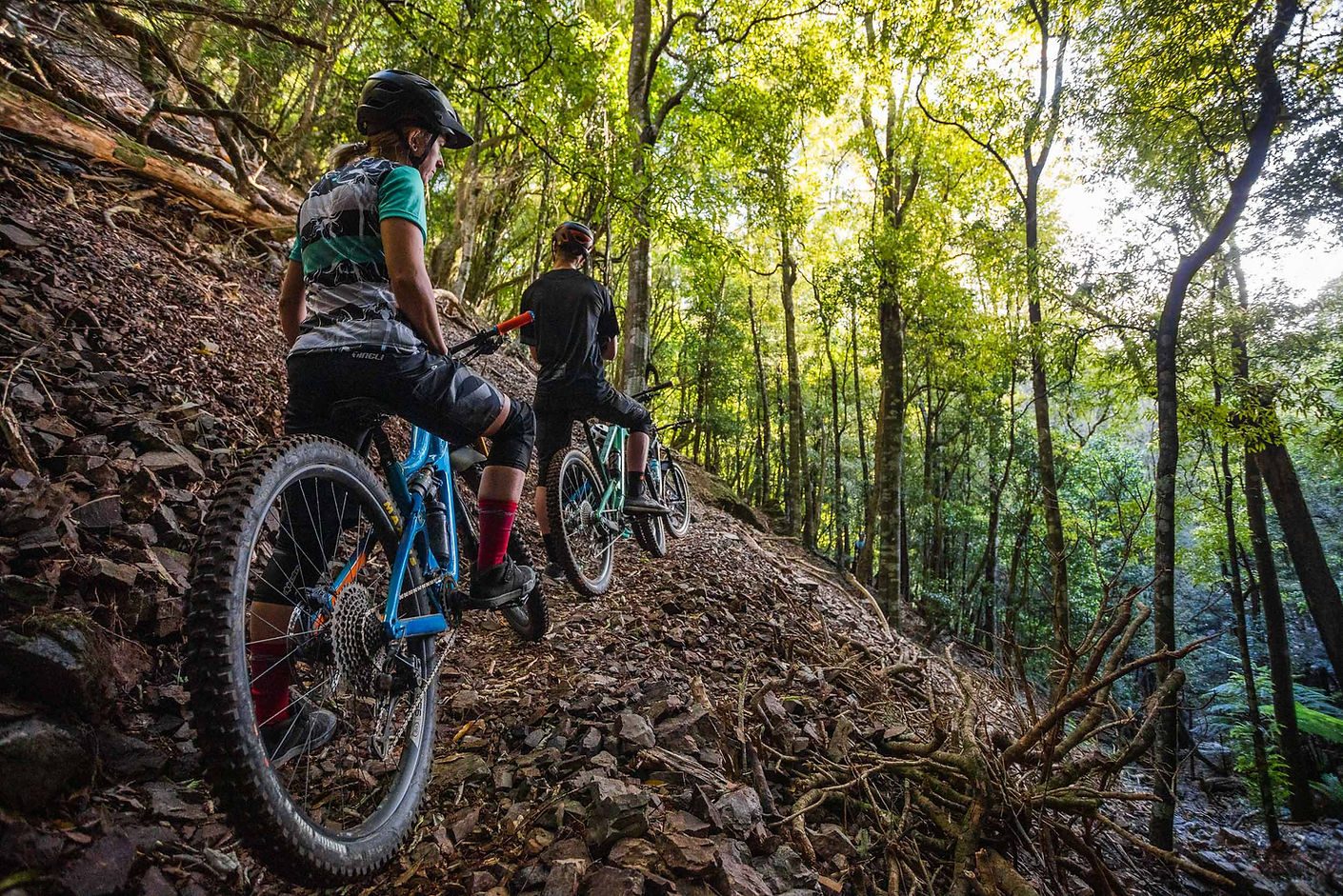
It wasn’t long before Richard, staying true to his adventure-racing background, had run up, down and across the 500 hectare property enough times to have a pretty good idea of where he wanted tracks built. After joining a couple of the local Super D races in Nelson, organised by Loui Harvey, Richard was keen to show Loui around. Now, for you guys who know the two of them, you can only imagine the sparks that flew that evening in the forest when Mr Enthusiastic met his equal in Mr Grand Plans. For you guys who don’t know them, imagine Chip and Dale - on steroids - if the two chipmunks were of completely different builds and backgrounds.
Trail building took off properly in October 2018, once Loui returned from a six-month overseas trip, racing the EWS. After a month of weekly night-digs, there was a group of 10 or so members who were to make up the core group of the operation. These guys didn’t only show up during the lovely summer nights with never-ending light, but also throughout the dark, wet and cold winter months, to get the job done.
Richard describes the decision to buy the park as a “calculated gamble”, so the first ever single trail out at the park was named, and is now affectionately known as ‘The Gamble’. The team, despite their occasionally unfavourable working conditions, seem to all keep turning up – being generously fed and hydrated post-digging has certainly contributed to this kind of commitment and vibe; a vibe worth returning for. I’ve been there; I’ve heard them all tell the stories about the size of the rock they moved off the track - much like a great fishing story, the hands get further and further apart with each rendition. Eventually, winter turns into spring and then summer, one track turns into two and then five.
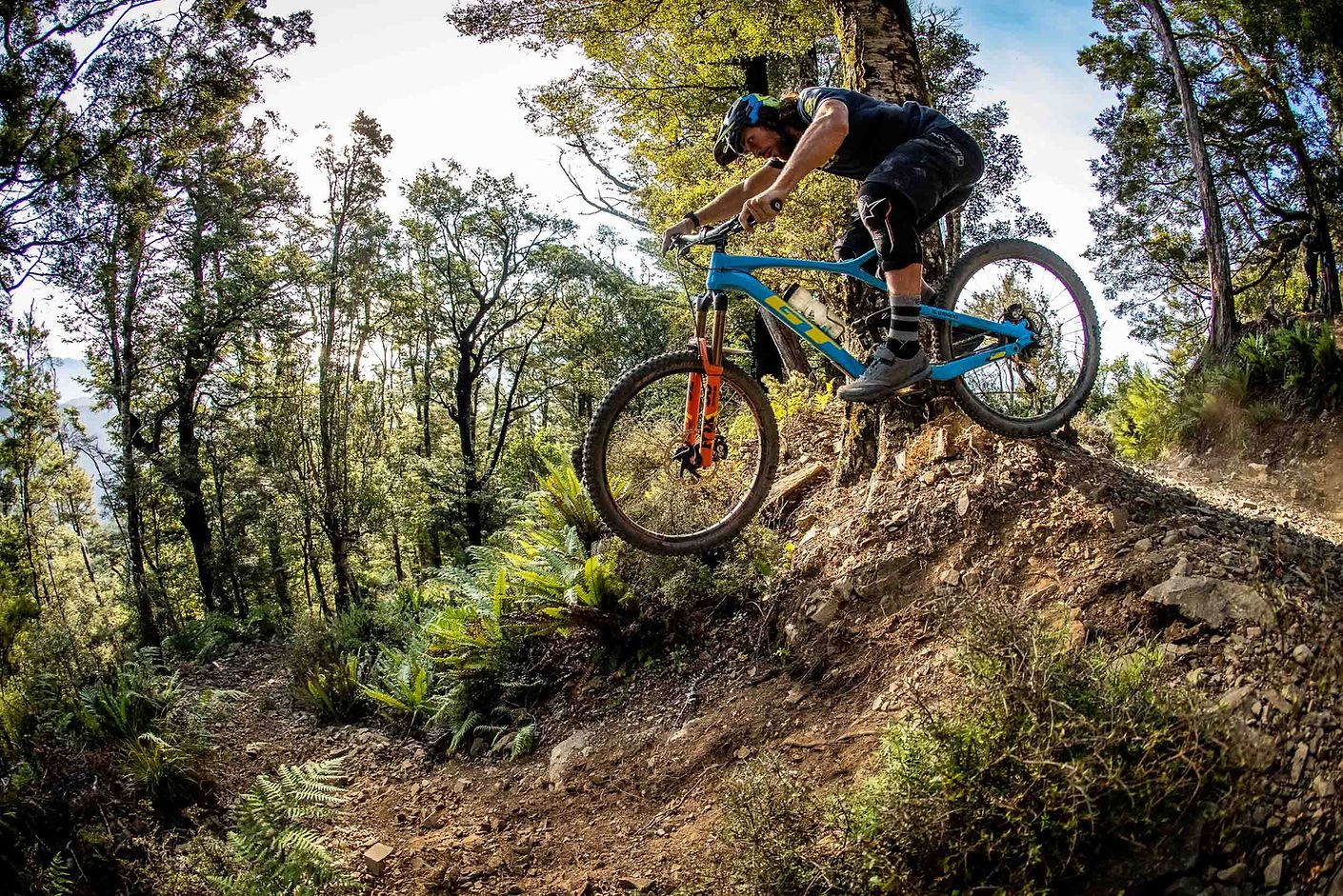
Fast forward to summer 2020 and, after a life-changing ride in the Polaris uphill and an eventful skidfest following Sven Martin, Sweden-based kiwi Steve (@stevesmurfy) Murphy claimed that The Gamble had landed in his top five tracks ever ridden. You guys who know Steve are probably aware he is easily excited when it comes to riding bikes down a hill, but you’ll also know he has ridden his bike on a lot of trails around the world so I will claim it for the purpose of this article. The face of Loui, who has managed the trail building efforts and, along with Richard, has marked out where most of the trails will go, lit up upon hearing this and replied: “You just wait ‘til you ride Jurassic!”
Climb aboard the Polaris to smoothly Segway up the steep, baby-head-littered forestry road to the same starting point as The Gamble, enjoy a second go at the log drop and the rocky chute - but for goodness sake do not pedal that short climb again! Instead hang left into a different world. It’s here you might find that, unless The Gamble converted you already, you become slightly religious…. OK, at the very least you’ll find it pretty cool. But, don’t go ahead and peak prematurely; I haven’t even started talking about the trail itself yet. The aptly named Jurassic is carved out amongst giant pungas, mighty natives, dramatic shapes and a multitude of dark green shades that will have you imagining that you’re riding alongside a shrieking T-rex with abnormally short arms. This could just be Loui, but you won’t know as you’ll be too busy managing your trail-froth. After negotiating unexpectedly well-built corners, rowdy rock turns, Chiliean anti-grip like dust, into off-camber anaconda roots for 600 metres of vertical descent, you won’t mind that gentle pedal out along the creek to get all your ducks back in a row.
Next up, the Cable Bay DH track. Starting with a no-fuss firebreak, straight-line into the pines before you hit the road gap that drops you into one of the few sections of natives, after which you’re on your own in the open with nowhere to hide. By getting increasingly steep, the trail will ensure you stay on your game. A 10 minute, on-demand shuttle will have you back at the top so you can do it all again.
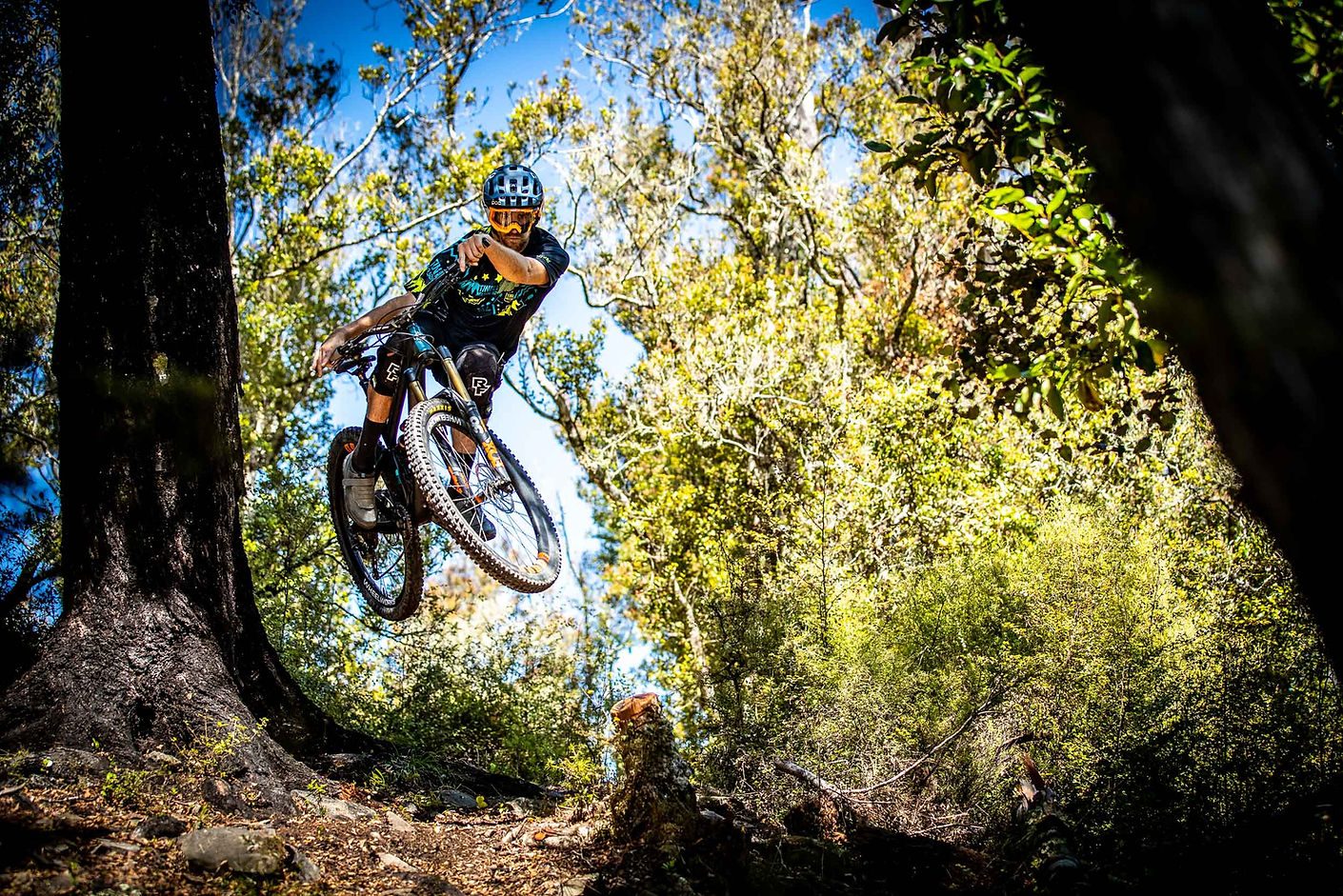
If, however, these grade 4-5 trails do not appeal to you in any way, you might be more interested in the fact that the shortest pedal takes you to Formula 1; a wide, flowy, digger-built grade 3 that lends itself nicely to smashing out a few laps. Whilst talking about laps – one of the many grand plans for Cable Bay, is a trail following the perimeter of the park creating a nice, long (not to mention, scenic) loop to ensure there is something for everyone.
Having been created by – and for – the community, Cable Bay Adventure Park has already landed firmly in the hearts of locals and, through its easy access, is now gaining traction both nationally and internationally. What can I say? Everyone loves an underdog!
Words: Jess Enlund
Images: Sven Martin & Henry Jaine
Story: Life according to Justin Leov
Life happens at a million miles an hour for Justin Leov. In that respect, not a lot has changed since his days racing the World Cup downhill circuit. The day we meet, he bowls up to the airport pickup zone, chucks the window down, then leans out and asks if I’m Liam. I reply, ‘yep’, so he leaps out and gives me a stern handshake - you get a lot of these in the south. Justin hails from Blenheim, which is at the top of the South Island, New Zealand. We throw my bags in the back of his pickup and head to his digs.
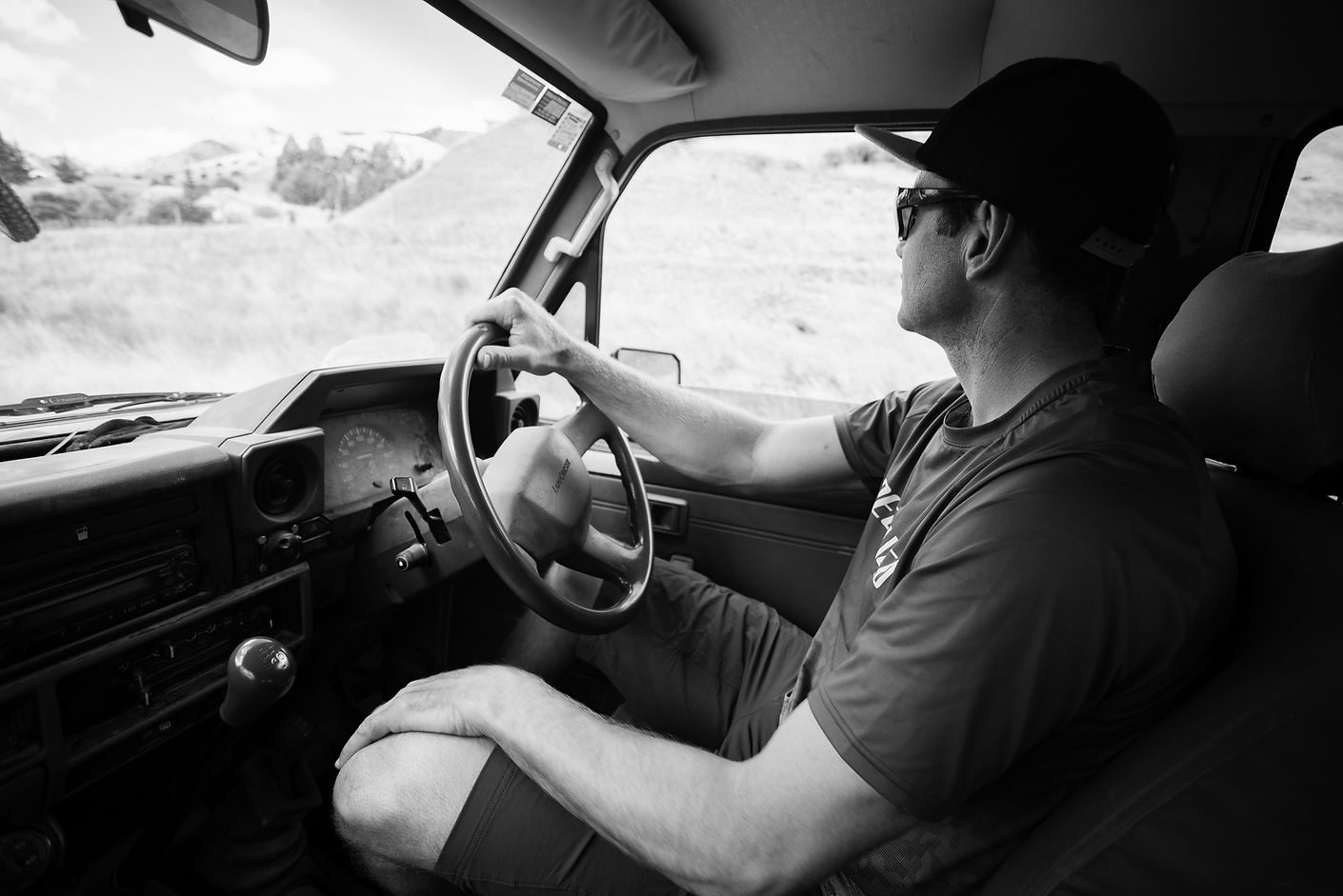
During this short ride, we cover most riding topics - and give the president of the local mountain bike club a call. I get the gist that Justin is always ‘on’ – his hustle is relentless. Our chat is mostly about bikes – and rightly so, as he’s made a bloody decent career out of racing them. But, more on that shortly. Justin’s stories, and his ability to relay them like they happened yesterday, is incredible. I scramble to take notes or record some of what he is saying, as we leap from topic to topic. Being in his company, you get a real sense of Justin’s energy and enthusiasm for the sport, and immediately I can see why he’s done so well.
After traversing some dry and dusty gravel roads, we pull into Justin’s property, Jentree. There’s a country-style house, a barn, a river, and a steep hill that sits behind the house. We jump out of the pickup in front of the barn, which is littered with property maintenance gear, bike paraphernalia and the old-school Land Cruiser he uses for shuttles up his hill. The race plates from his racing days are scattered all around and there’s even a wall dedicated to them. From Downhill, EWS and Crankworx, there’s either a race plate, medal, trophy or cheque (you know, those large, novelty ones). It’s evident Justin has excelled in his chosen sport, and I’m blown away by how much mountain biking history is encased within his barn.
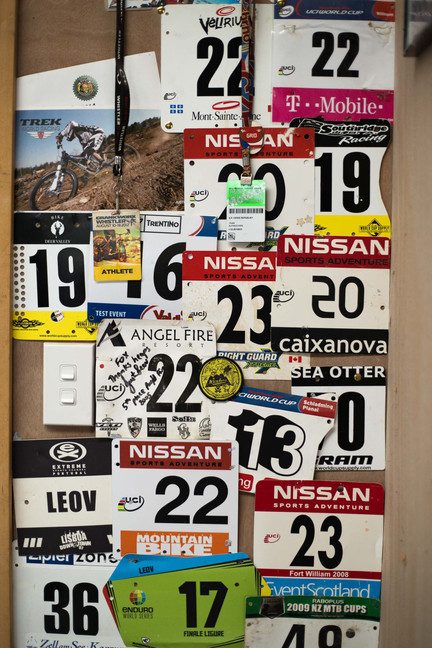
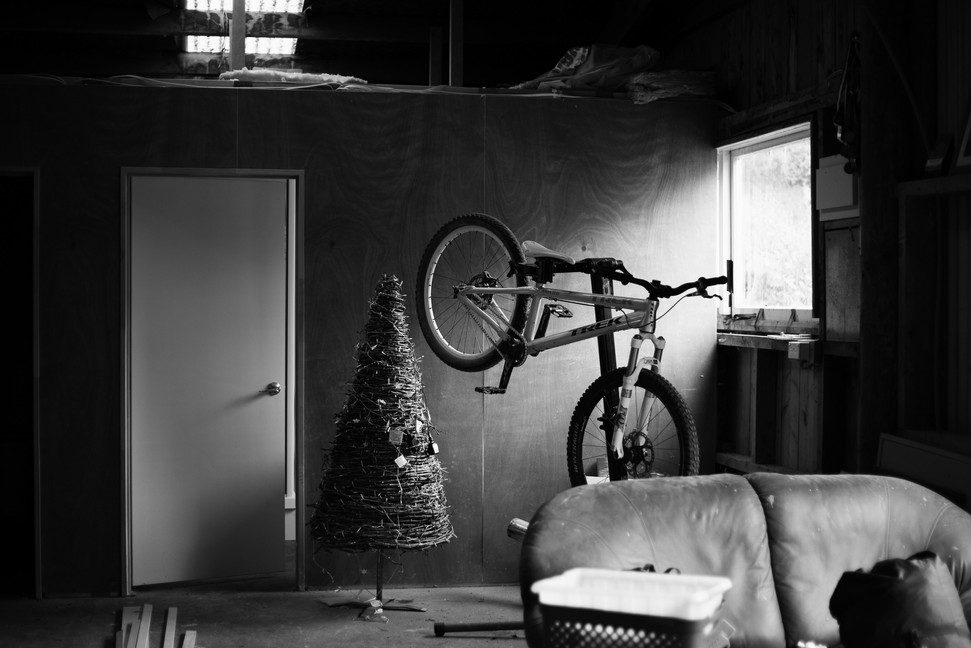
Justin is pro eMTB, and rides a Specialized Levo SL. Yes, he does have a pedal bike too, a Specialized Enduro, but these days most of his time is spent on the Levo SL. Justin reckons eMTBs have definitely established a place in the market. His Jentree property is straight up, so the Levo SL makes the climbs more fun and, when Justin gets home from his job as a builder, he can cut laps without anyone else having to shuttle him. What’s more, he can ride the descents swiftly, too. Of course, knowing a thing or two about racing downhill bikes helps, along with knowing trails on his property, but Justin explains that the Levo is much more planted on the trail, due to it being a little heavier. Put simply, it gets your centre of gravity a little lower.
“For me, the Levo SL is nearly the perfect bike,” Justin elaborates. “Being time limited with work, kids and trail maintenance, it simply means that when I can get out, I get twice as many laps in on the trails than when I’m on my regular bike. Being a lot lighter than the regular Levo, I find the dynamics while riding the Sl to be very similar to a regular bike (more playful and easier to manoeuvre). This, I believe, suits the rider who likes more technical trails and wants to ride with a feeling closer to their regular bike, yet also wants to get a whole heap more riding in for their time. I’d also like to add that my riding intensity doesn’t change, I still go flat out on the climbs like I have always done, it’s just that now I get there quicker.”
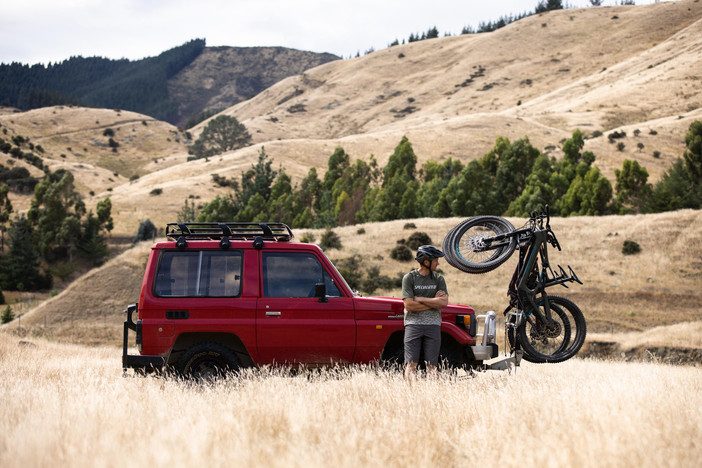
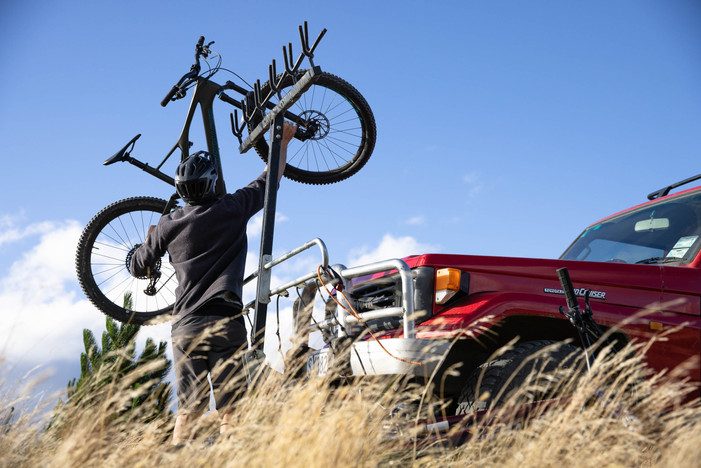
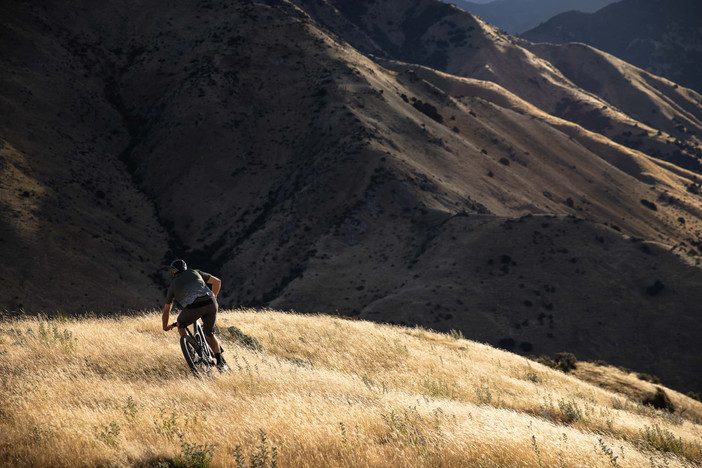
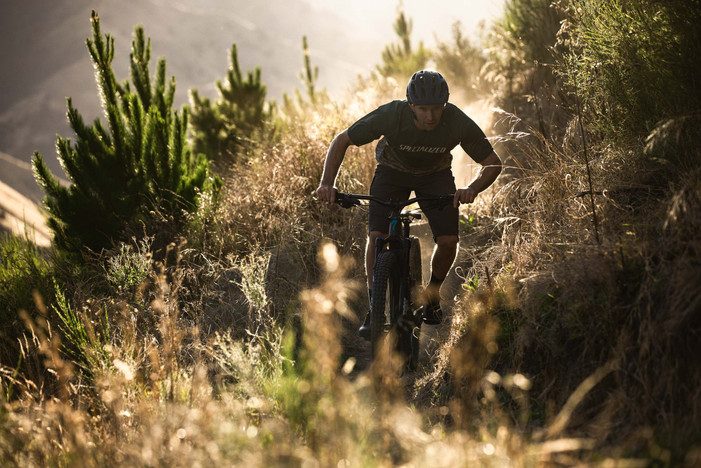
Justin spins some great yarns, but the conversation never wanders too far from his racing days. Of course, this is what I’m here to cover, but I could definitely spend more time just hanging out with him. He’s a top bloke who is also very humble, especially when you consider that his past is more decorated than most.
Let’s kick things off at the beginning, when he was first getting into riding, as a youngster. Mountain biking wasn’t on his radar initially; he was into motocross, but after some pretty heavy injuries, he moved away from it. It was at high school, Marlborough Boys College, where Justin was encouraged to give mountain biking a go. The youngsters would head out each Wednesday and explore the region’s trails and, on a few occasions, they headed to Jentree. There were a few groms who were keen riders, and they pushed each other – together, they headed off to races and events and started kicking ass.
Justin kept up the training and would ride from his place, across to Jentree (where he now lives), and cut laps until the evening light ran out. This was his daily routine: just getting his skills up and riding as much as he could. At 14, he entered his first Nationals on the West Coast. The hard, gnarly and technical track didn’t put him off and, after this race, he was hooked. As he started to race more, his skills improved and he took his first Junior National title at Jentree in the coming years. Oceania Champs followed, and soon Justin had hustled some businesses around Blenheim to support a trip to Europe: the good folk of the region backed him, and off he went. The plan was to hit the ground running with the World Champs and World Cup finals. Long travel and hectic schedules didn’t distract Justin at the World Champs in Kaprun, Austria, where he was 10th overall (racing as a junior) in his qualifying run, with a stacked field, and 20th in his race run. A week later, he was racing in Les Gets, France in the Open Men’s field (back then there wasn’t a junior class) throwing solid runs and placing well in the qualifier to eventually end up 40th in his race run. Justin returned home, but was yearning to head back again. The very next year, he did just that.

The plan was super loose, but Justin was determined to make it. Alpe d’Huez stands out for him that season, not only because he wore a skinsuit and placed 9th overall, but because he met Jason Marsh, a Kiwi living in Morzine who was hunting for different ways to do things (he would go on to work as Greg Minnaar’s mechanic and create MarshGuard fenders). At 17, Justin was still trying to work out what made him tick. Building anger before races was discovered by Marshy (Jason Marsh): he started annoying Justin before his run, and it worked. Being pissed off and getting aggressive before races made Justin ride harder. Justin recalls a time later on in his career, when he asked SRAM for a new derailleur and they wouldn’t help out. This fuelled his anger and was part of his process. “Everyone has their things, but learning this helped me early on. Also, work rate means a lot and you’ve got to have the want and desire. You’ve got to have the mongrel. Sometimes natural talent will be taken away by hard work,” Justin explains.
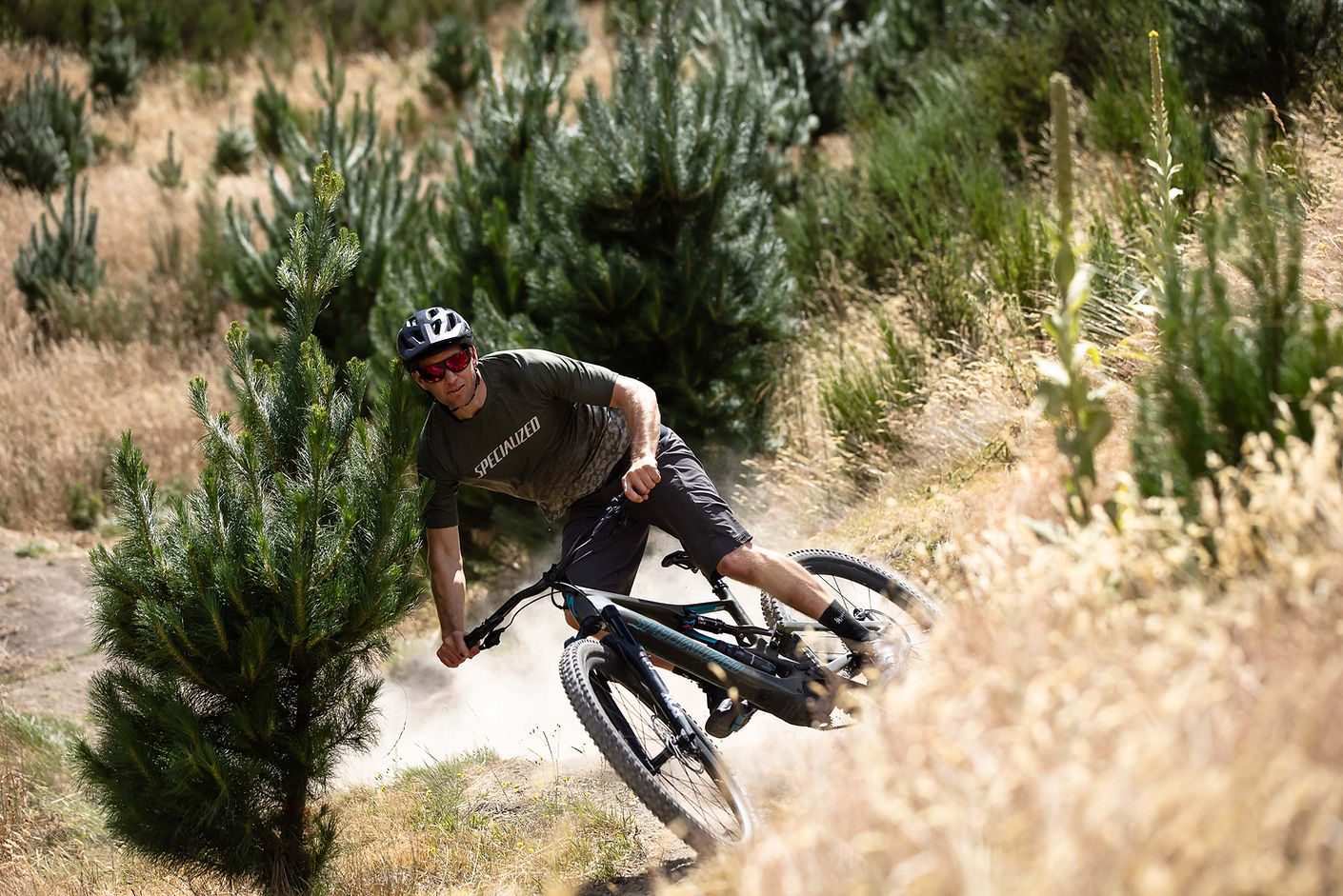
From showering in a bike wash, to sleeping in vans and doing just about whatever it took to get from race to race in Europe, built Justin’s character for the years to come. By 2005, he was riding for a small Swiss team, called the Suspension Centre Team, owned by Gery Peyer. It wasn’t a salaried position, but Gery gave Justin a place to stay as well as transport and a Turner to race on. This was the year Justin made himself known on the world stage, placing on the podium in USA and rounding out the year in 15th overall. After this, he started getting noticed, and signed with Martin Whiteley as a manager. Martin helped land a deal with Yeti for Justin’s 2006 season. The enthusiasm and stoke of making it was there but, unfortunately, it was short lived, with an injured shoulder during a 4X gate start in Spain, where he didn’t understand what the medical staff were saying. He punched on for the rest of the season before eventually getting surgery when he returned back home. The following seasons were much better and Justin snagged 10th overall finish in 2008. Martin then asked Justin to join a few team; Trek World Racing, with the likes of Tracy Moseley and Aaron Gwin. This was a well-oiled and organised programme. “You need to figure out what you need to do win – a lot of kiwis did well at home, but struggled with the stress abroad.”
After a few years riding at the highest level in downhill, Justin’s enthusiasm for it dwindled. The demands were high from constant training, intense races (with no room for error), hectic travel schedules and the stress of it all. He felt burnt out, threw in the towel and retired in 2012. Finished with racing, Justin returned home to start a building apprenticeship.
But, as it so often does, racing bikes soon lured him back in.
There was a new discipline on the scene: enduro. Justin was happy at home; he was completing his building apprenticeship and had been off the bike for a while, when Martin called and (eventually) convinced Justin to give this enduro racing a go. Relenting, Justin flew back abroad and, sure enough, finished 4th in his first race: that was enough to hook him. Shortly after that, Trek Factory Racing offered him a deal where he could race enduro and help out trackside with downhill rounds. It meant he’d be up at 5am training for himself, then helping out on the downhill racers, followed by a gym session in the evening. It’s not hard to imagine how this got a little too busy after a while, and Justin felt he couldn’t give it his all, so the following season he scaled back and focused solely on racing.
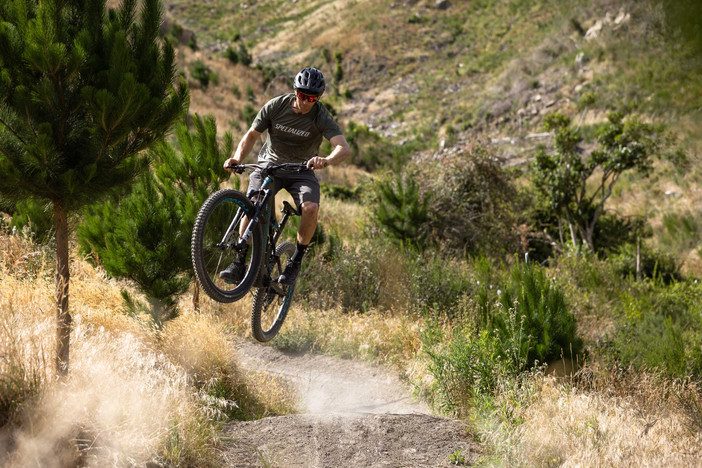
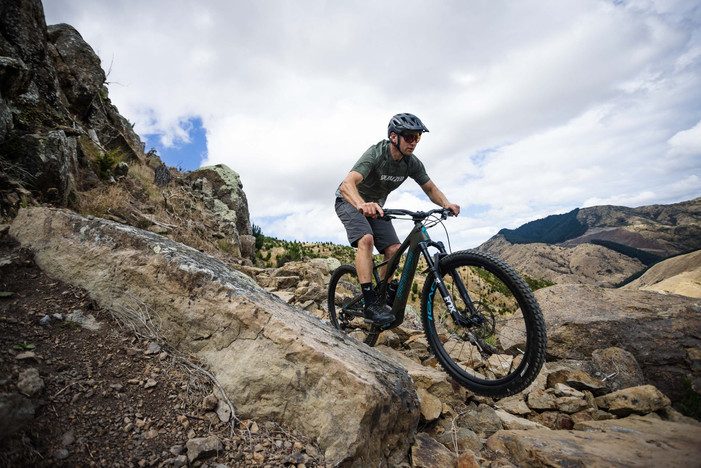
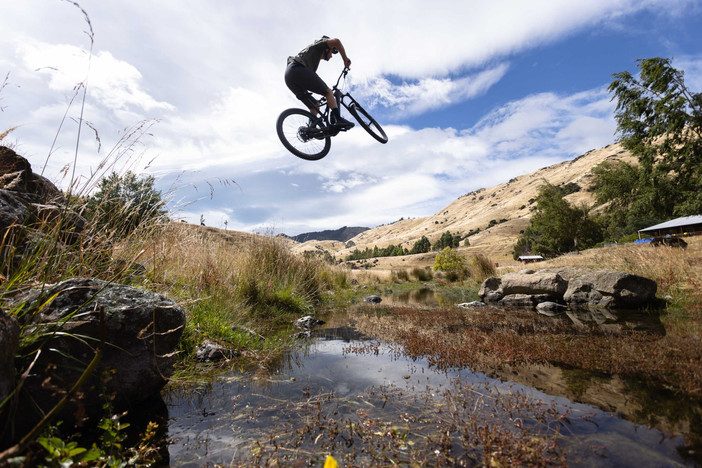
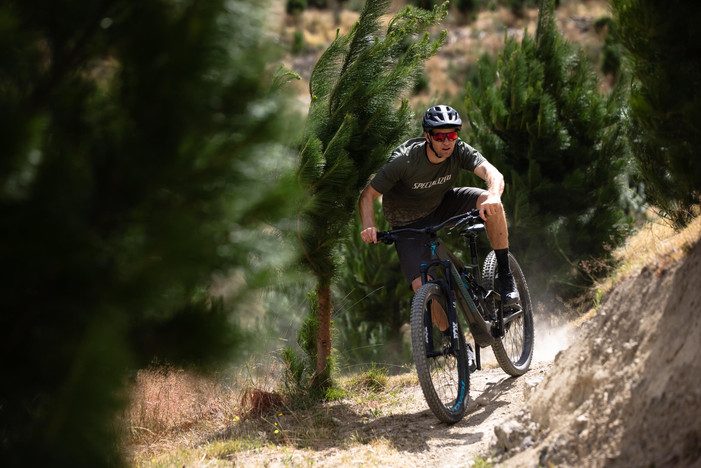
Justin says these were some of the best years of his racing career, on reflection. He had a great relationship racing with Tracy Moseley and there was great support with the team. The Trek engineers were also so invested in developing the best product for racing; they would use rider feedback as much as possible, and Justin and Tracy were behind the 29er movement before it was widely popular. They helped develop the Remedy 29er and the Slash 29er. And his racing? It was going really well, especially aboard the Remedy 29er - he took third overall in the 2014 EWS. That same year, Tracey won it. The next year, Justin’s focus was on taking the win. He won his first EWS round in Scotland and held the lead with the series but, luck wasn’t on his side when he crashed in Whistler, dislocating his shoulder.
There’s no doubt Trek were a massive part of Justin’s career, and it was hard for him to move away from the team. However, when you’re a sponsored athlete, the window of being able to earn highly is only open a short time. After some serious consideration, Justin signed with Canyon in 2016. Trek had the opportunity to match what Canyon offered, but couldn’t, and told Justin it was too good to turn down. He still had the mongrel and fight but, on the first Canyon training camp, he caught glandular fever. In order to fully recover he needed to return home and be off the bike - for at least six weeks. The first few weeks, Justin could barely make it off the couch, a concept which was not only hard physically, but mentally too. The next few years didn’t go his way, due to health reasons and Canyon not moving with the times in regards to having a 29er race bike option. The time came to retire, again, and head home to complete the building apprenticeship - Justin was fed up with the bike. “Reflecting on my career, everyone is driven differently. For me, I was focused on racing and missed most of the social occasions. You have to give it 100%. Find where you are – you can try and change yourself to fit a model, but you’ve got to see what’s best for you.”
Justin was back on the tools, building and living in Blenheim, when he caught wind that the Jentree property was for sale. This was enough to ignite his passion for riding bikes again. Justin, his wife Victoria and their two kids, Annabella and Luca, moved in.
“Jentree got its name from the previous owners, John and Jenny Meek. John was referred to as ‘Track Man John’, and was the creator of the cross country course. When Victoria and I bought it off them, we decided to keep the name as a tribute to John and Jenny’s hard work. The original cross country was, at the time, more technical than most other courses, so it developed that reputation. My first ever mountain bike race was an XC here, and it had a climb so steep you had to shoulder your bike and climb up it by foot. It was so cool to see something like that in a course, you don’t really see that often anymore. John loved naming sections and locations; the DH was called The Mangler, true to its name it also delivered. Digger-built trail didn’t really exist at this time, so the closest we had was my dad pushing a few cuts in the hill with a bulldozer. These would be named “Leov Lane”, and the pond at the top of the hill was also built by my old man and named Gladys’ Pond - after John’s mother. There were definitely a few degrees of connection to this property for me, and being able to purchase it from John and Jenny really brought it back full circle.”
The place needed a bit of work, and the trails had been left for years, but Justin just chipped away on things at a slower pace. Justin takes pride in the property, and the Jentree trails are unique. It’s clear to see that there’s plenty on for Justin these days, but he gives me ample amounts of his time. Heck, we even stop at one point when we’re shuttling the trails so he can offer me some skills coaching. Yep, he coaches mountain bike skills too – well, there’s not much he doesn’t do! The tips he gave me have made my riding a whole lot better, and I’ll be giving him a call again for sure.
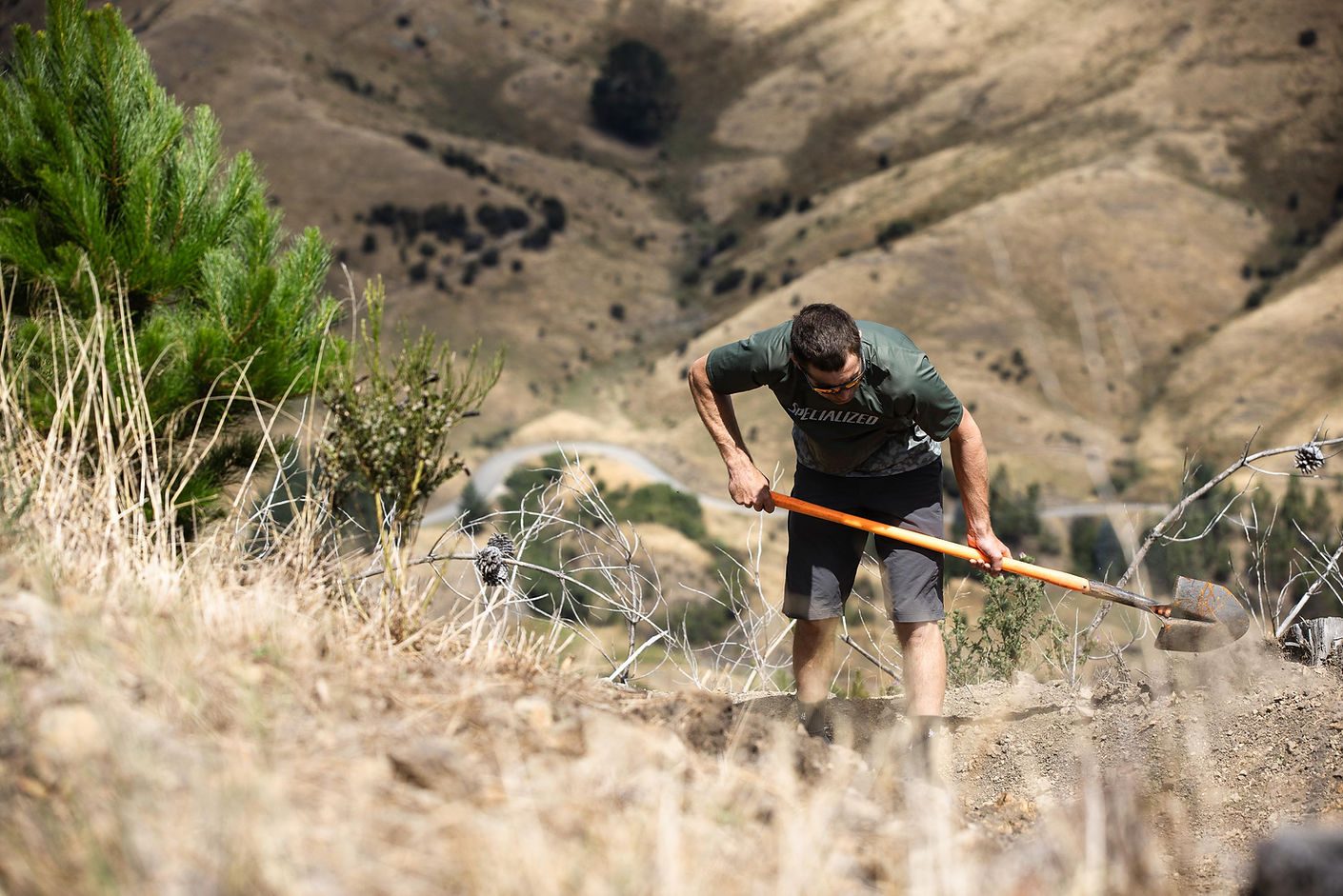
Justin’s wife, Victoria, welcomes me into their family home and I quickly learn that she’s his most dedicated supporter and has been by his side throughout his whole career. It’s clear to see that Justin’s performance at the highest level has been backed by Victoria holding things down on the home front and, importantly, keeping things balanced. Of course, there’s been some rocky moments, but Justin says they’ve learnt over the years: it’s not easy when you’re pro, often miles from home, focusing on riding bikes - sometimes there’s not much room for anything else. For Justin and Victoria, years of phone calls progressed to Skype calls and seeing how best to work a long distance relationship.
It takes one hell of a driven person to pursue a sports career at the highest level and, without doubt, Justin is one of them. But, his humbleness remains, even after being one of our most decorated mountain bike riders. It’s clear to see the lessons learnt from racing abroad are applied to many aspects of his current life. His support network is solid and his passion for the sport, and giving back to the next generation, is what stands out.
Words: Liam Friary
Images: Henry Jaine
Story: A Decade Dedicated to Women
Even the strongest native New Zealand tree needs a supportive environment to flourish at the start, and many burgeoning women mountain bikers are no different. Creating this type of environment was the incentive behind Revolve, a “down to earth” women’s cycling club that caters to women of all skill levels, who want to ride a bike!
Founded in 2009, Revolve was the brainchild of two local bike enthusiasts – Ash Peters and Marjolein (MJ) Cook – who found there was a severe lack of women riding the trails and racing in local events. With a little prompting from supportive local bike shop owner Nigel Welch, they decided to do something about it. “What started as a casual weekly ride quickly grew and, as more and more ladies started to turn up, we thought… maybe we’re onto something,” says Ash.
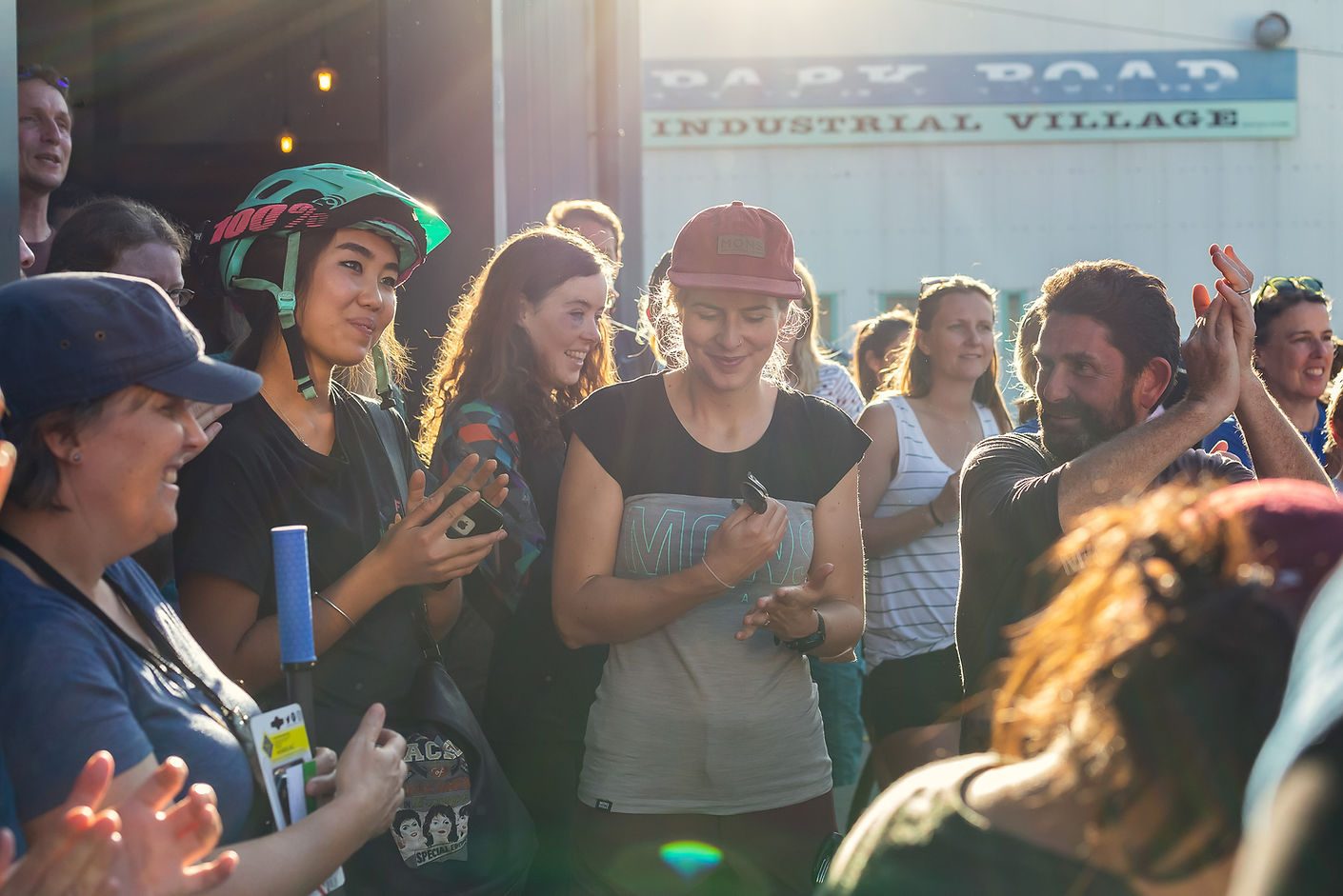
With the simple mission to get more women on bikes – be it mountain or road – Revolve’s popularity grew quickly and captured the hearts of many – both guys and girls. By 2012, over 1000 people had signed up for the ‘Weekly Revolver’ e-newsletters to stay in the loop with the weekly rides, events, and skills and maintenance clinics.
“Given the response and commitment we received fairly quickly, it was hard to believe there wasn’t a club before,” says Ash. “They say ‘build it and they will come’ and, with Revolve’s inception, I’ve had countless women reiterate this saying – whether they were too nervous, unacquainted with the trails or not keen to ride with their partners, these women were looking for an outlet and, through Revolve, found a club to call their own.”
Fast forward ten years and Revolve is much more than a two-woman band – the committee of nine, headed by co-presidents Meagan Robertson and Abbie Bull, continues to be the driving force behind a club that remains committed to empowering the women of Wellington, and ideally beyond, through their love of cycling.
Keeping the wheels turning
Over the years, Revolve has provided its members with a wide variety of activities and benefits; bike maintenance classes, women-only events, trips away, subsidised skills courses, quiz nights, shuttle days, and more. While the options vary and evolve from year to year and committee to committee, one core offering has remained constant since Revolve’s inception in 2009: its guided weekly road and mountain bike rides.
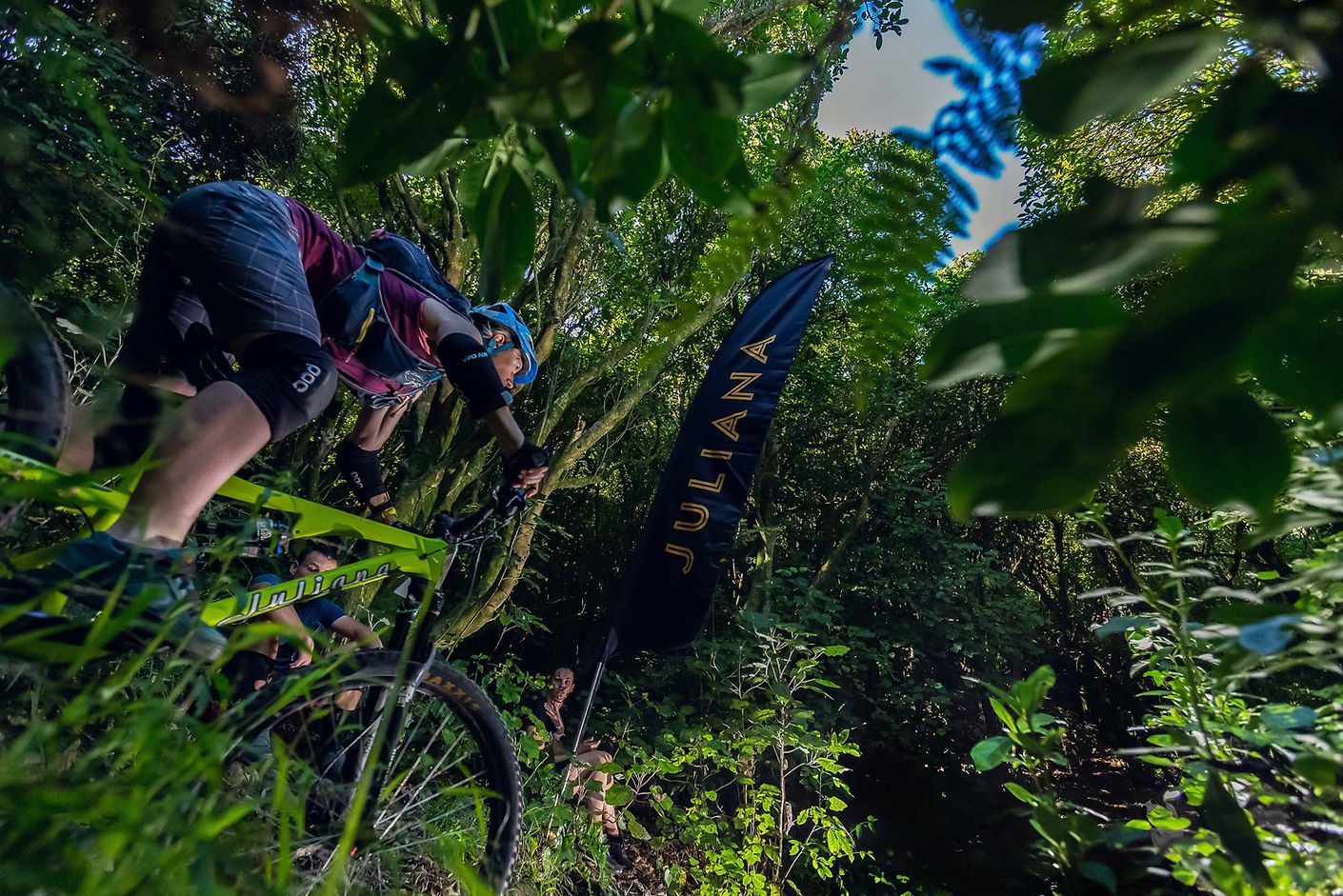
“No matter what else is going on, be it event preparation, first aid course organisation or injured Ride Guides, Revolve Ride Guides always pull together to ensure consistency through its ride schedule,” says Dee Skilton, who has been on the committee as a Ride Guide coordinator and Trails Liaison for the past four years.
With road rides every Saturday morning, and mountain bikes rides every Thursday evening (every second week in winter), Revolve members always have something to look forward to. Ride Guides also organise additional rides beyond the weekly offering, such as the Weekend Excursions led by Ride Guide Nicole Hoy and the Wainui Weekend Rides led by Dee, which draw good crowds and have become much-anticipated calendar staples.
“If our rides are our constant, it’s drawn from the strength of our Ride Guides, and a key part of Revolve is ensuring we have enough Ride Guides who are trained and passionate about our mission. They are the face of Revolve, and the ones who influence whether those who turn up for rides end up coming back – it’s a big responsibility!”

To ensure the Ride Guides feel confident and are well prepared to lead rides, Revolve organises and funds Ride Guide training, first aid training and skills courses, as well as bi-annual get togethers and an appropriate thank you at the AGM.
For many of the Ride Guides, like Weekend Excursion extraordinaire Nicole Hoy, it’s a way to give back to a club they feel passionately about. “Nine years ago I found Revolve. I loved riding a bicycle and wanted to become a more confident mountain biker. Ashley and MJ were amazingly patient with riders like myself, and their love of mountain biking was infectious. My confidence grew, as did my list of bike riding women friends. I've met some of my dearest friends through Revolve and am eternally thankful for that. It’s a big part of why I continue to Ride Guide – I want to support this unique and welcoming community of riders.”
More than just riding
While Revolve’s initial goal was to get women on bikes, the lack of women riding was particularly obvious at the start line of an event, so building women’s confidence in attending events became another club aim early on.
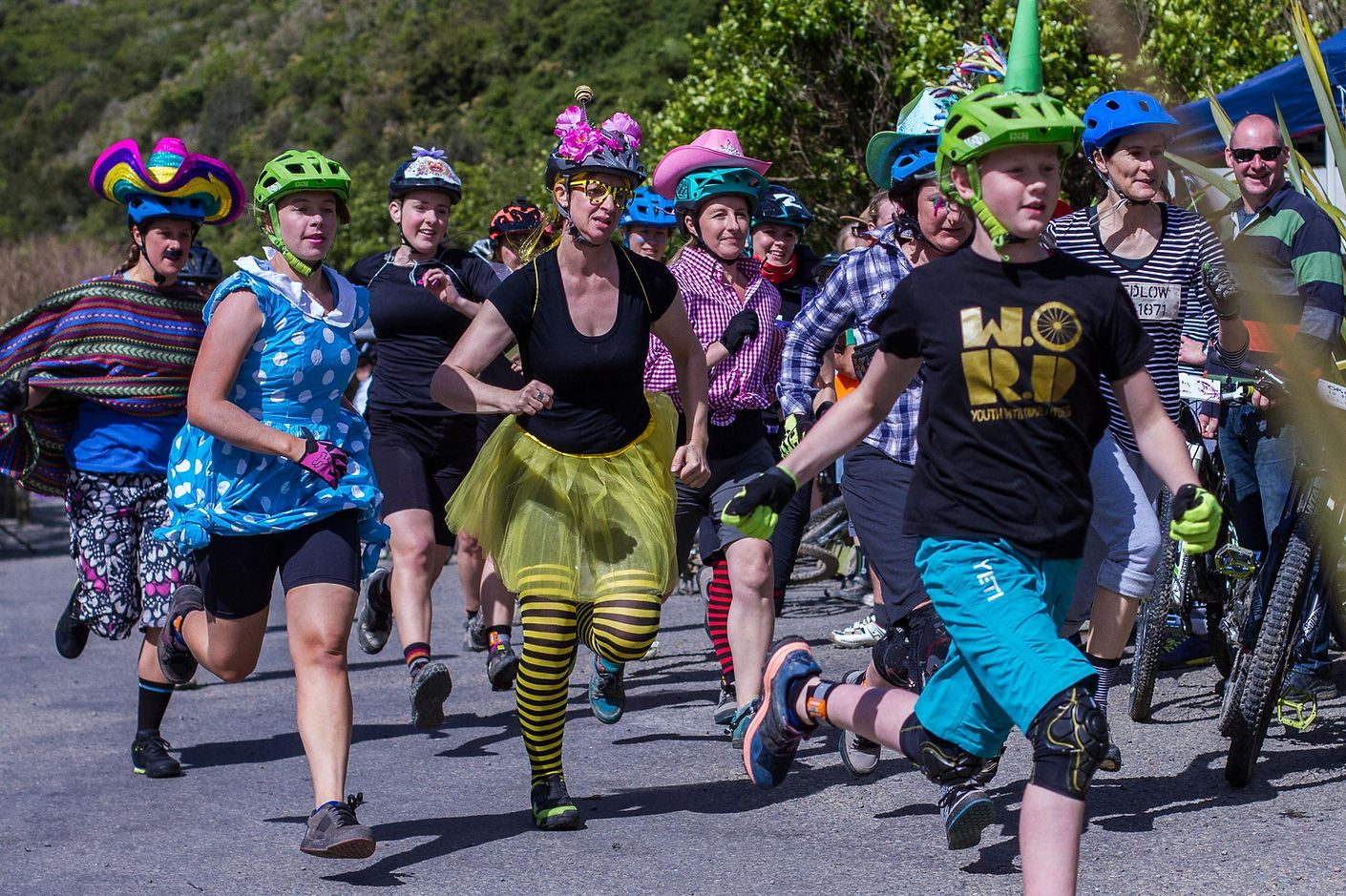
Women of Dirt was the club’s first event and has arguably become its most notorious. Designed as an inclusive and fun six-hour relay – complete with baking and best dressed prizes – the aim is to encourage women to try their hand at racing in a comfortable atmosphere. “It reiterates our mission, which is to build confidence in women of all abilities and skill levels through their enjoyment of riding,” says co-president Abbie. “Women of Dirt is unique in that it encompasses an awesome blend of fun and competition. With girls aged seven through to women in their late fifties – some that have ridden a handful of times and others that ride several times per week – it proves an opportunity to get together, ride bikes and meet like-minded people.”
With the ninth Women of Dirt event plan underway, co-president Meagan – who took part for the first time in 2011 – says it’s been incredible to see the event grow over the past eight years. “On my first-ever Revolve ride, myself and another newbie – now one of my closest friends – were talked into putting together a team for Women of Dirt. It was such an amazing way to find out what Revolve was all about – the people were friendly, the biking was fun and the atmosphere was almost electric.
“For the next few years, I rode and helped organise with more new friends, and since taking on the president role four years ago, I’ve been mostly organising – but always taking time for a lap or two!”
The event, which took place at Makara Peak for the first five years, became so popular that the committee decided to move it around to help give women exposure to trails further afield – in 2017, it was held at Wainui Trail Park and last year at Belmont Regional Park.

Meagan says the decision hasn’t come without its own challenges. “It’s already challenging to convince women to take part in an event at all, even when it’s on home turf, which is Makara for a lot of people. Convincing them to give new trails a go takes a lot of encouragement, and a lot of pre-rides.” Looking to cater for a wider variety of riding abilities, and expose women to a different racing format, the Super V was born in 2012. Held at Polhill Reserve, the pedally downhill race gives women a chance to get shuttled to the top of stunning singletrack that can rarely be ridden at speed due to its dual-use status and popularity.
“It’s similar to Women of Dirt in that the environment is incredibly supportive and friendly, plus you get time to chat to the other women on the way up in the shuttle. It feels a bit more like a race though because you start one by one, and you don’t want to let people pass you,” says Tina Frew, who was convinced to join in after only a few weeks in Wellington, and has participated every year since.
Both events are organised wholly by the committee, who continue to refine the processes around them.
“Where we see areas for possible improvement, we make a change,” says Meagan. “Over the past four years, our focus has been on ensuring volunteers feel valued, sponsors feel appreciated and the atmosphere at the race is welcoming and fun. It’s a massive job organising these events, and we’re lucky to have such an incredible committee, and race day volunteers, making it happen.”
Friends of Revolve
In addition to its two staple events, the Revolve committee also organises a Christmas party, an AGM and an AGM Shuttle Day for Ride Guides; members and volunteers, and Friends of Revolve are welcome at all three events.
“While Revolve is all about empowering women, it wouldn’t be as successful as it has been without support from those outside the club, who we call Friends of Revolve,” says Abbie, whose membership research led the club to introduce an actual Friends of Revolve membership earlier this year.
“Every committee member and Ride Guide has people in their life who supports their volunteering, and many of our event volunteers are men who support Revolve’s mission. It’s so close to our hearts that we acknowledge a Man Friend of the Year at every Christmas party.”
Why women only?
Much like the hashtag #ifyoucanseeityoucanbeit, Revolve caters for all women, particularly those who are nervous about “not being good enough”. In any given week, Revolve receives a handful of emails from women wondering if they are “good enough” to join a ride and, nine times out of ten, said women are more than capable of joining the ride they’re enquiring about.
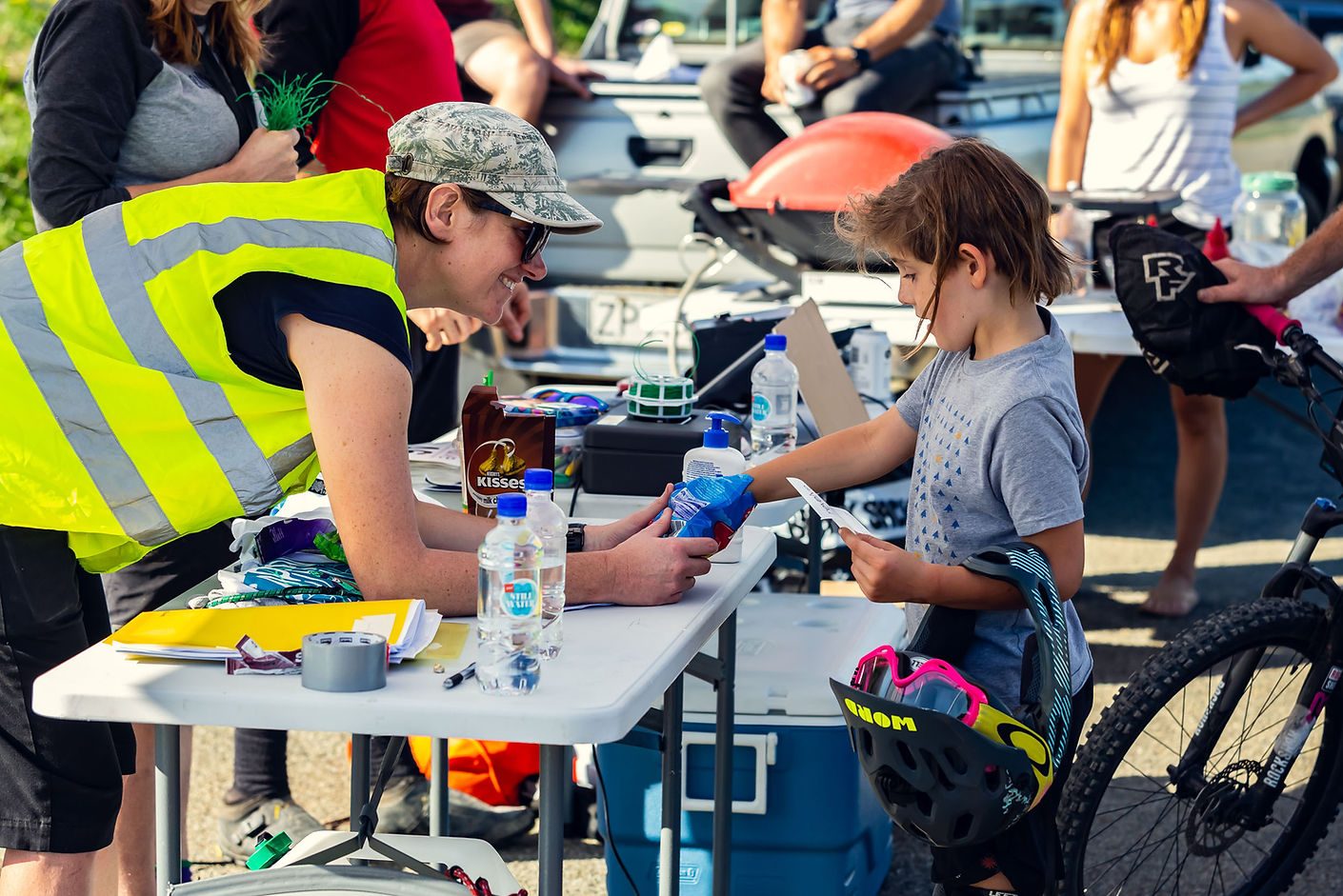
Committee member Sarah Murray, who has now been the Roadie Ride Co-coordinator for the past three years, admits Revolve’s ‘no one left behind’ policy was a major drawcard for her. Two Coast to Coasts, an Ironman and few half Ironmans later, she recalls her nervousness vividly.
“I joined Revolve to learn how to ride a road bike and meet some new people. I looked around at quite a few riding groups but was pretty intimidated by the sound of most of them, while Revolve seemed so welcoming and forgiving of out-of-their depth rookies like me. My first ride was led by Leonie and despite the fact we had to stop half way up the hill to pump up my tyres (I didn't know you needed more than 40psi in them....) she was so friendly and encouraging - after that I was hooked!”
Words: Meagan Robertson
Images: Dan Sharpe


